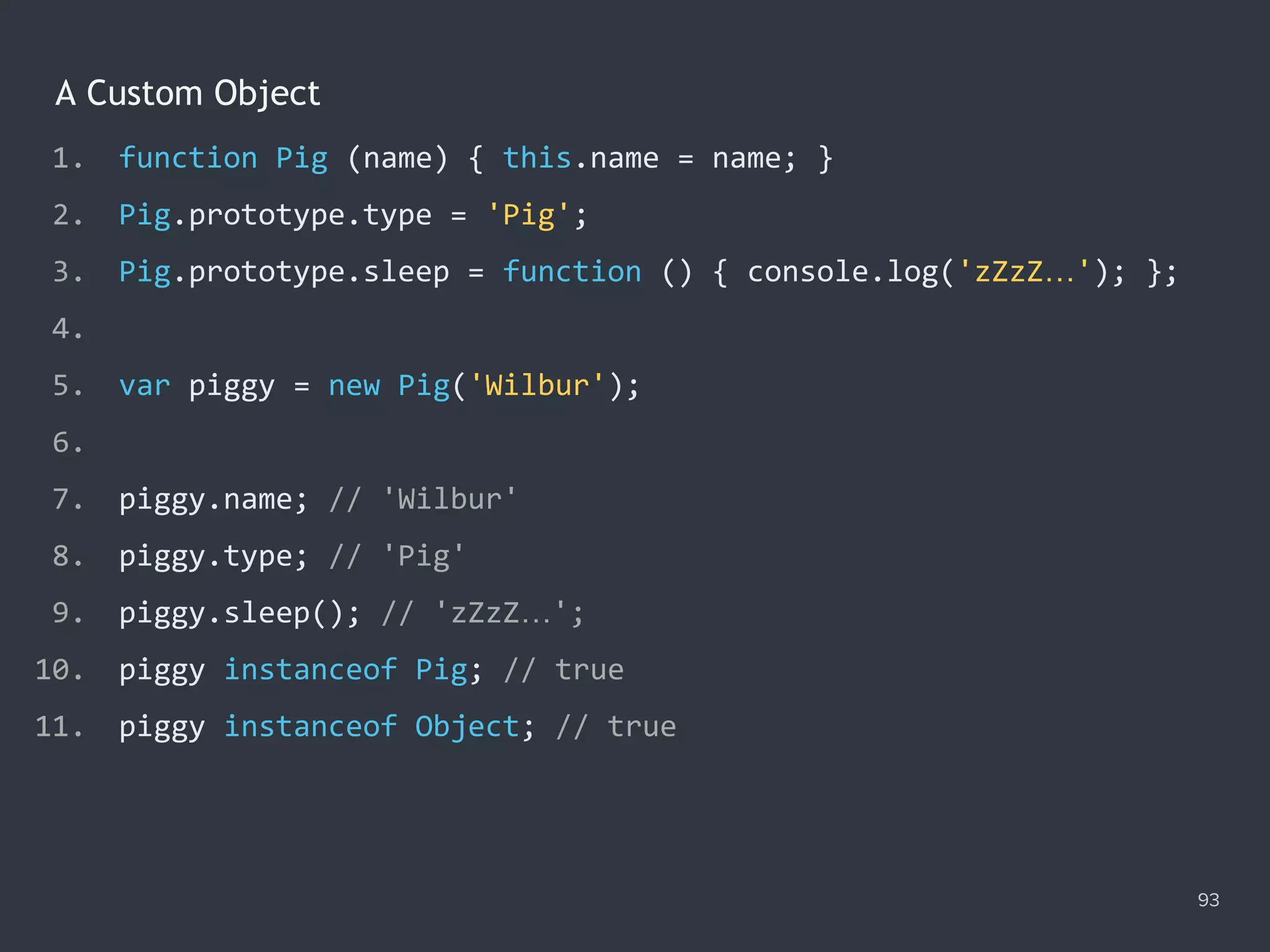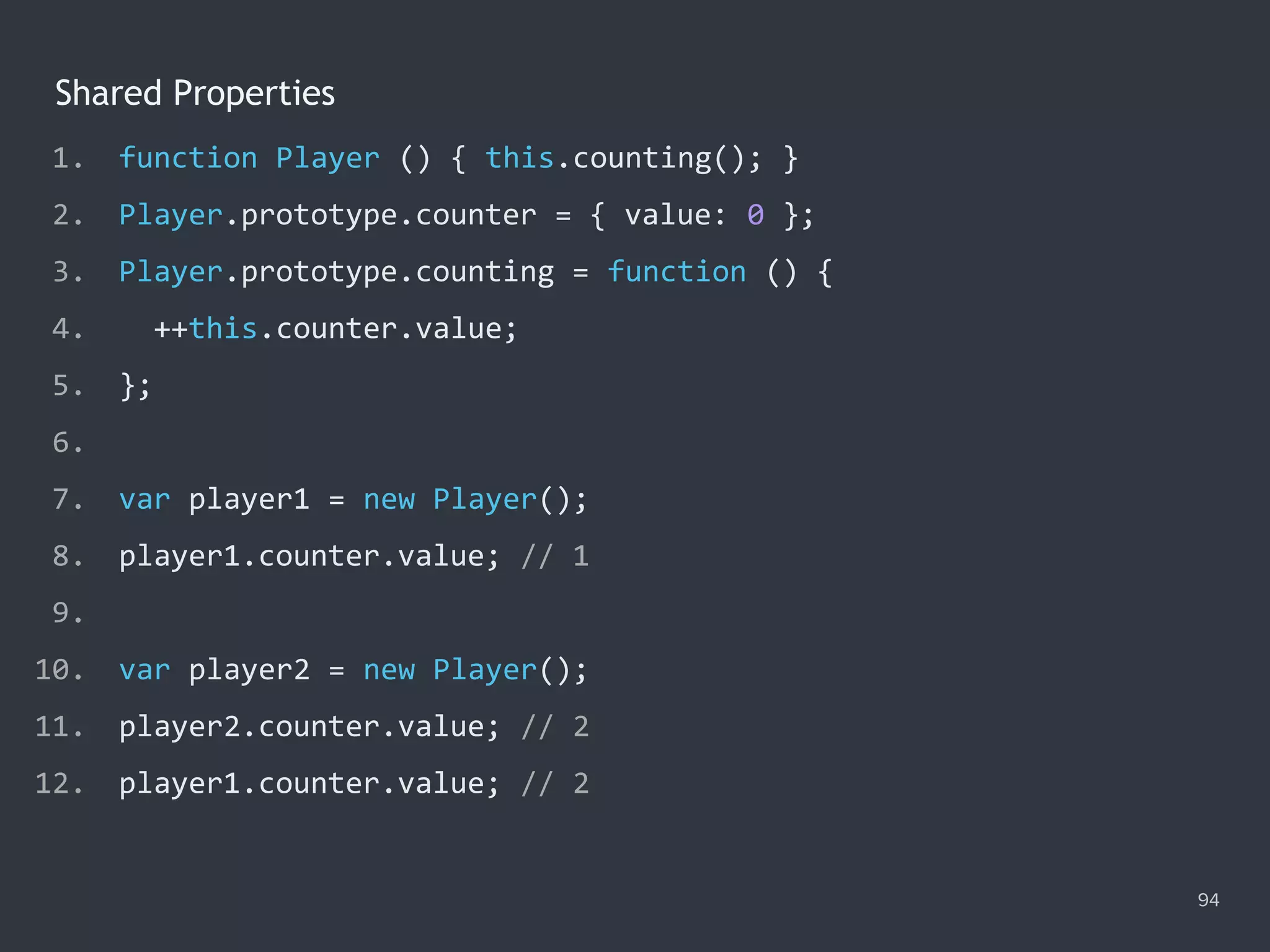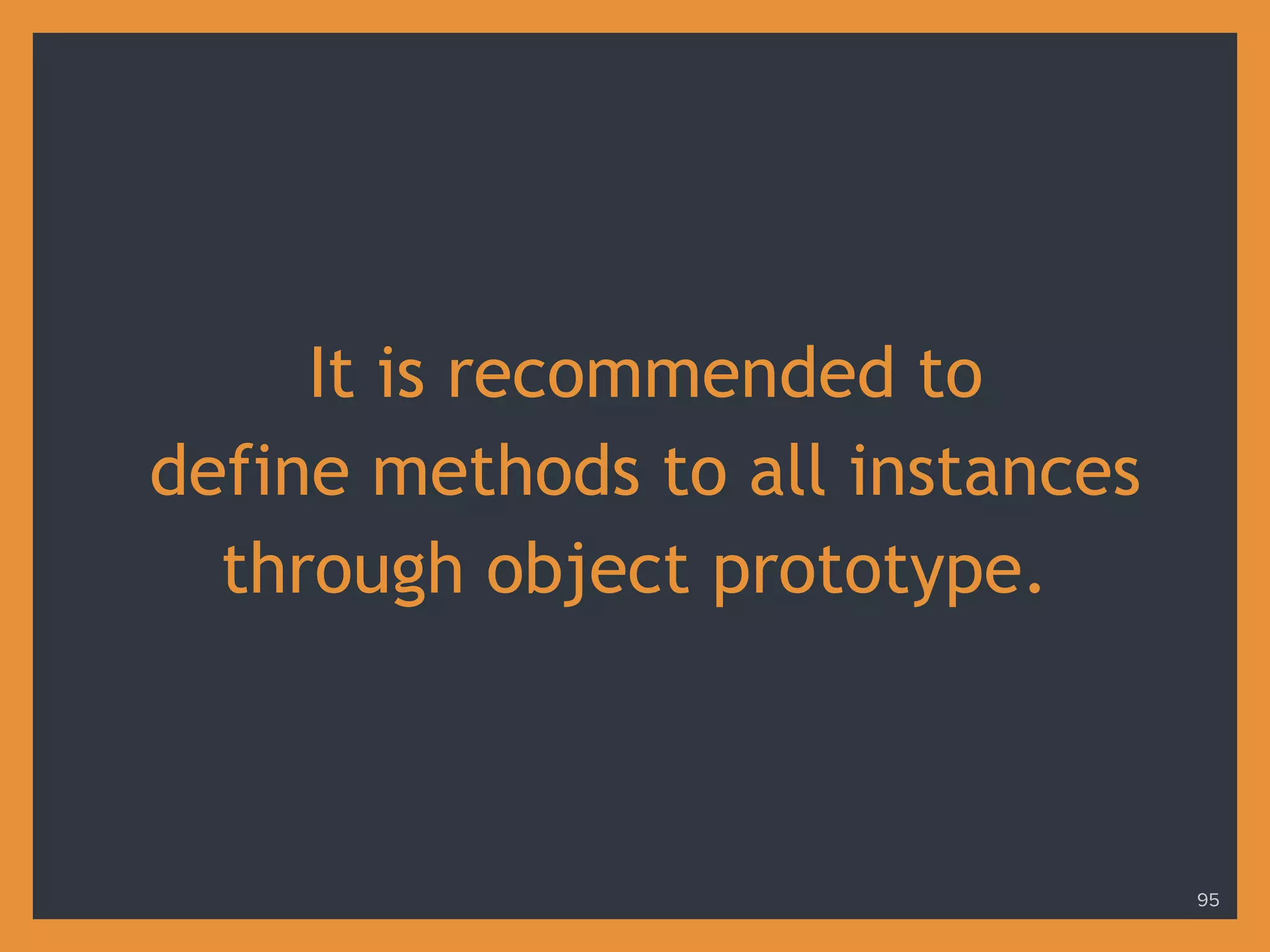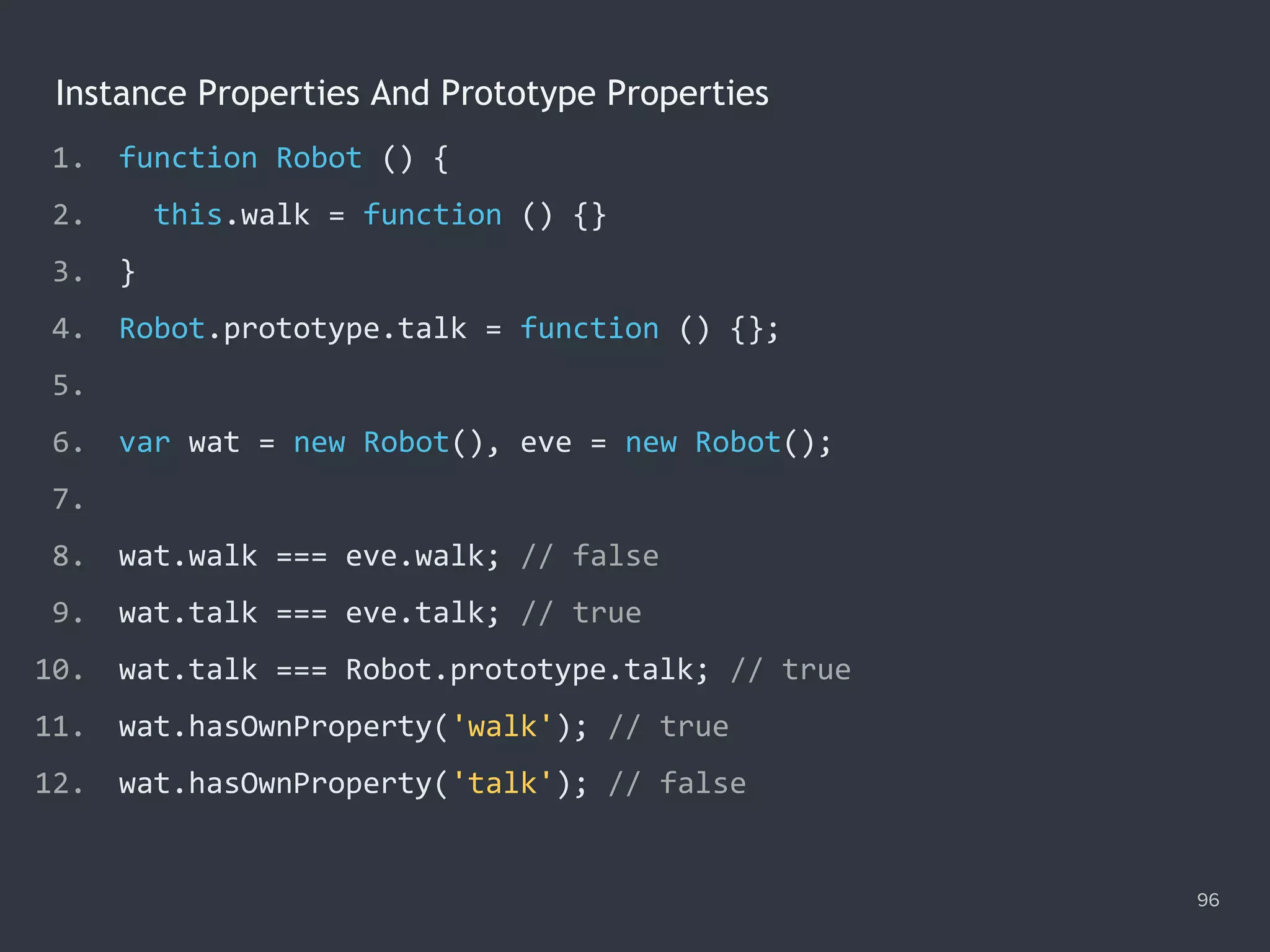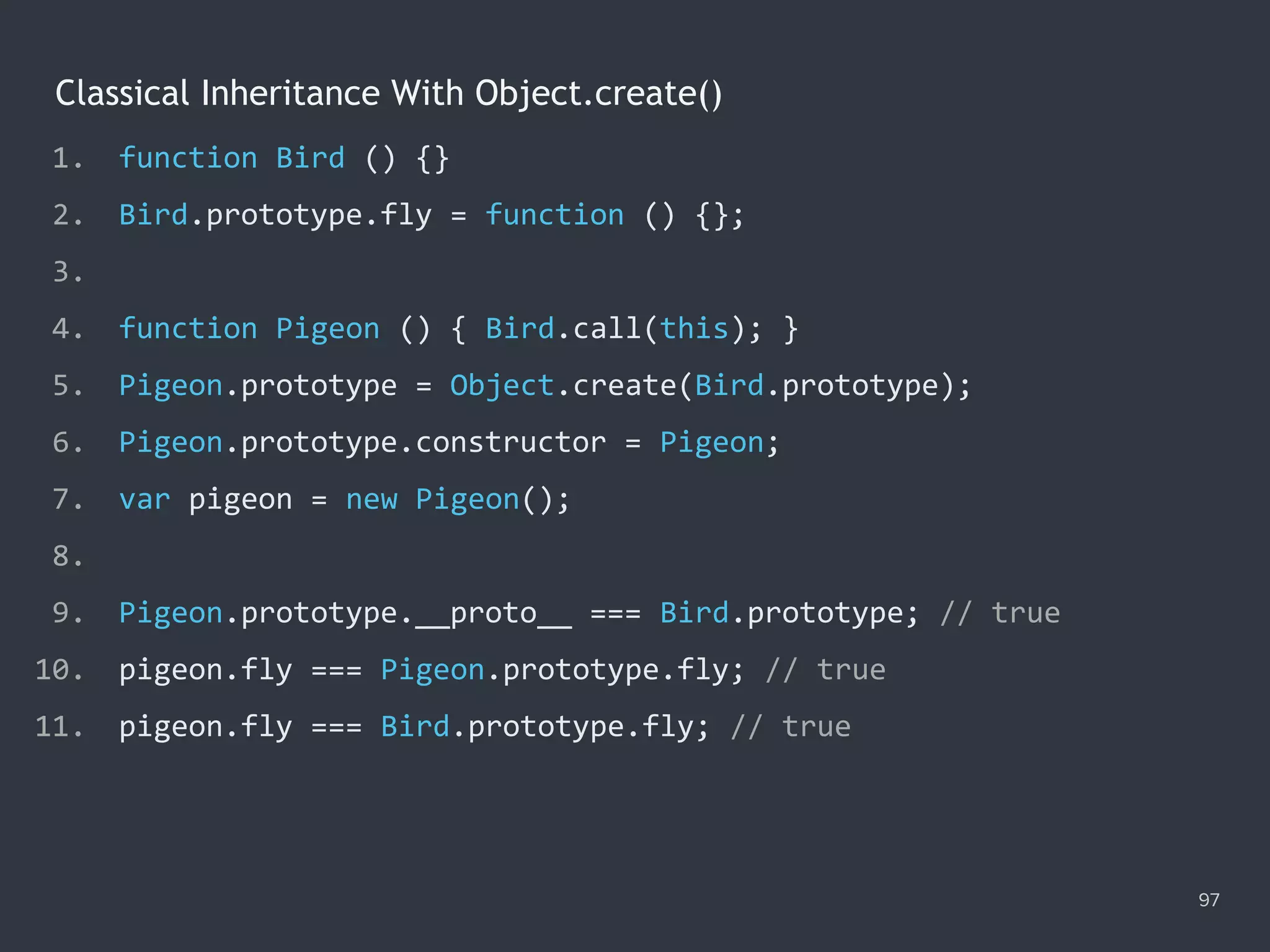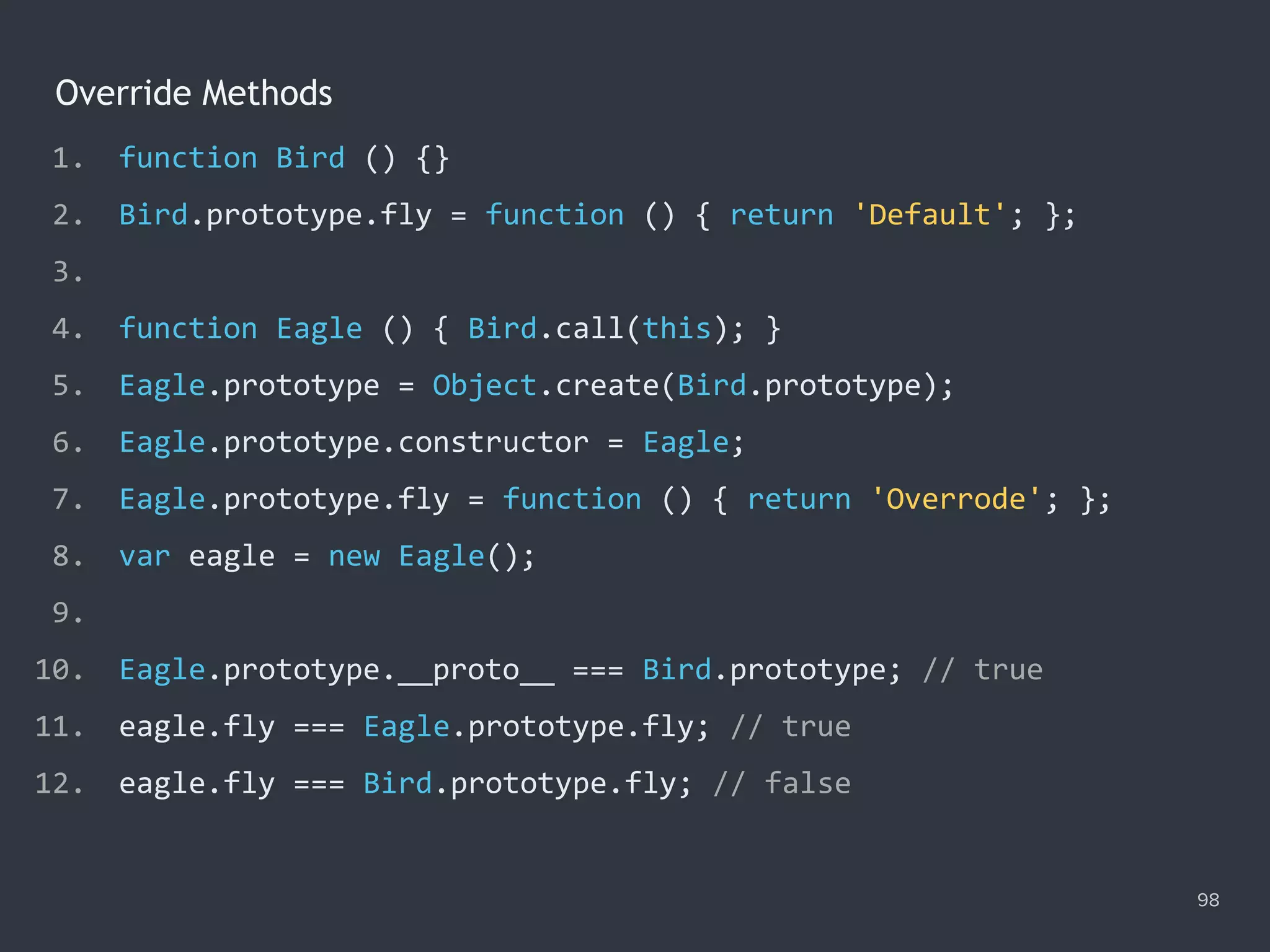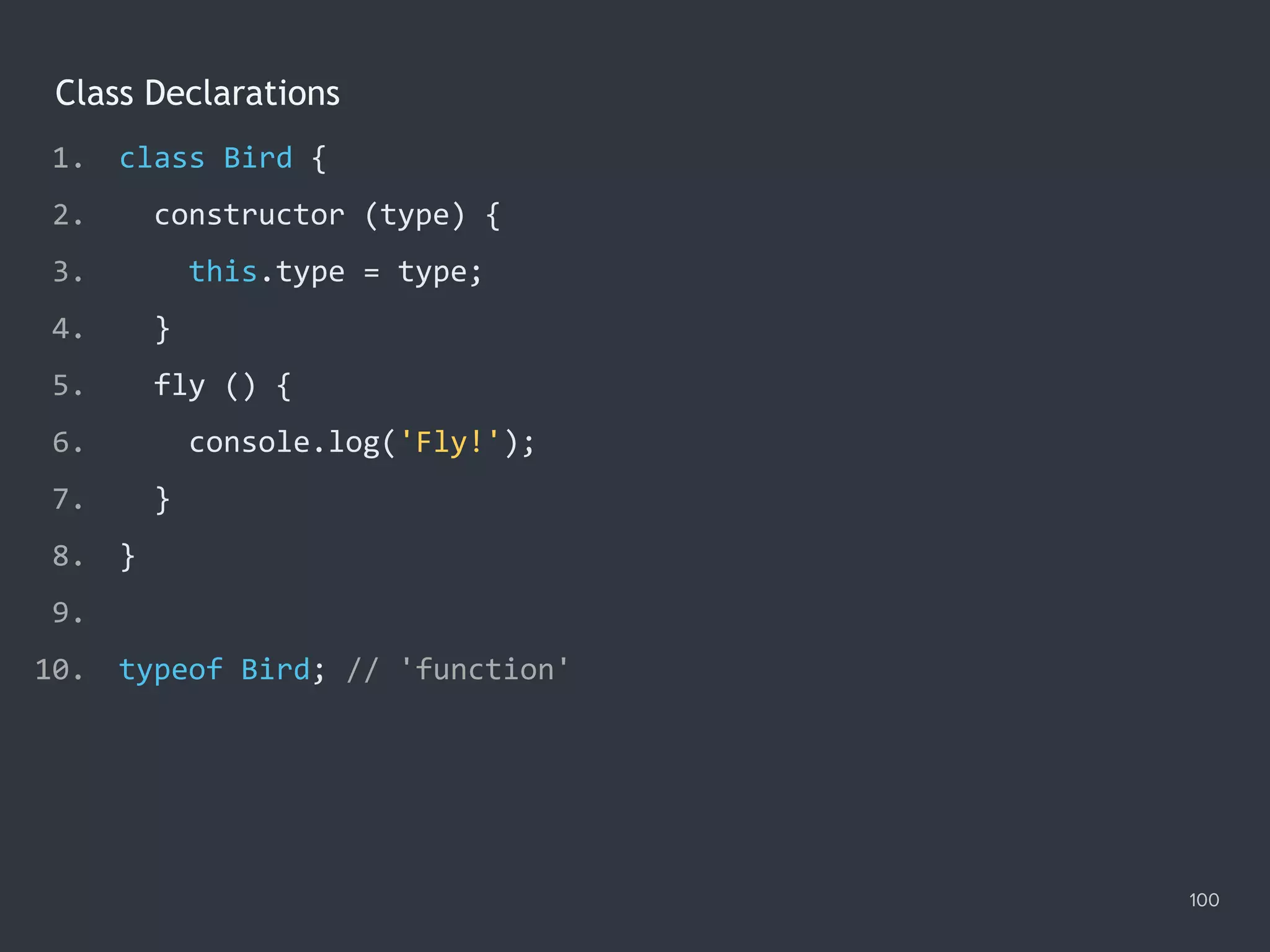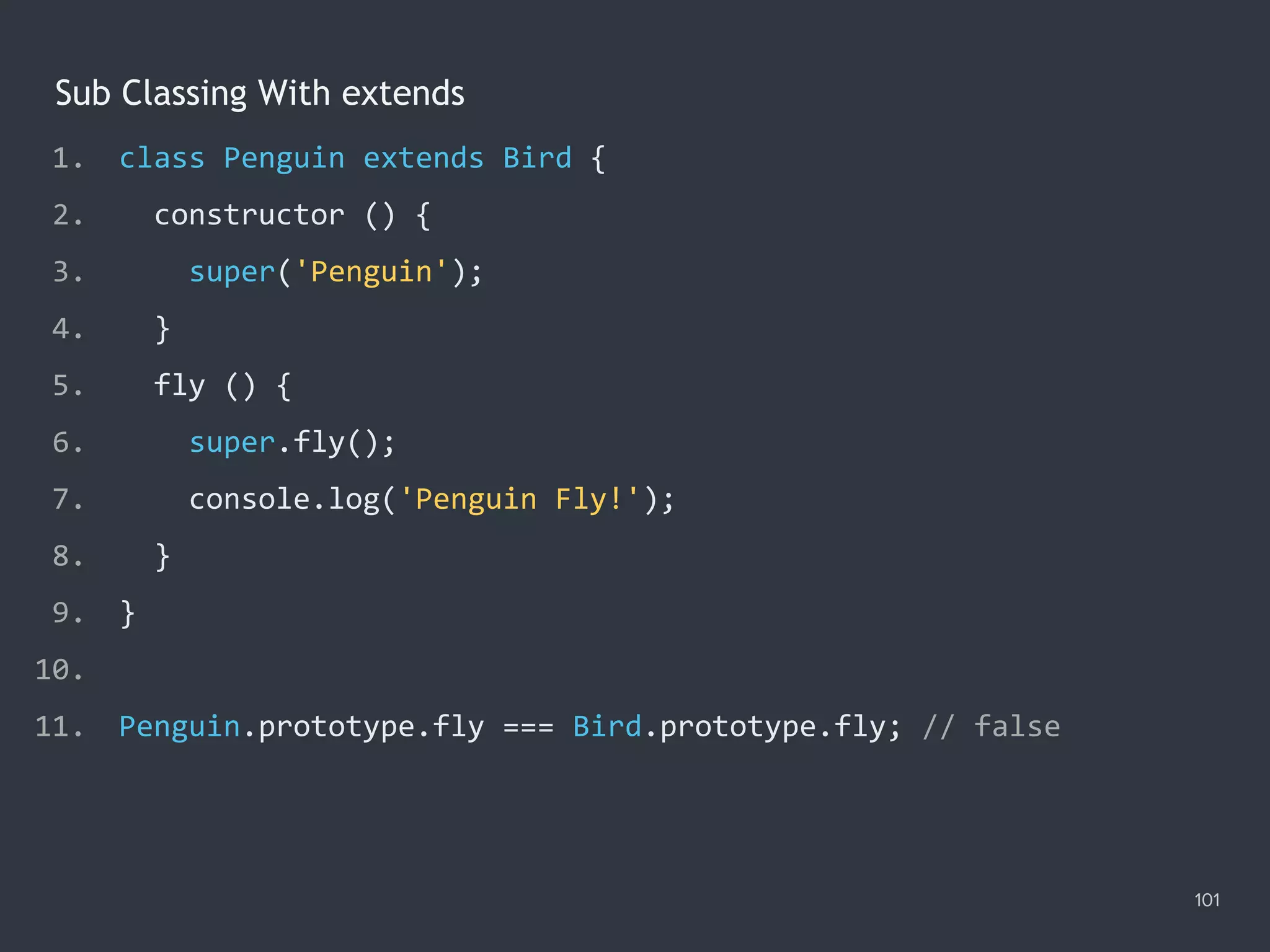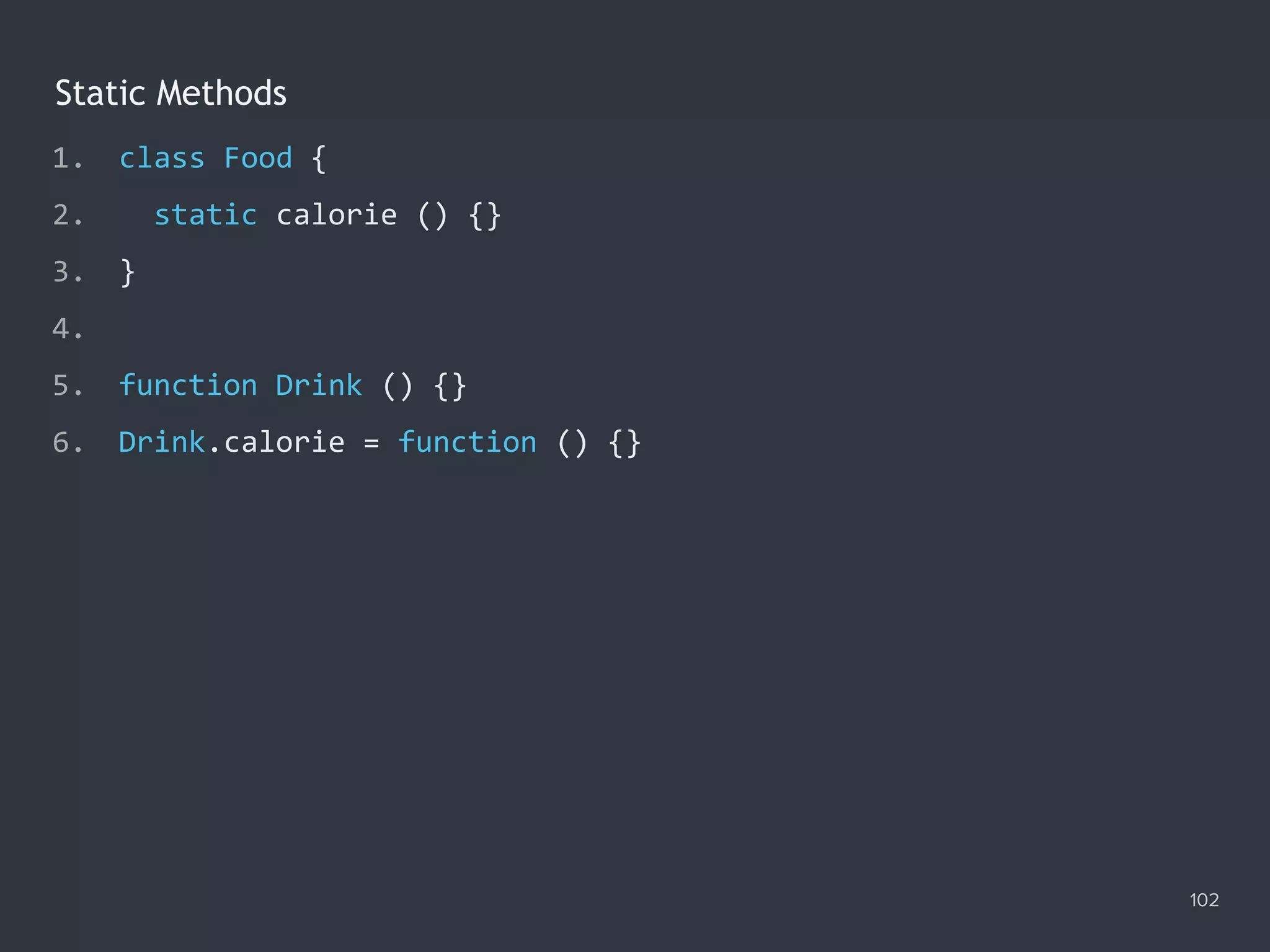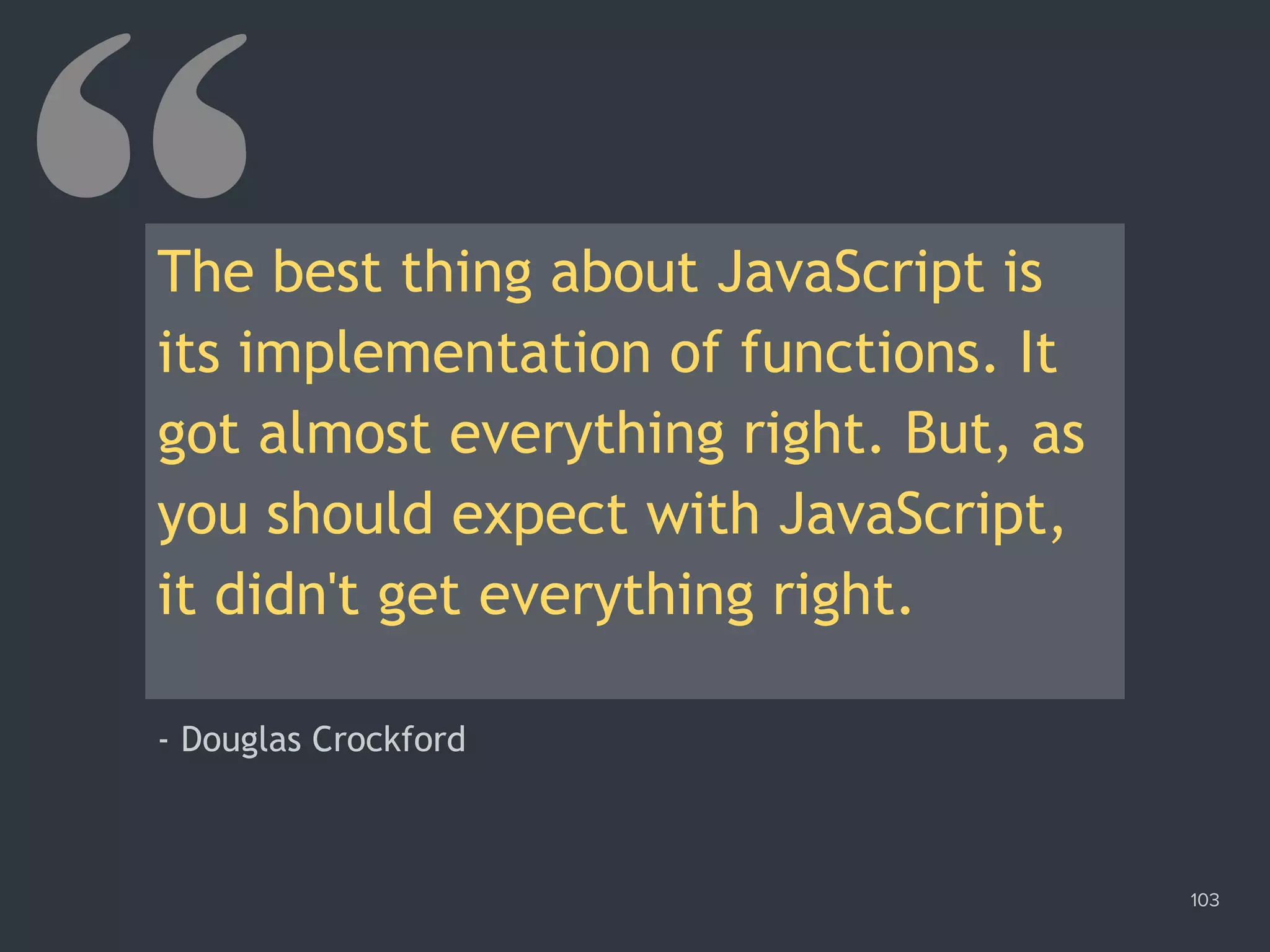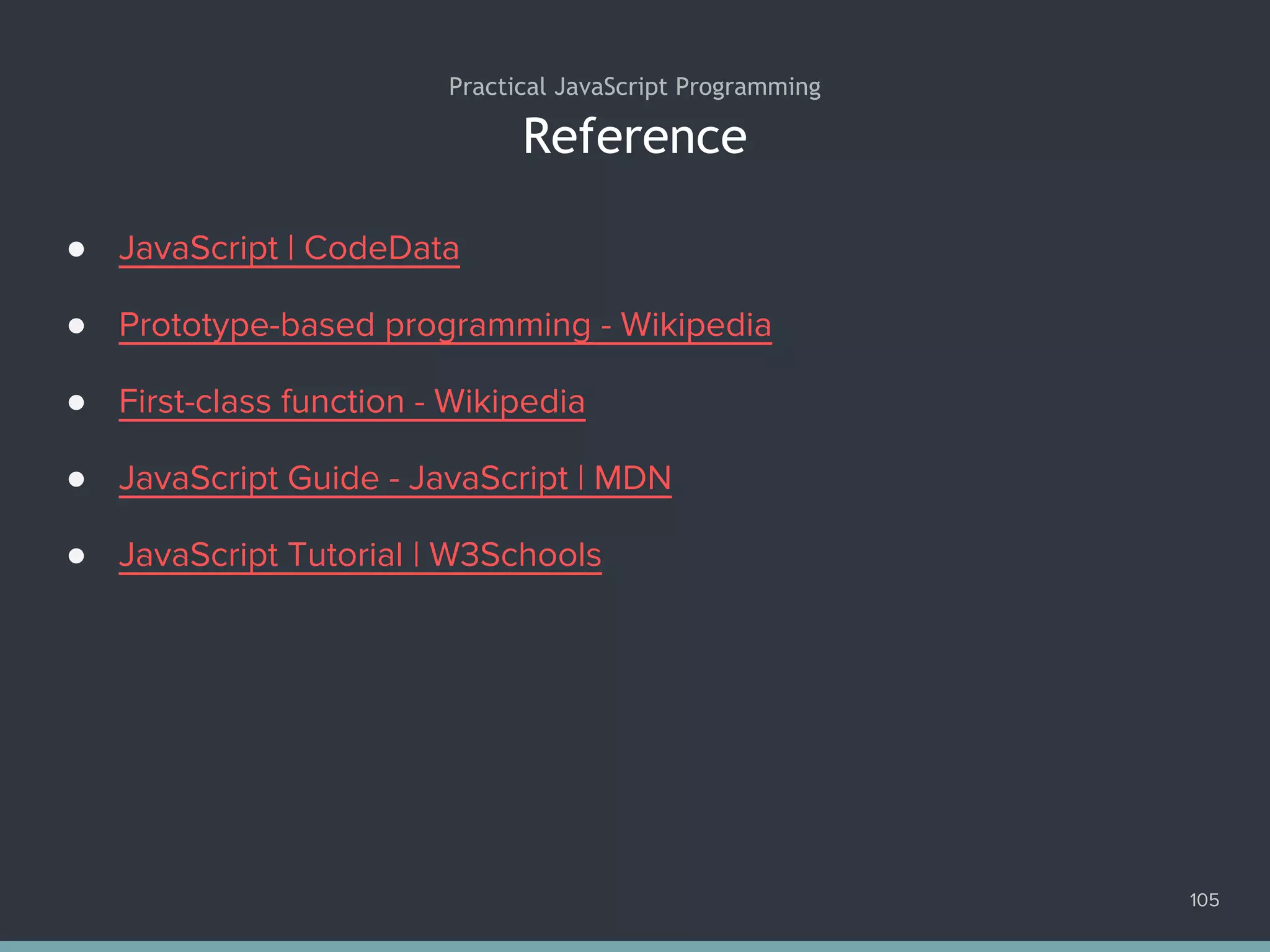JavaScript is one of the most popular skills in today’s job market. It allows you to create both client- and server-side applications quickly and easily. Having a solid understanding of this powerful and versatile language is essential to anyone who uses it. “Practical JavaScript Programming” does not only focus on best practices, but also introduces the fundamental concepts. This course will take you from JavaScript basics to advanced. You’ll learn about topics like Data Types, Functions, Events, AJAX and more.
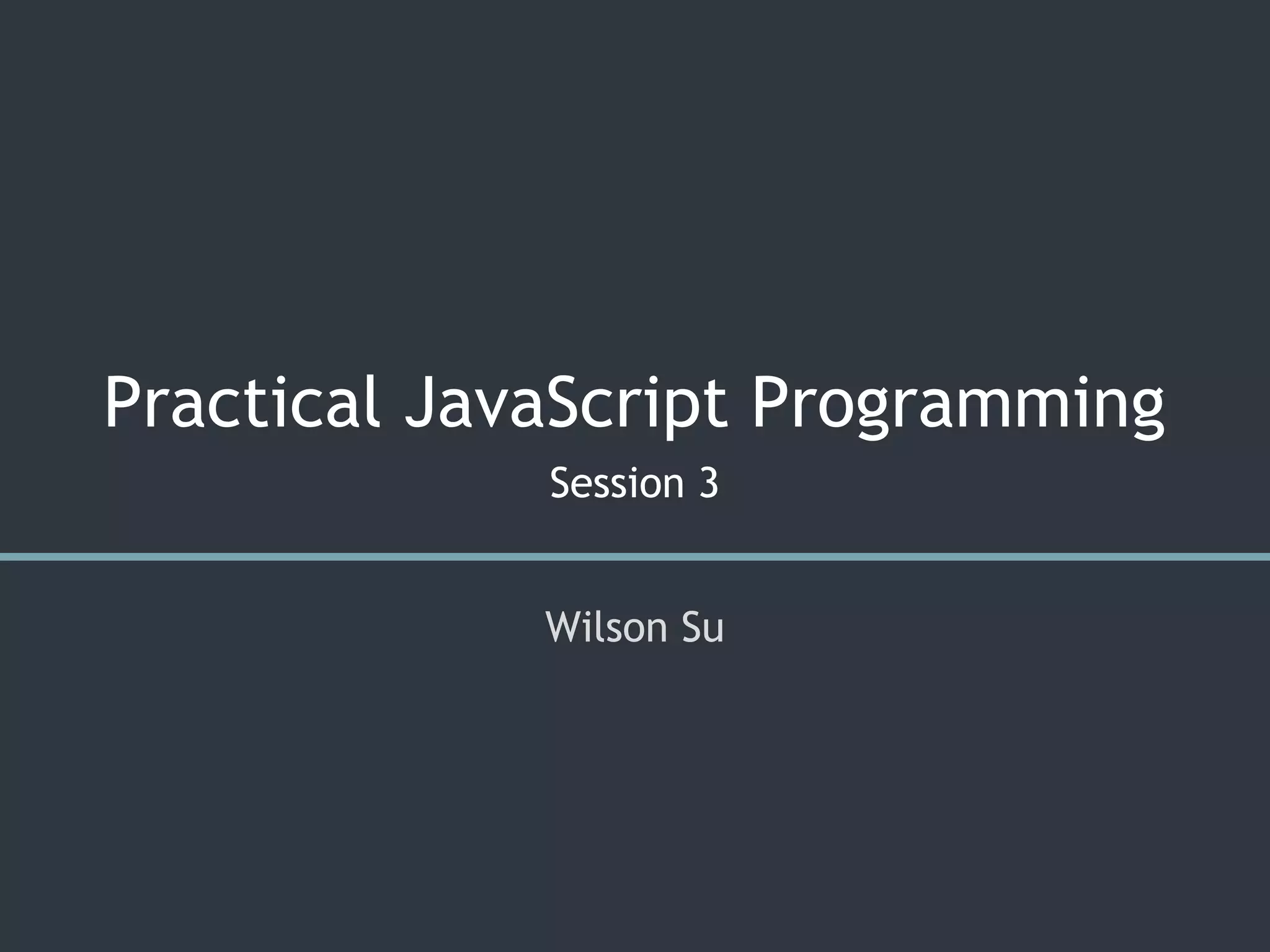

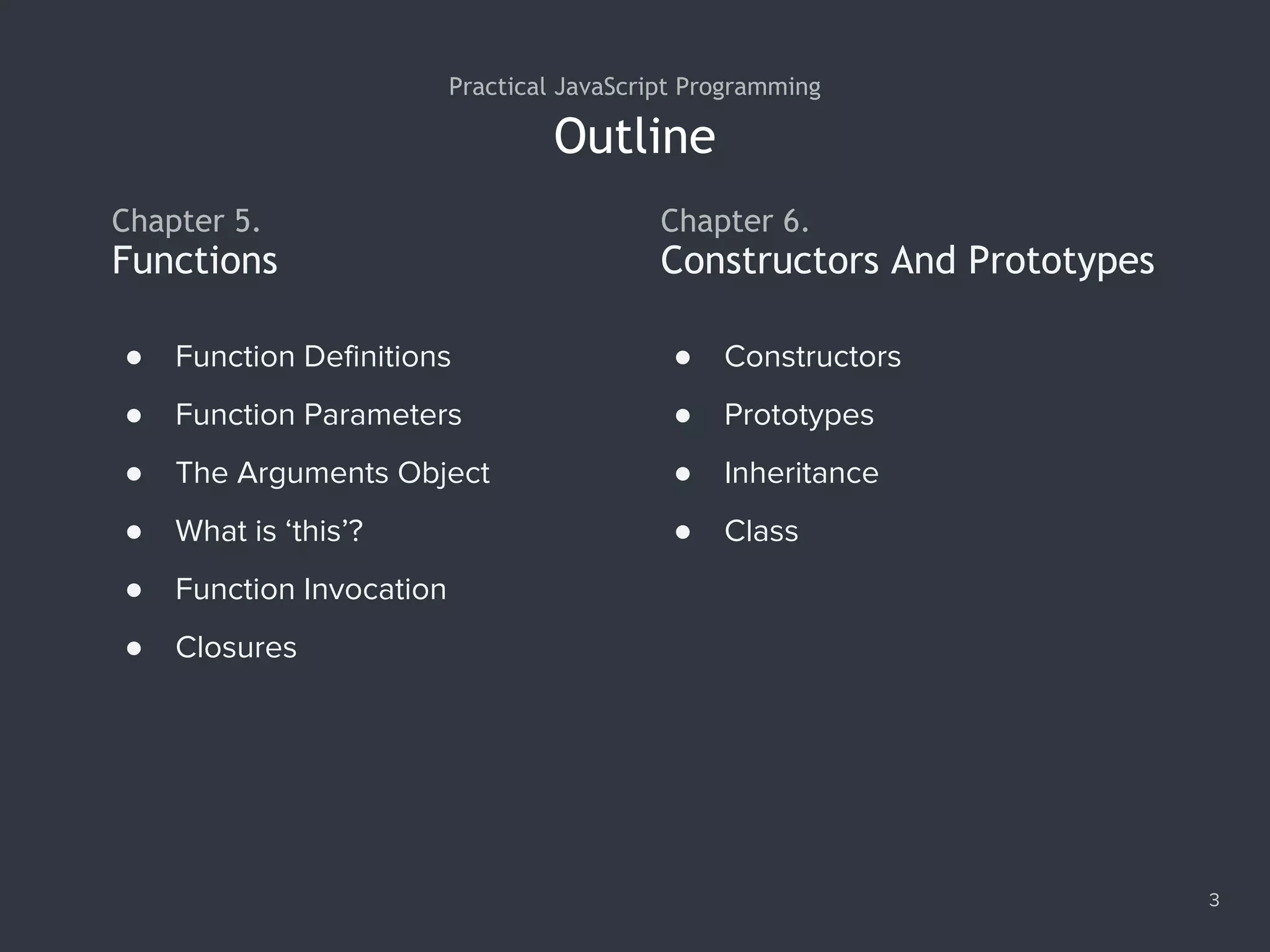


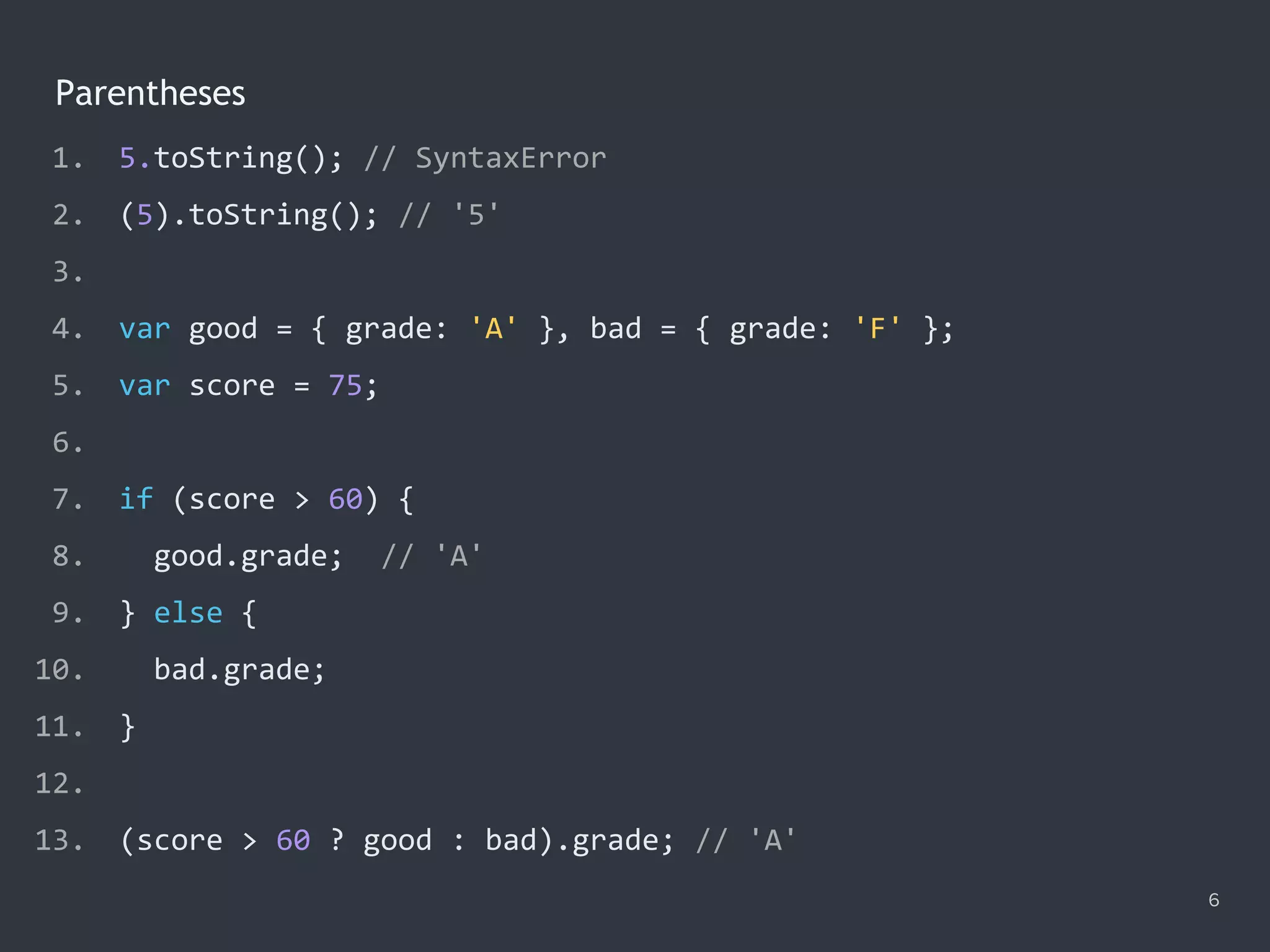

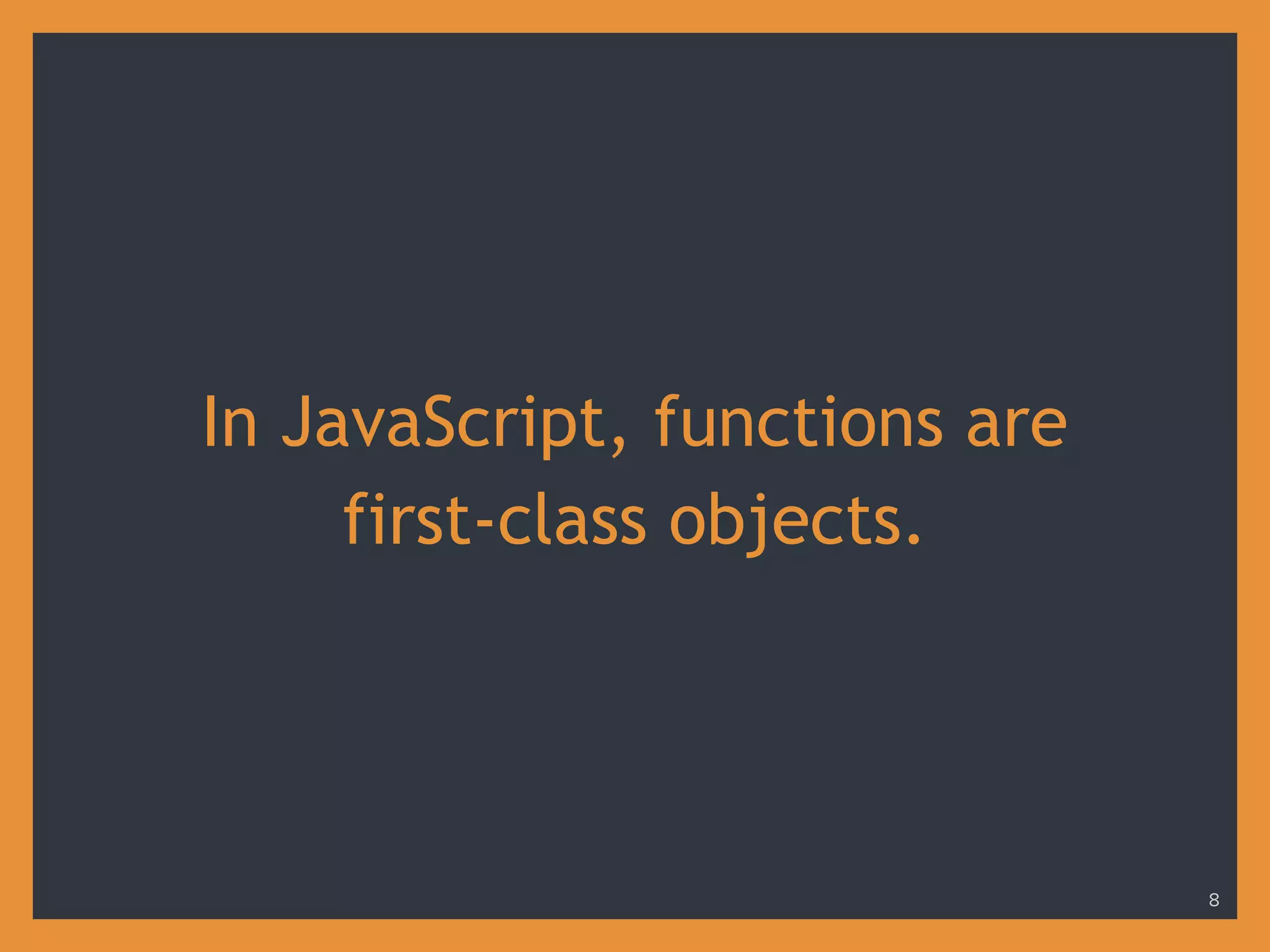

![3 Ways To Define A Function 10 1. /* Function declarations */ 2. function name ([param[, param[..., param]]]) { 3. [statements] 4. } 5. 6. /* Function expressions */ 7. var name = function [name] ([param[, param[..., param]]]) { 8. [statements] 9. } 10. 11. /* Function Constructor */ 12. var name = new Function([param[, param[..., param]],] body);](https://image.slidesharecdn.com/practicaljavascriptprogramming-session3-170705052051/75/Practical-JavaScript-Programming-Session-3-8-10-2048.jpg)
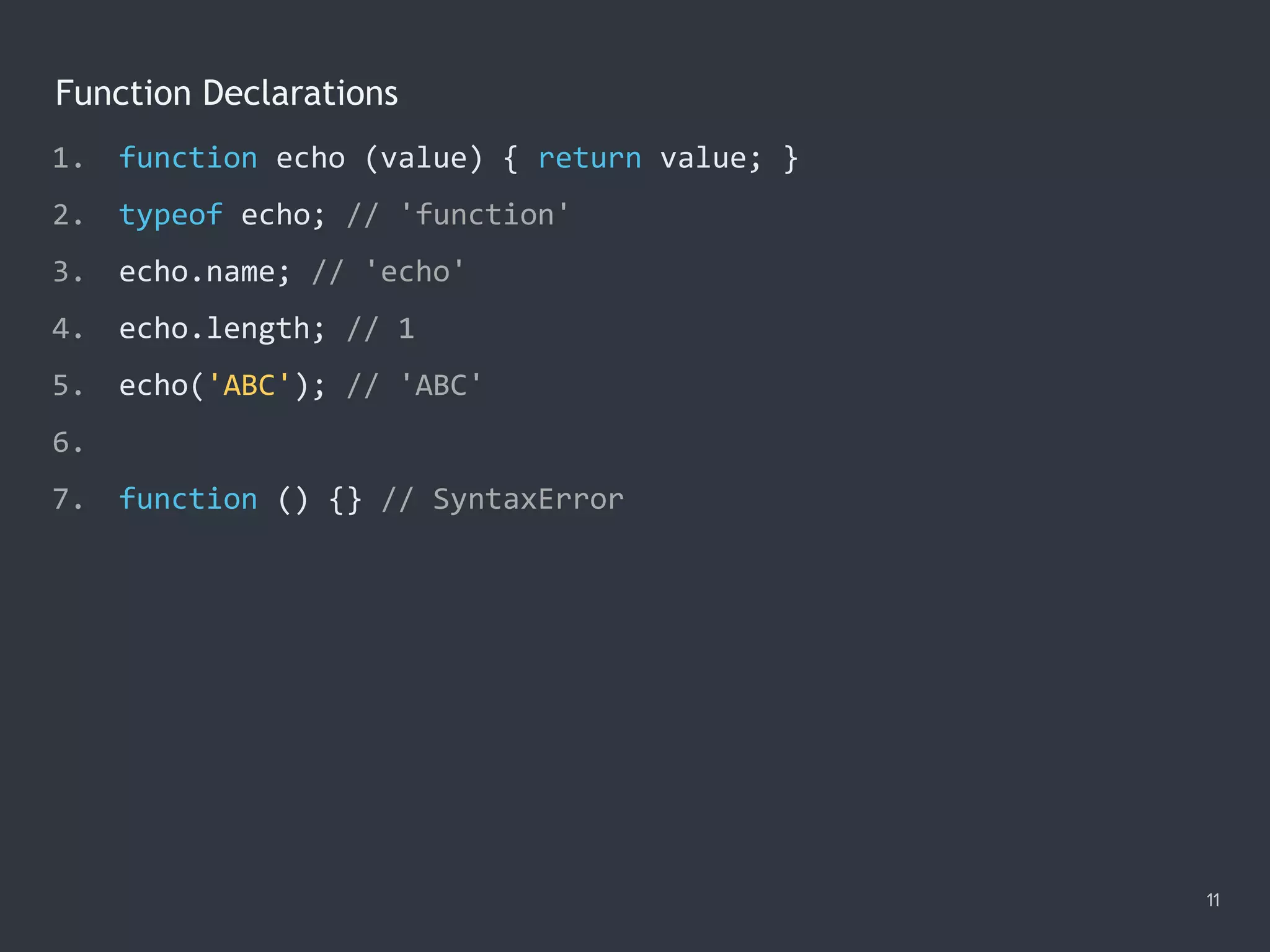
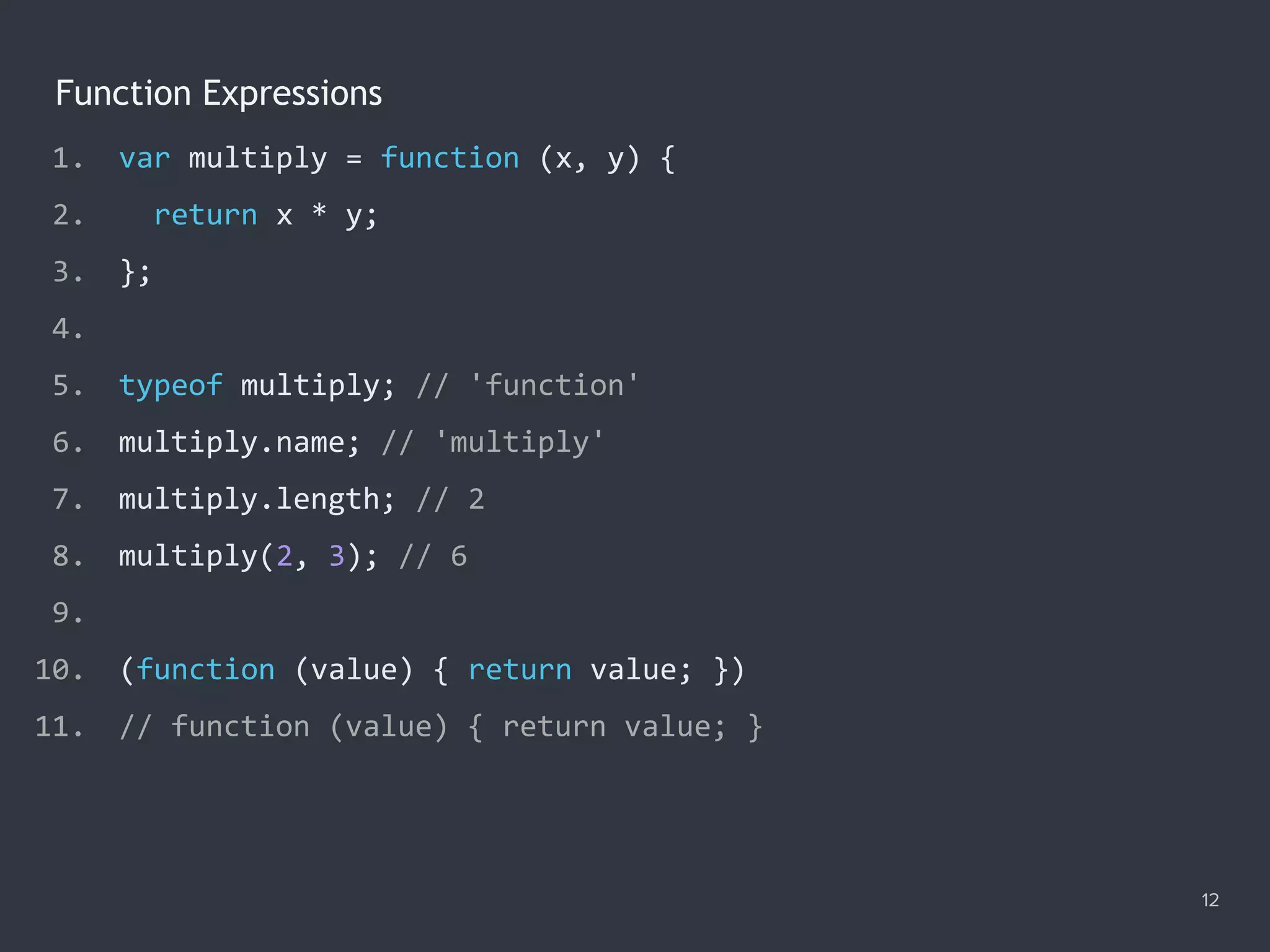
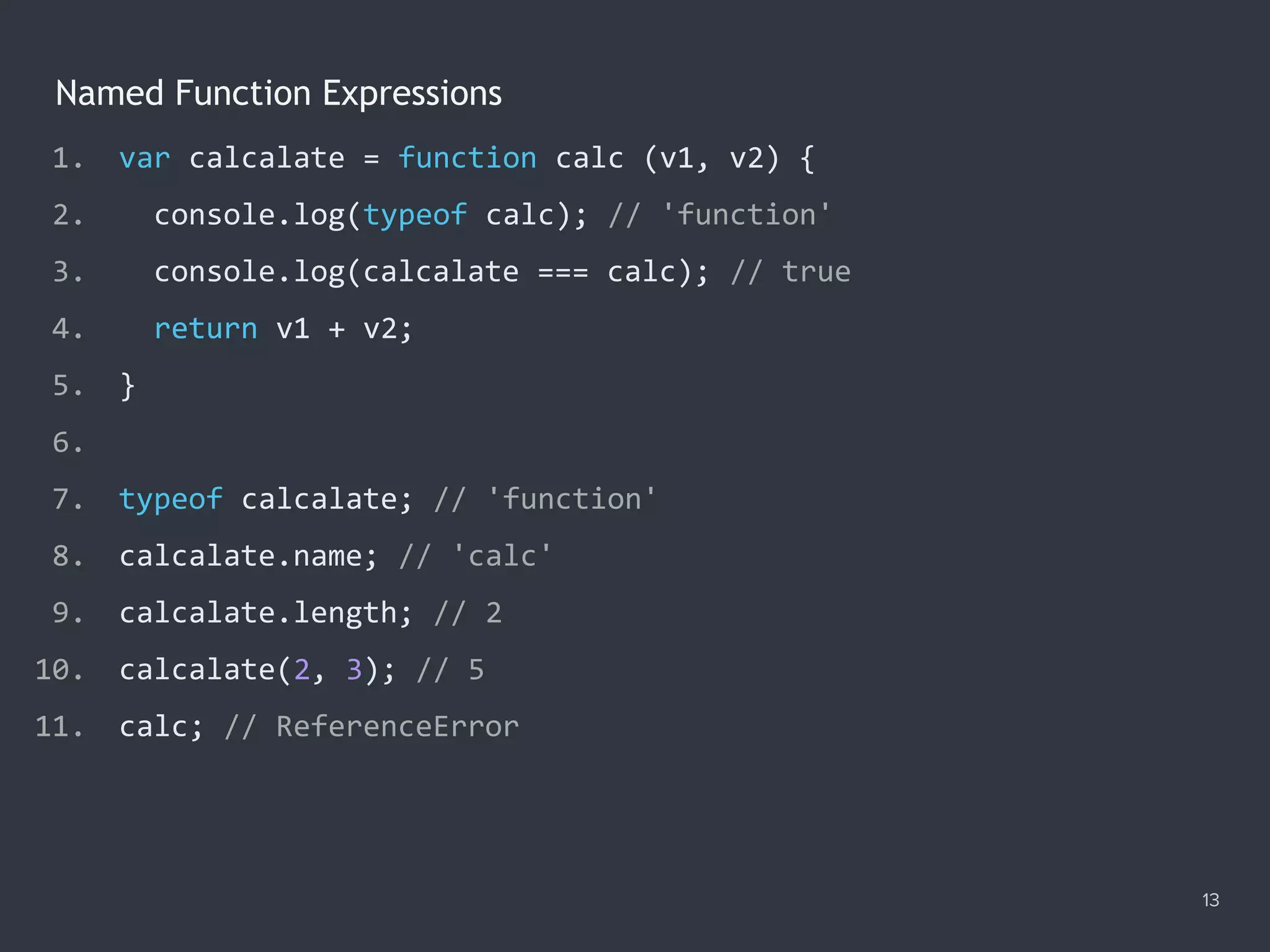
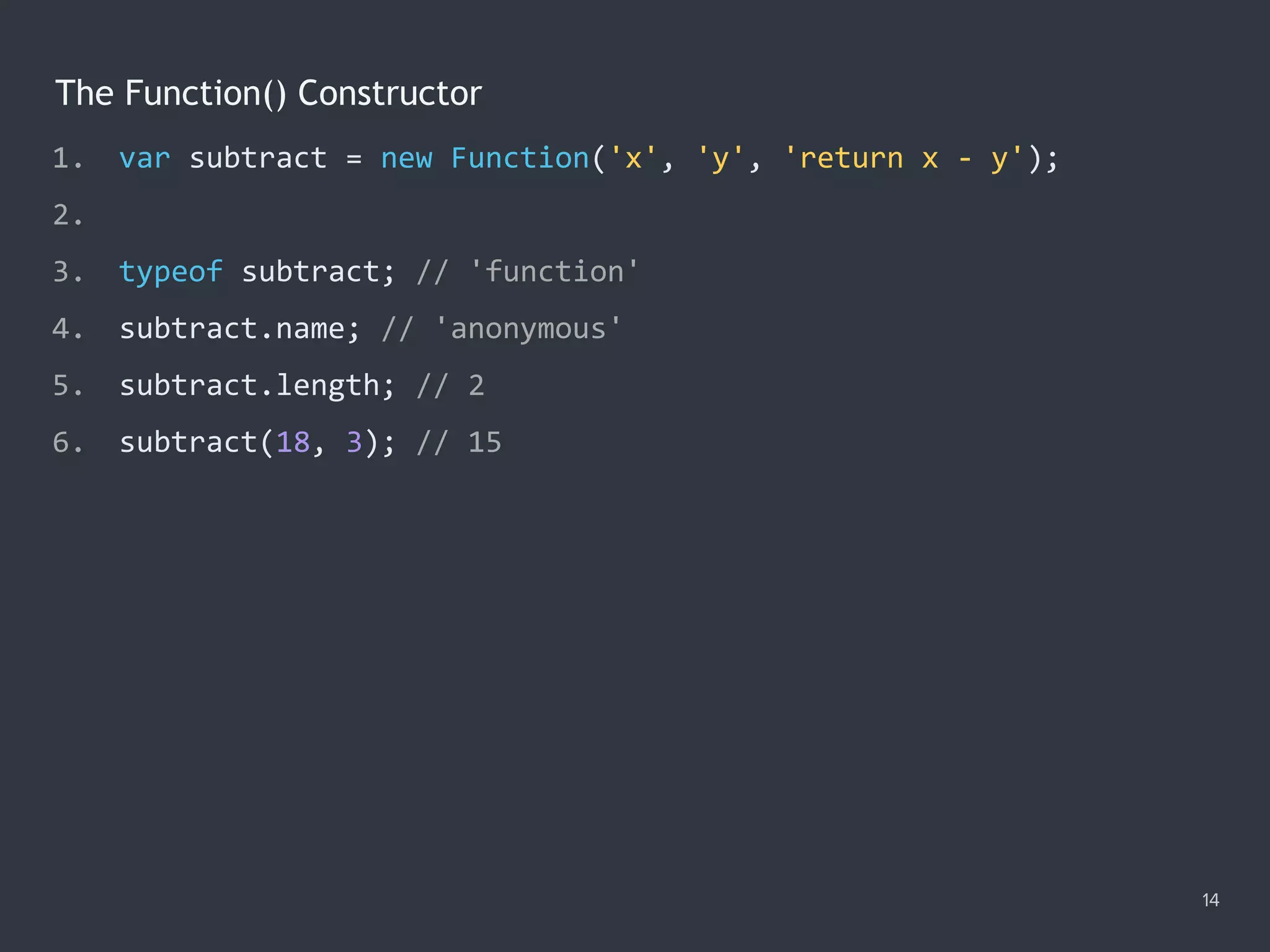
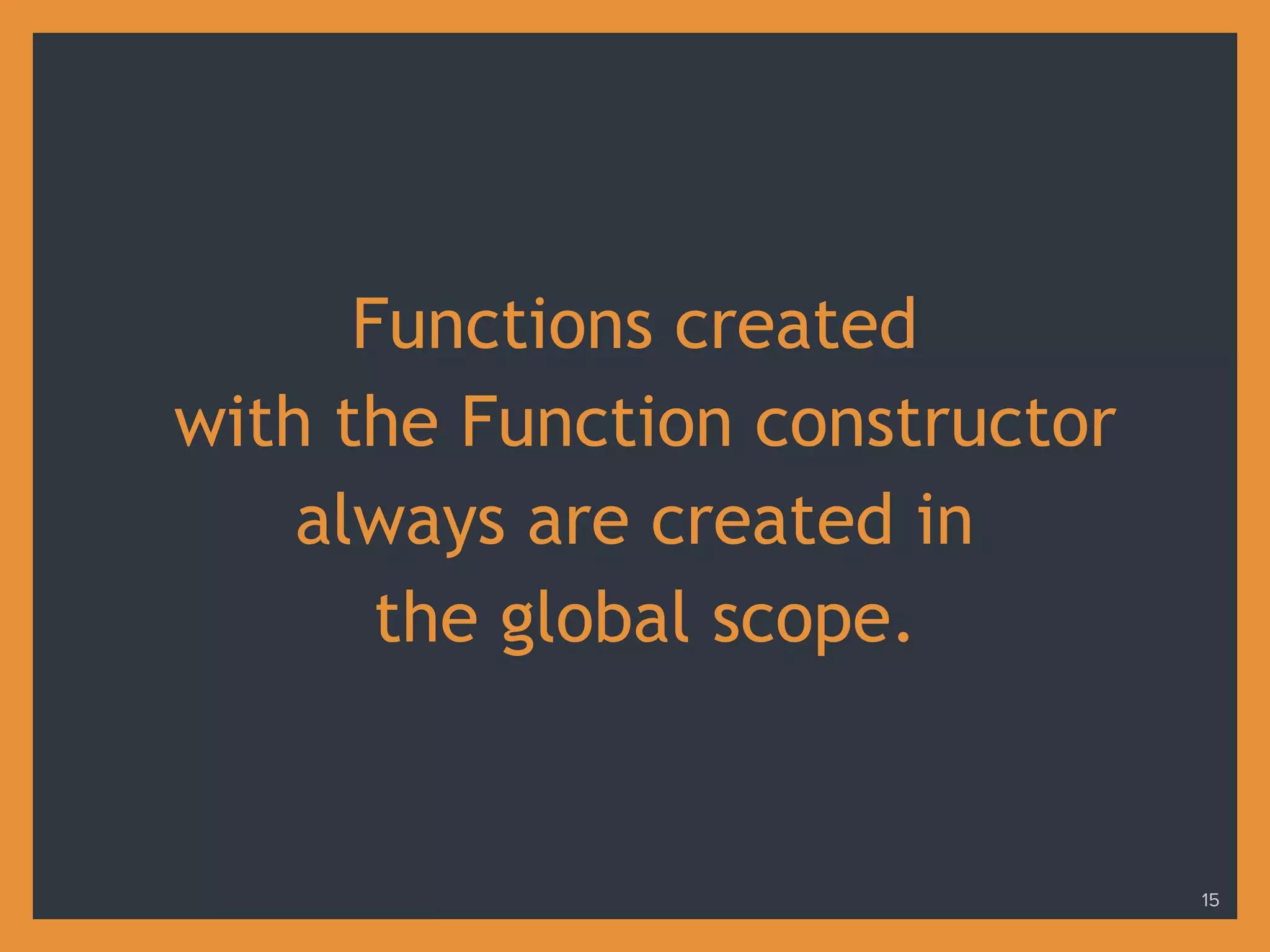
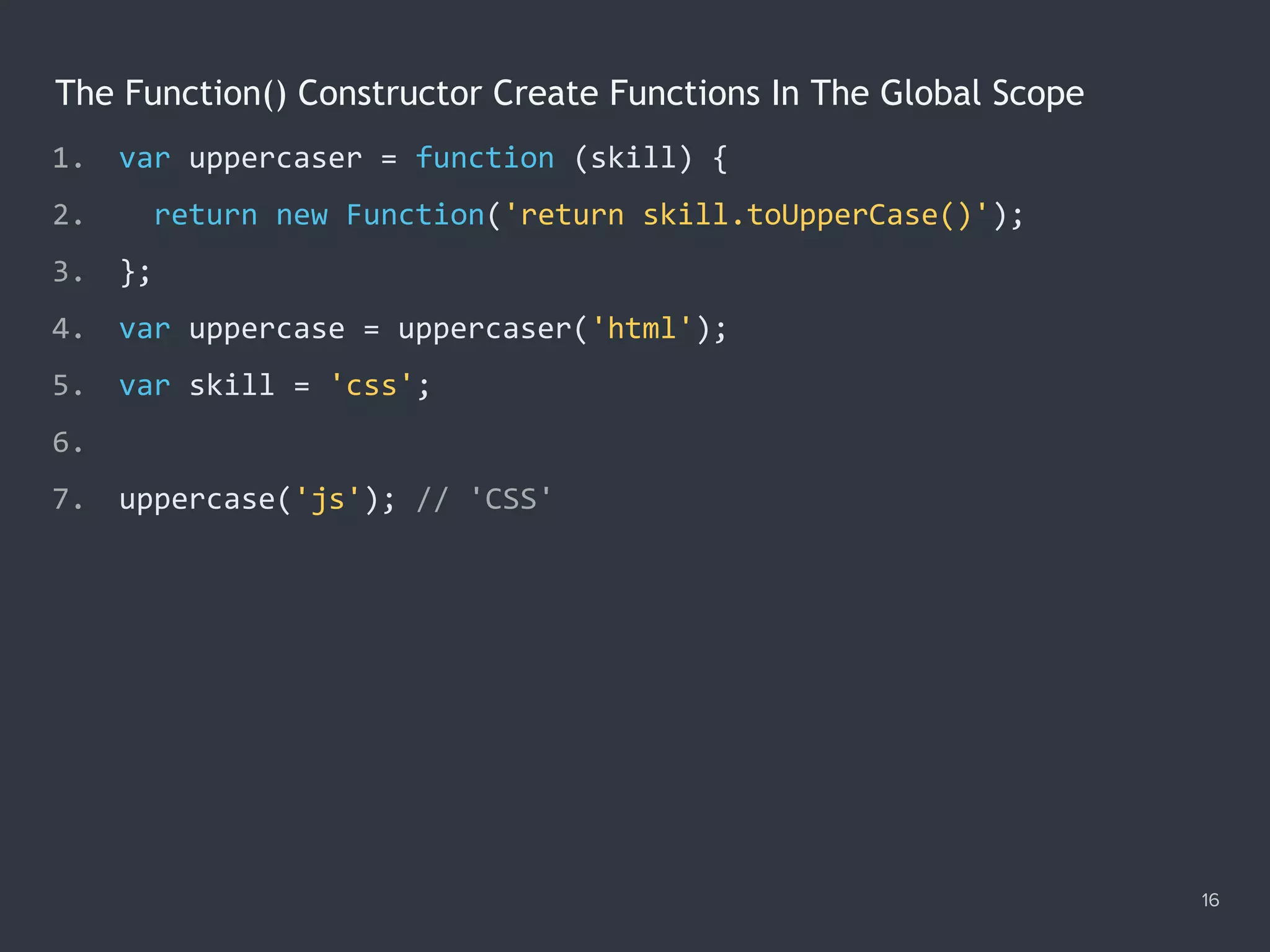
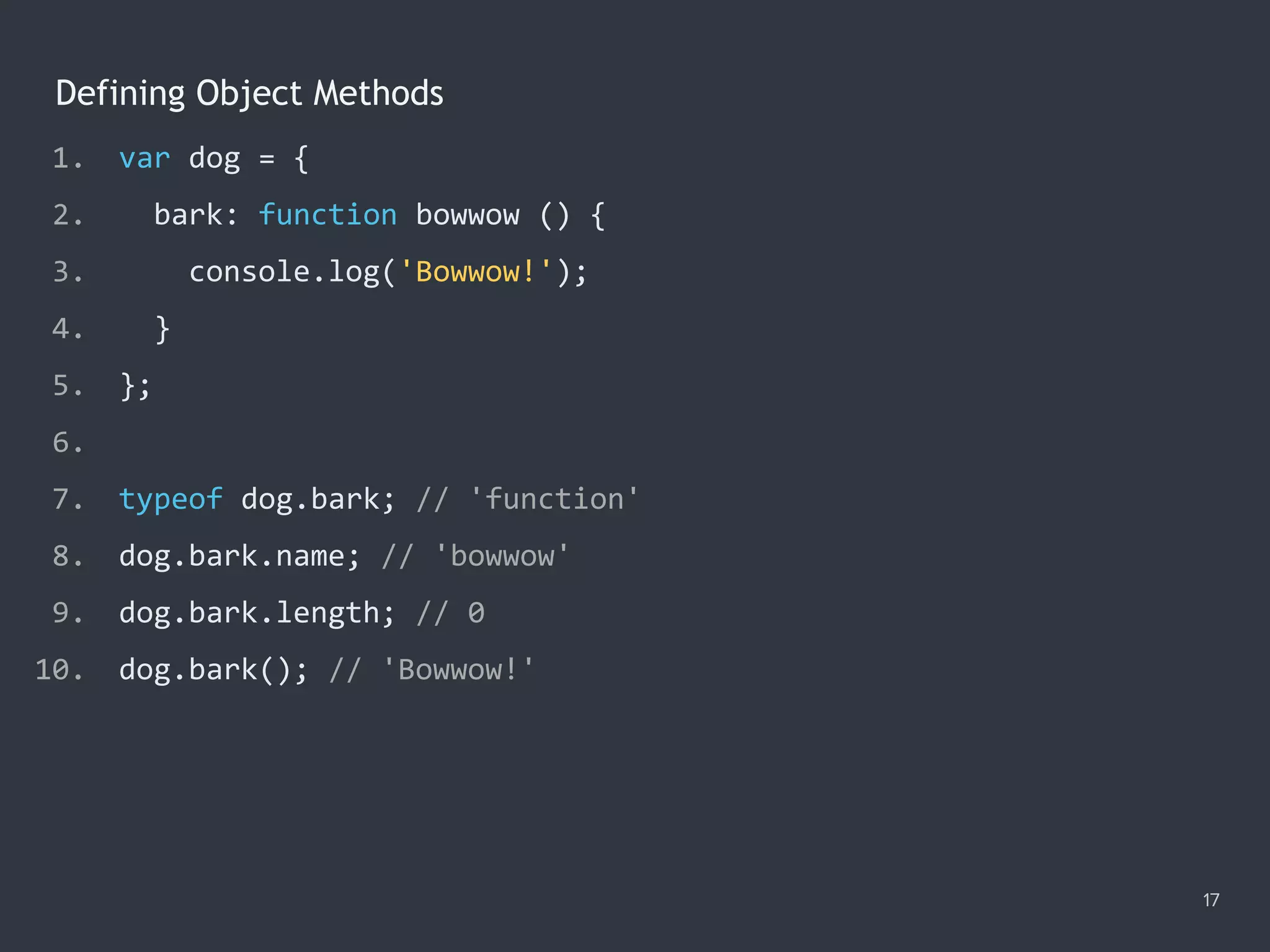
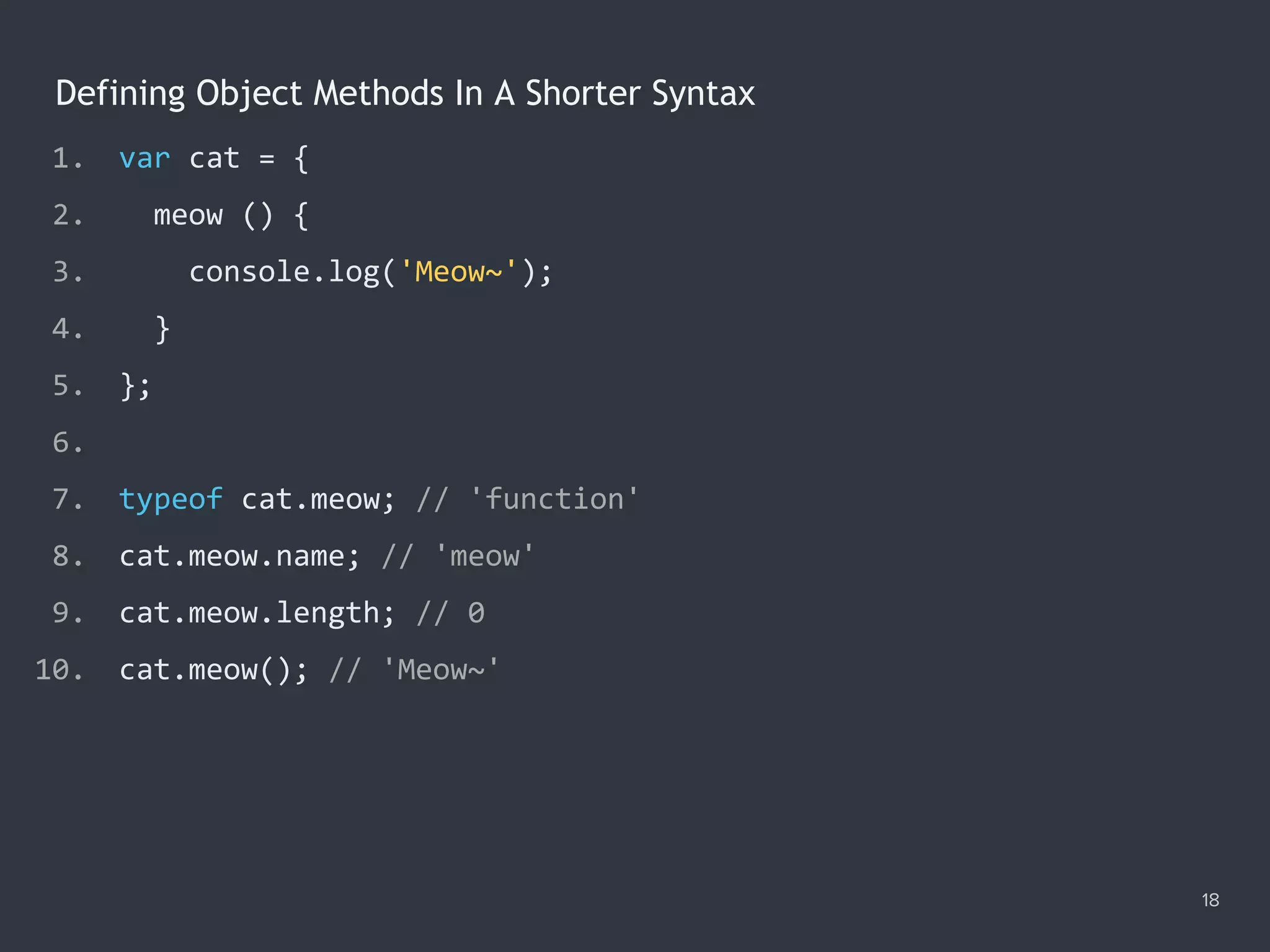
![Function Return 19 1. function noop () {} 2. function nothing () { return; } 3. function echo (value) { return value; } 4. 5. noop(true); // undefined 6. nothing('Hi'); // undefined 7. echo([10, 20]); // (2) [10, 20]](https://image.slidesharecdn.com/practicaljavascriptprogramming-session3-170705052051/75/Practical-JavaScript-Programming-Session-3-8-19-2048.jpg)
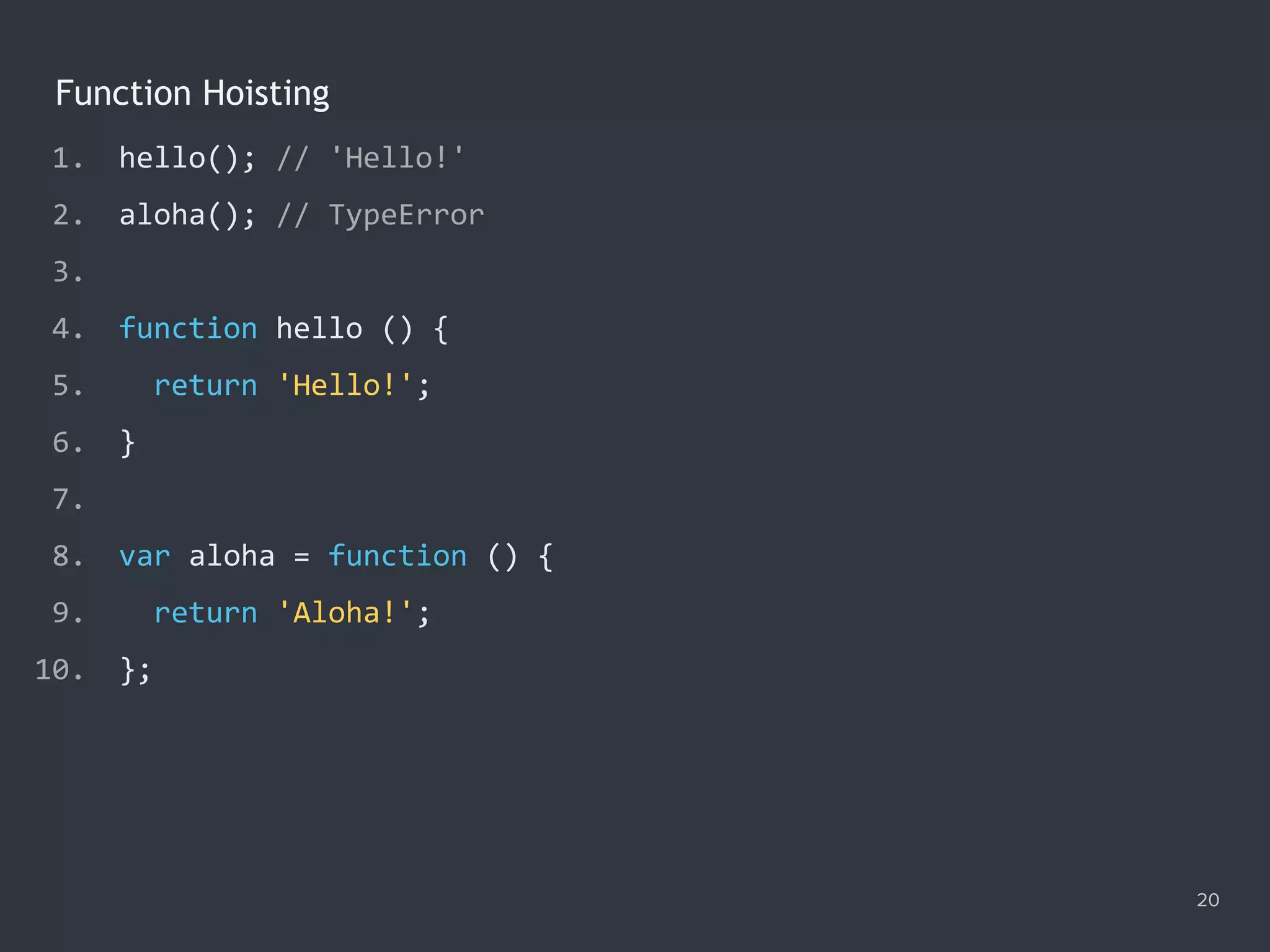
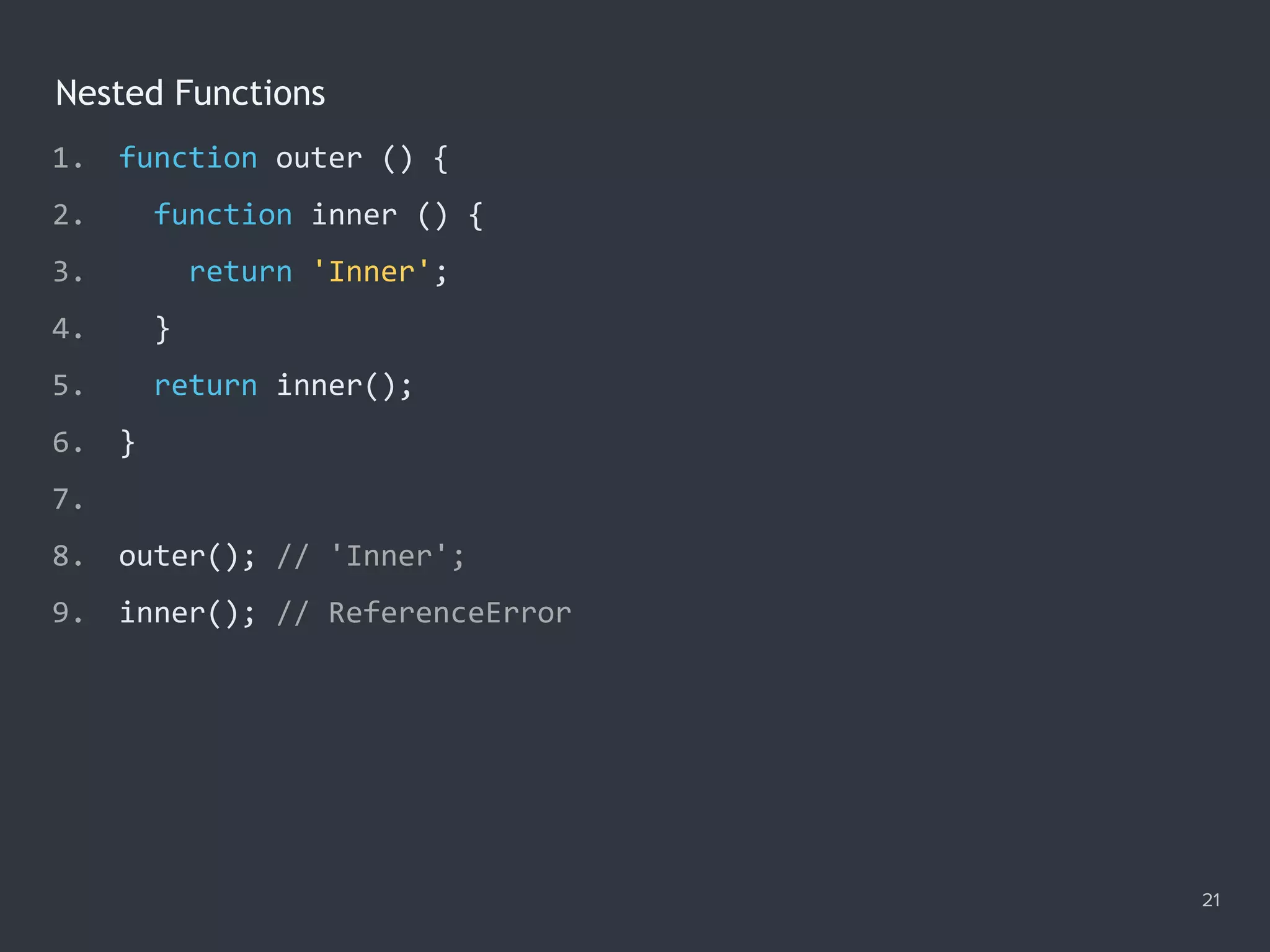
![Arrow Functions 22 1. var remove = (target, array) => { 2. var index = array.indexOf(target); 3. return index > -1 ? !!array.splice(index, 1) : false; 4. }; 5. var concat = (list1, list2) => list1.concat(list2); 6. var numbers = [100, 200, 300]; 7. 8. remove(200, numbers); // true 9. numbers; // (2) [100, 300] 10. concat(numbers, [500, 700]); // (4) [100, 300, 500, 700] 11. numbers; // ? 1. var remove = (target, array) => { 2. var index = array.indexOf(target); 3. return index > -1 ? !!array.splice(index, 1) : false; 4. }; 5. var concat = (list1, list2) => list1.concat(list2); 6. var numbers = [100, 200, 300]; 7. 8. remove(200, numbers); // true 9. numbers; // (2) [100, 300] 10. concat(numbers, [500, 700]); // (4) [100, 300, 500, 700] 11. numbers; // (2) [100, 300]](https://image.slidesharecdn.com/practicaljavascriptprogramming-session3-170705052051/75/Practical-JavaScript-Programming-Session-3-8-22-2048.jpg)
![More Examples With Arrow Functions 23 1. var noop = () => {}; 2. var book = title => ({ title }); 3. 4. book('Zero to One'); // {title: 'Zero to One'} 5. 6. [{ id: 10 }, { id: 20 }, { id: 30 }].map(item => item.id); 7. // (3) [10, 20, 30]](https://image.slidesharecdn.com/practicaljavascriptprogramming-session3-170705052051/75/Practical-JavaScript-Programming-Session-3-8-23-2048.jpg)
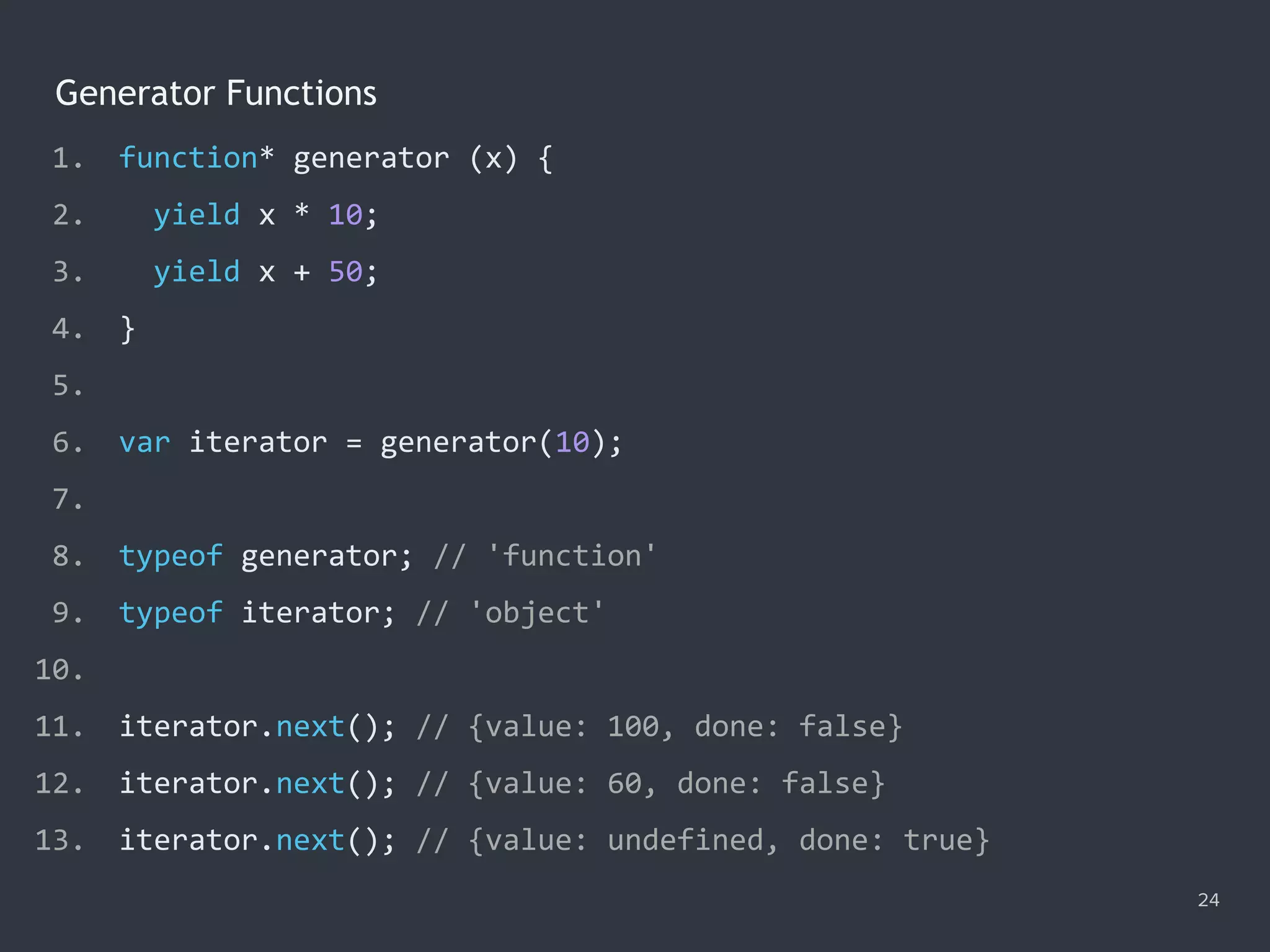

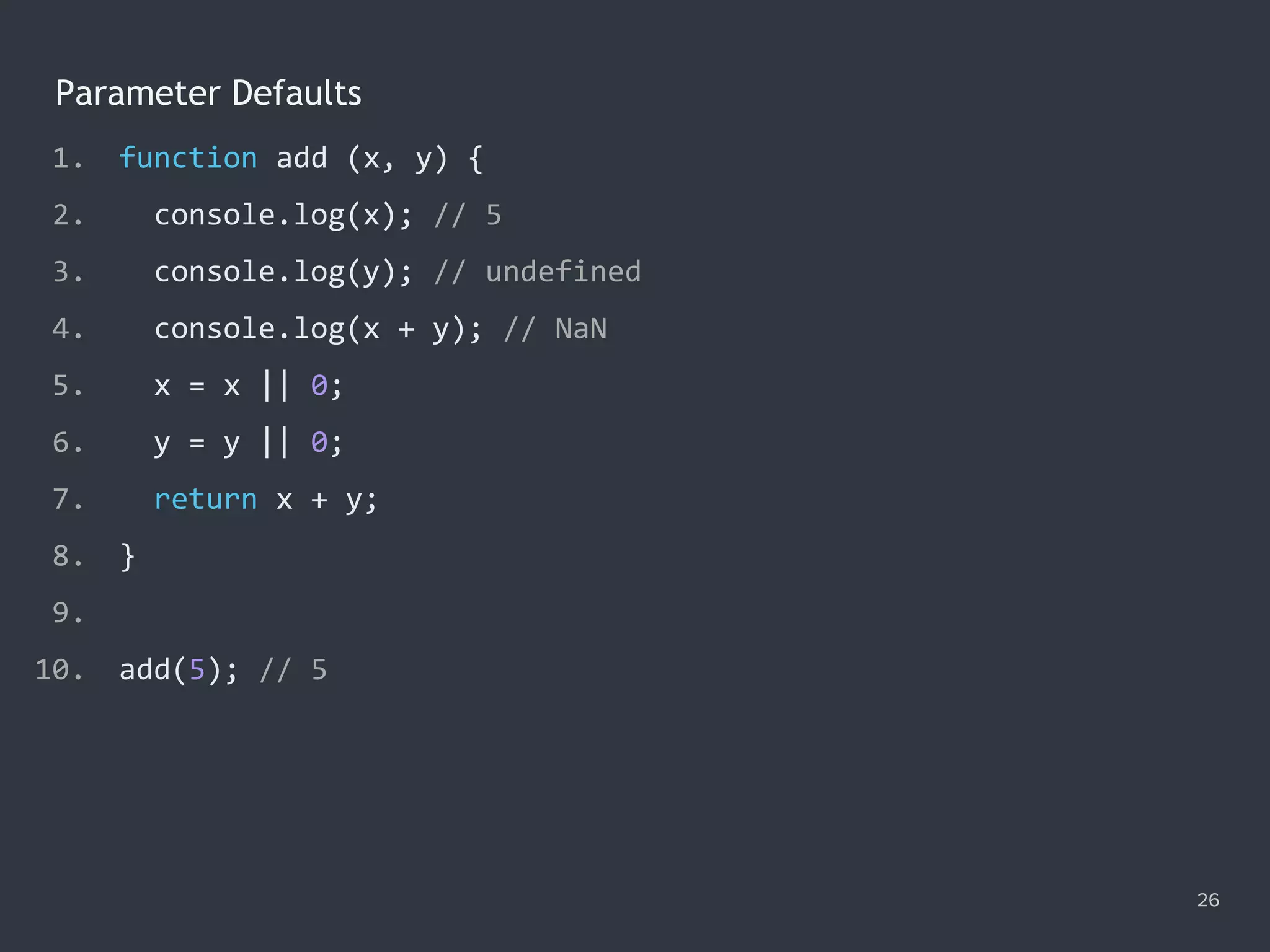
![Passed By Value / Passed By Reference 27 1. function update (string, object, array) { 2. string = 'aloha'; 3. object.id = 2; 4. array = []; 5. } 6. 7. var string = 'hello', object = { id: 1 }, array = [10, 20]; 8. 9. update(string, object, array); 10. console.log(string); // ? 11. console.log(object); // ? 12. console.log(array); // ? 1. function update (string, object, array) { 2. string = 'aloha'; 3. object.id = 2; 4. array = []; 5. } 6. 7. var string = 'hello', object = { id: 1 }, array = [10, 20]; 8. 9. update(string, object, array); 10. console.log(string); // 'hello' 11. console.log(object); // ? 12. console.log(array); // ? 1. function update (string, object, array) { 2. string = 'aloha'; 3. object.id = 2; 4. array = []; 5. } 6. 7. var string = 'hello', object = { id: 1 }, array = [10, 20]; 8. 9. update(string, object, array); 10. console.log(string); // 'hello' 11. console.log(object); // {id: 2} 12. console.log(array); // ? 1. function update (string, object, array) { 2. string = 'aloha'; 3. object.id = 2; 4. array = []; 5. } 6. 7. var string = 'hello', object = { id: 1 }, array = [10, 20]; 8. 9. update(string, object, array); 10. console.log(string); // 'hello' 11. console.log(object); // {id: 2} 12. console.log(array); // (2) [10, 20]](https://image.slidesharecdn.com/practicaljavascriptprogramming-session3-170705052051/75/Practical-JavaScript-Programming-Session-3-8-27-2048.jpg)
![Default And Destructured Parameters 28 1. function fn1 (x = 0) {} 2. 3. function fn2 (x = y(), z = []) {} 4. 5. function fn3 (x, y = x, z = y + 1) {} 6. 7. function fn4 ({ multiplier = 3 }, [x, y, z = 5]) {}](https://image.slidesharecdn.com/practicaljavascriptprogramming-session3-170705052051/75/Practical-JavaScript-Programming-Session-3-8-28-2048.jpg)
![Rest Parameters 29 1. function join (...args) { 2. return args.join(' '); 3. } 4. function sum (...[x, y, z]) { 5. return x + y + z; 6. } 7. 8. join('Ryan', 'likes', 'JS'); // 'Ryan likes JS' 9. 10. sum(1); // NaN 11. sum(1, 2, 3); // 6 12. sum(1, 2, 3, 4); // 6](https://image.slidesharecdn.com/practicaljavascriptprogramming-session3-170705052051/75/Practical-JavaScript-Programming-Session-3-8-29-2048.jpg)
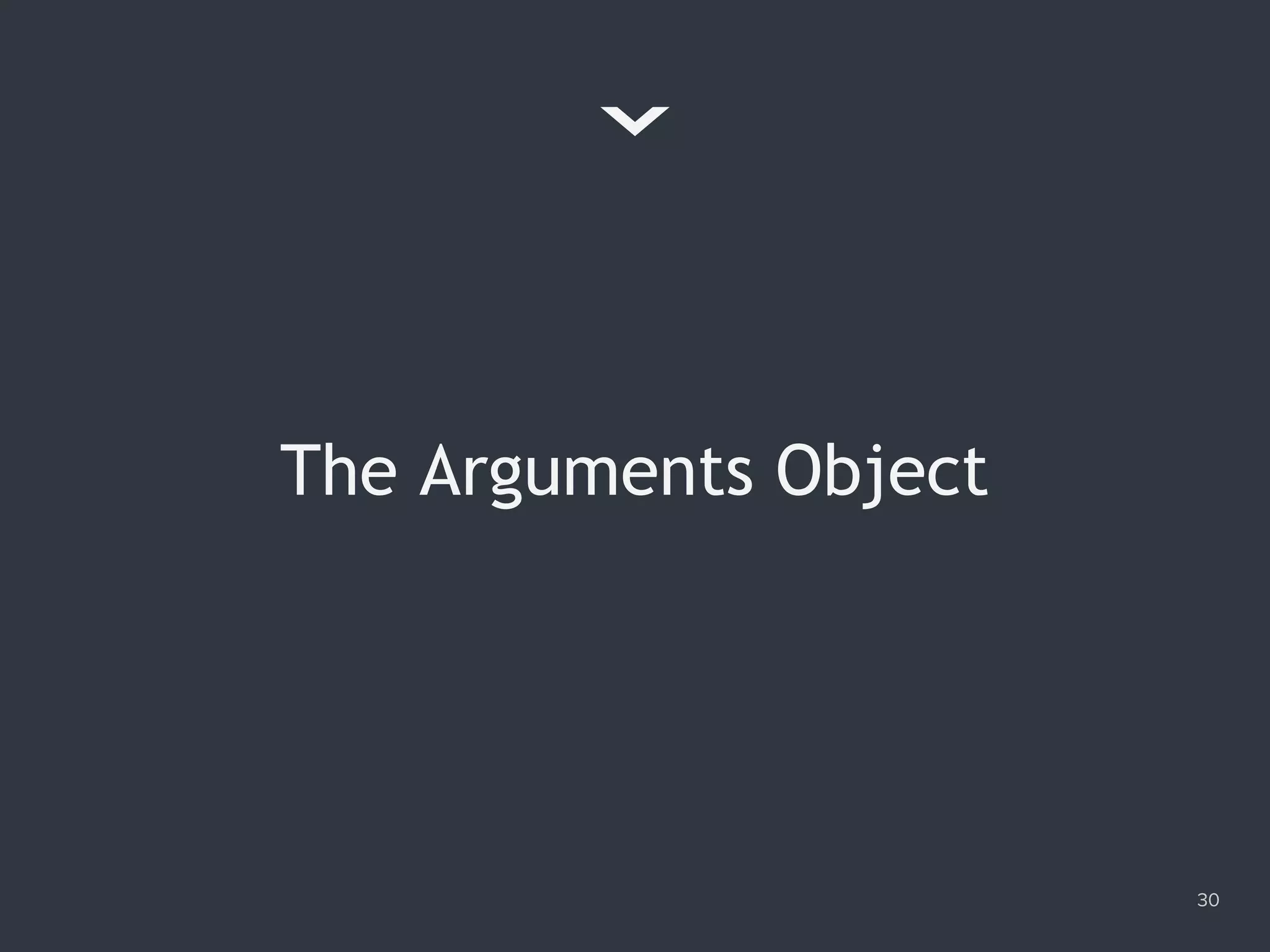
![The arguments Object 31 1. function fn () { 2. console.log(arguments); 3. } 4. 5. fn(10, 20); // (2) [10, 20]](https://image.slidesharecdn.com/practicaljavascriptprogramming-session3-170705052051/75/Practical-JavaScript-Programming-Session-3-8-31-2048.jpg)
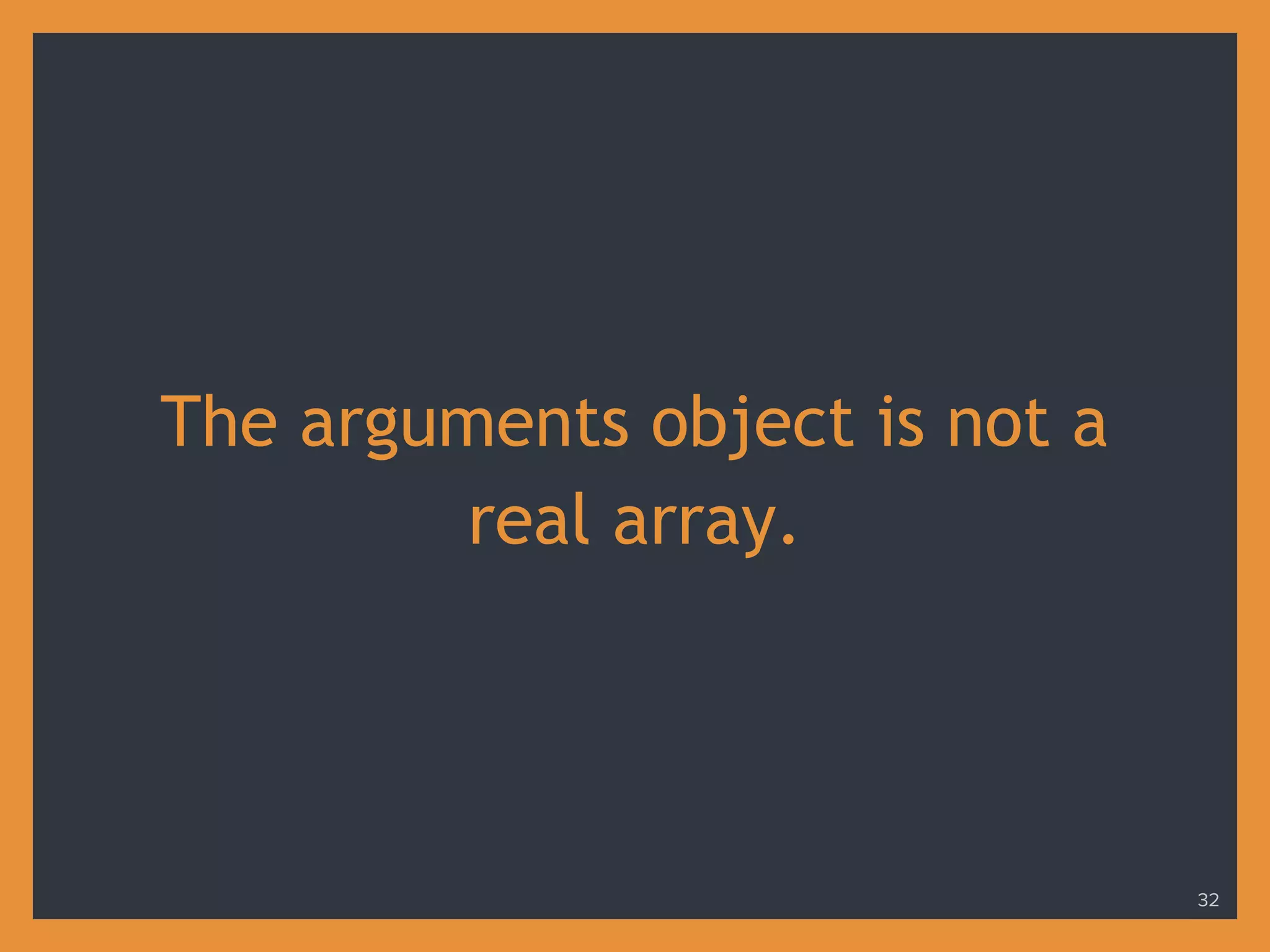
![The arguments Object 33 1. function fn () { 2. console.log(arguments.length); // 2 3. console.log(arguments[0]); // 10 4. console.log(arguments[1]); // 20 5. console.log(typeof arguments); // 'object' 6. console.log(arguments instanceof Array); // false 7. } 8. 9. fn(10, 20);](https://image.slidesharecdn.com/practicaljavascriptprogramming-session3-170705052051/75/Practical-JavaScript-Programming-Session-3-8-33-2048.jpg)
![From arguments To An Array 34 1. function toArray1 () { 2. return Array.prototype.slice.call(arguments, 0); 3. } 4. function toArray2 () { 5. return [].slice.call(arguments, 0); 6. } 7. 8. toArray1(1, 2, 3); // (3) [1, 2, 3] 9. toArray1(1, 2, 3) instanceof Array; // true 10. 11. toArray2(4, 5, 6); // (3) [4, 5, 6] 12. toArray2(4, 5, 6) instanceof Array; // true](https://image.slidesharecdn.com/practicaljavascriptprogramming-session3-170705052051/75/Practical-JavaScript-Programming-Session-3-8-34-2048.jpg)
![From arguments To An Array 35 1. function toArray3 () { 2. return arguments.length === 1 3. ? [arguments[0]] 4. : Array.apply(null, arguments); 5. } 6. 7. /* ES6 */ 8. function toArray4 () { 9. return Array.from(arguments); 10. }](https://image.slidesharecdn.com/practicaljavascriptprogramming-session3-170705052051/75/Practical-JavaScript-Programming-Session-3-8-35-2048.jpg)
![Destructuring 36 1. function fn () { 2. var args = [...arguments]; 3. var [x, y, ...rest] = arguments; 4. 5. console.log(args); // (5) [10, 20, 30, 40, 50] 6. console.log(args instanceof Array); // true 7. console.log(x); // 10 8. console.log(y); // 20 9. console.log(rest); // (3) [30, 40, 50] 10. } 11. 12. fn(10, 20, 30, 40, 50);](https://image.slidesharecdn.com/practicaljavascriptprogramming-session3-170705052051/75/Practical-JavaScript-Programming-Session-3-8-36-2048.jpg)
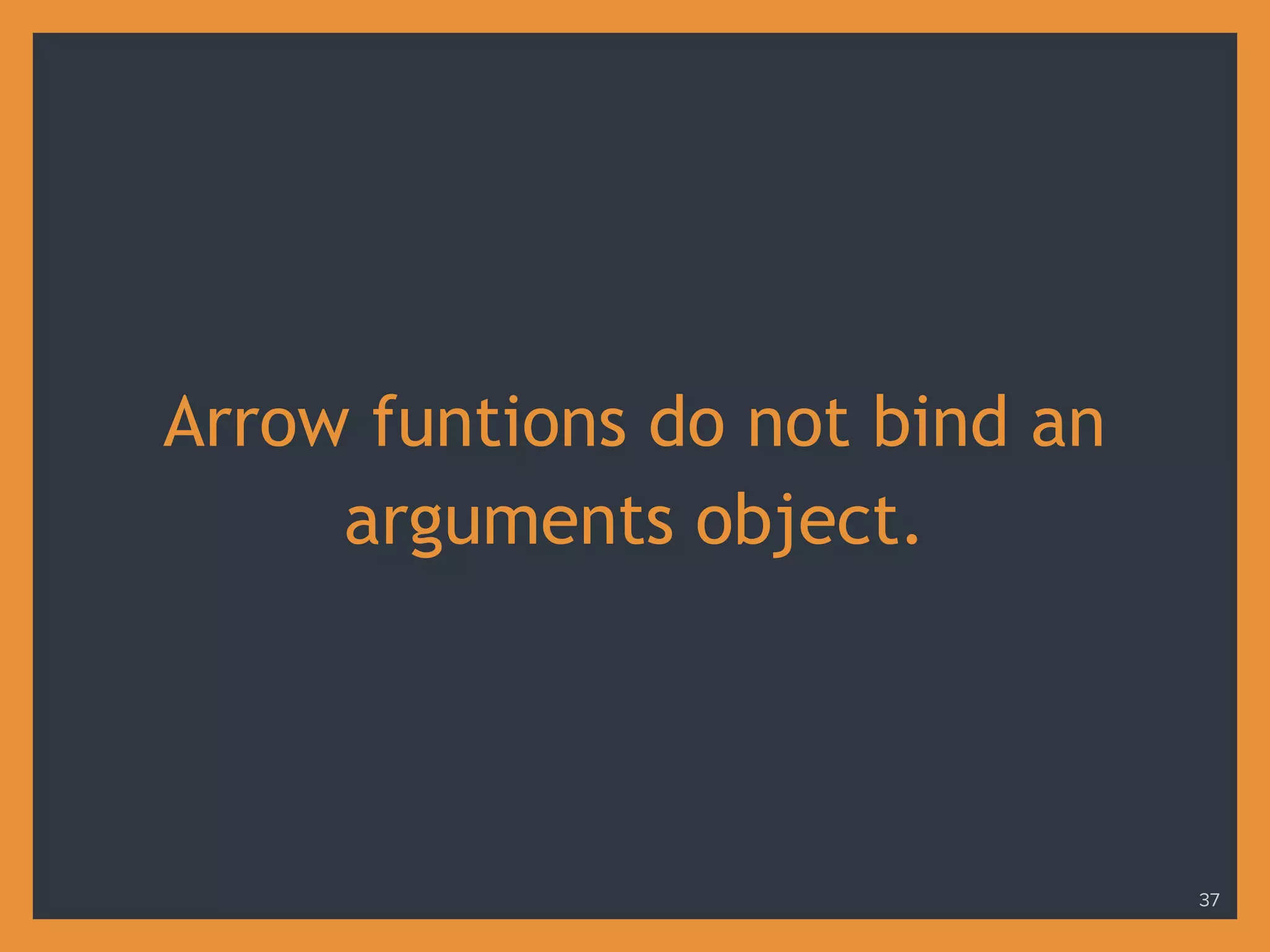
![Arrow Funtions 38 1. var fn = () => arguments; 2. var calc = function () { 3. var fn = (multiple) => arguments[0] * multiple; 4. return fn(3); 5. }; 6. 7. fn(); // ? 8. calc(8); // ? 1. var fn = () => arguments; 2. var calc = function () { 3. var fn = (multiple) => arguments[0] * multiple; 4. return fn(3); 5. }; 6. 7. fn(); // ReferenceError 8. calc(8); // ? 1. var fn = () => arguments; 2. var calc = function () { 3. var fn = (multiple) => arguments[0] * multiple; 4. return fn(3); 5. }; 6. 7. fn(); // ReferenceError 8. calc(8); // 24](https://image.slidesharecdn.com/practicaljavascriptprogramming-session3-170705052051/75/Practical-JavaScript-Programming-Session-3-8-38-2048.jpg)

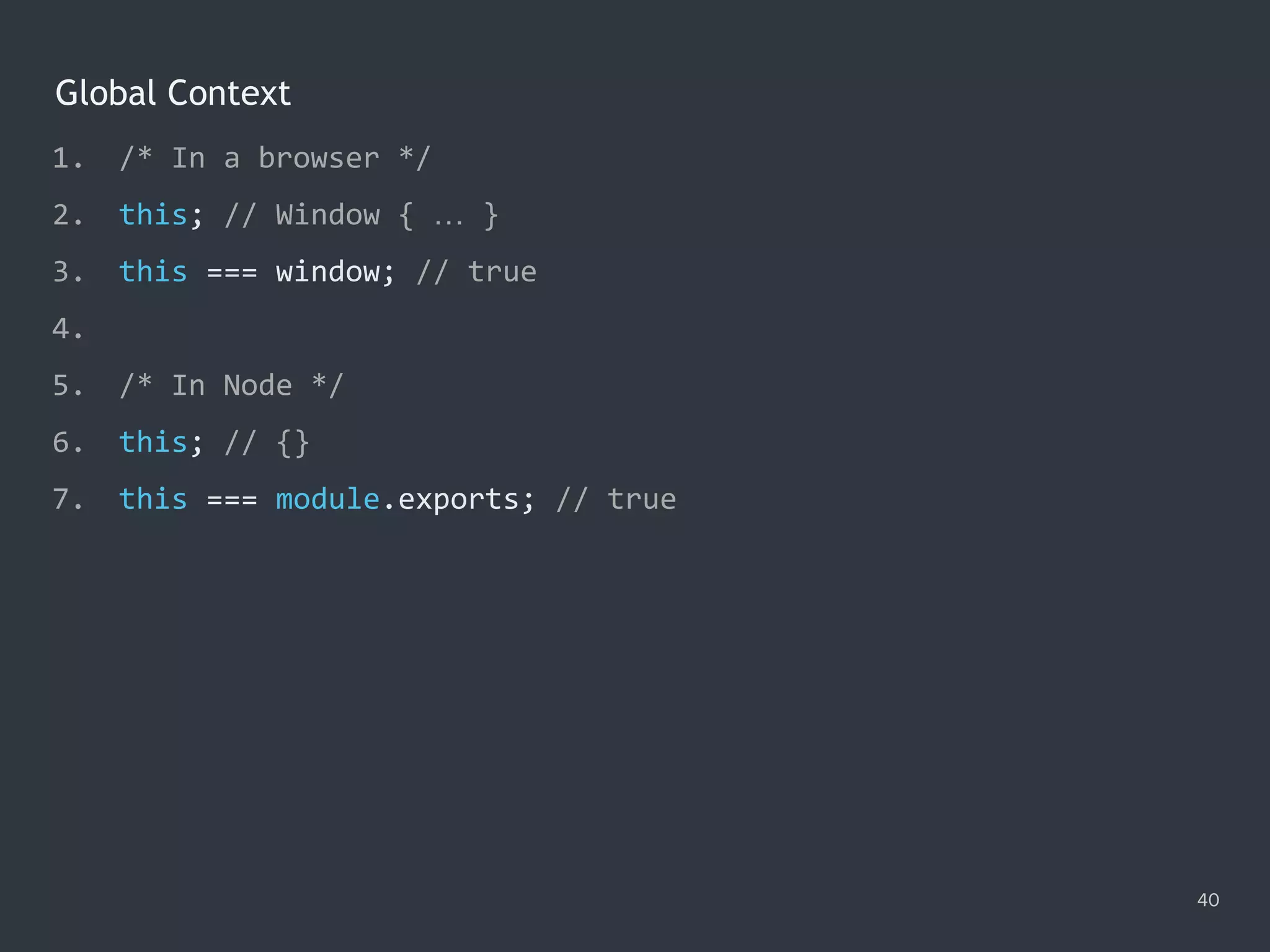
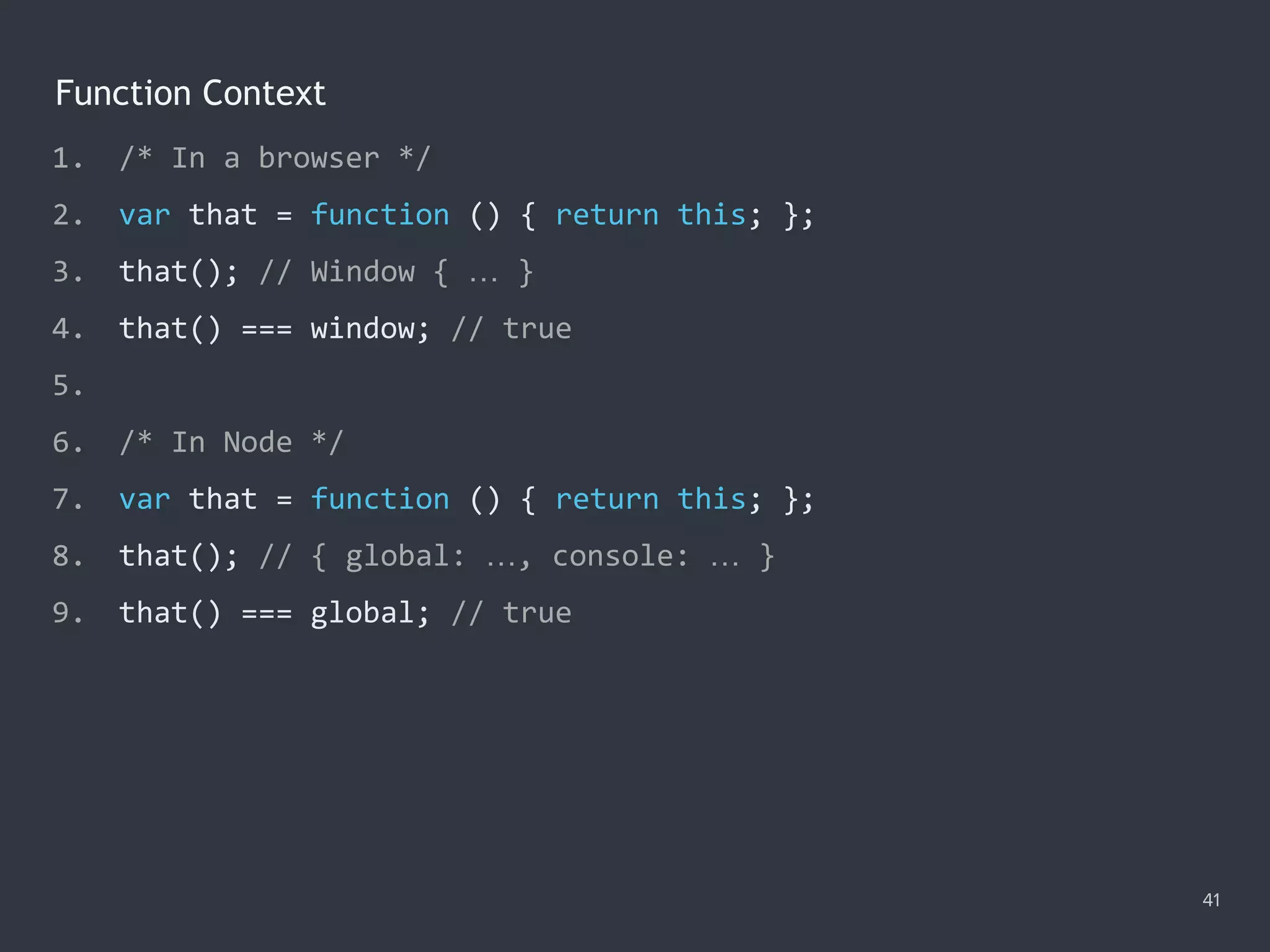
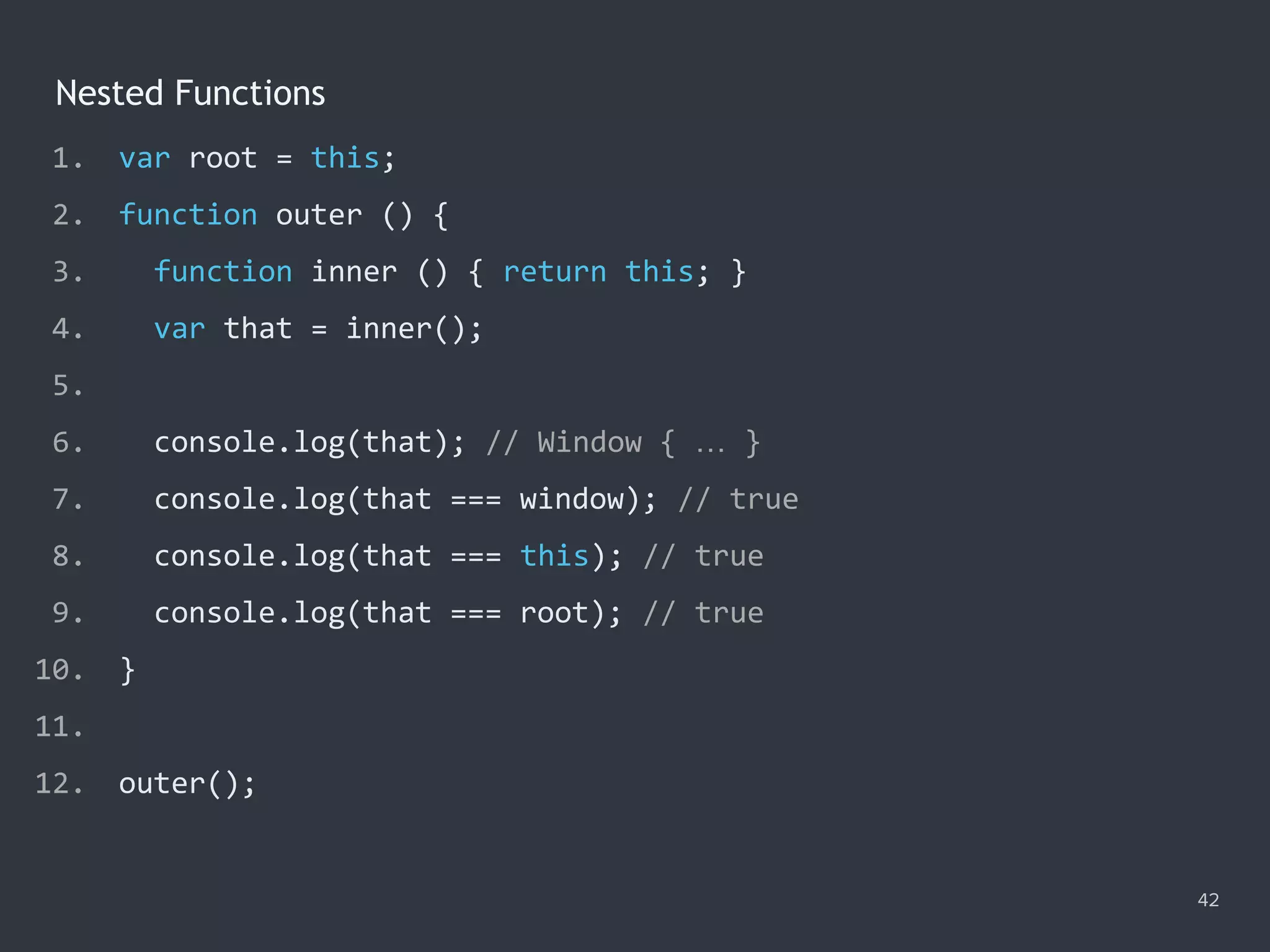
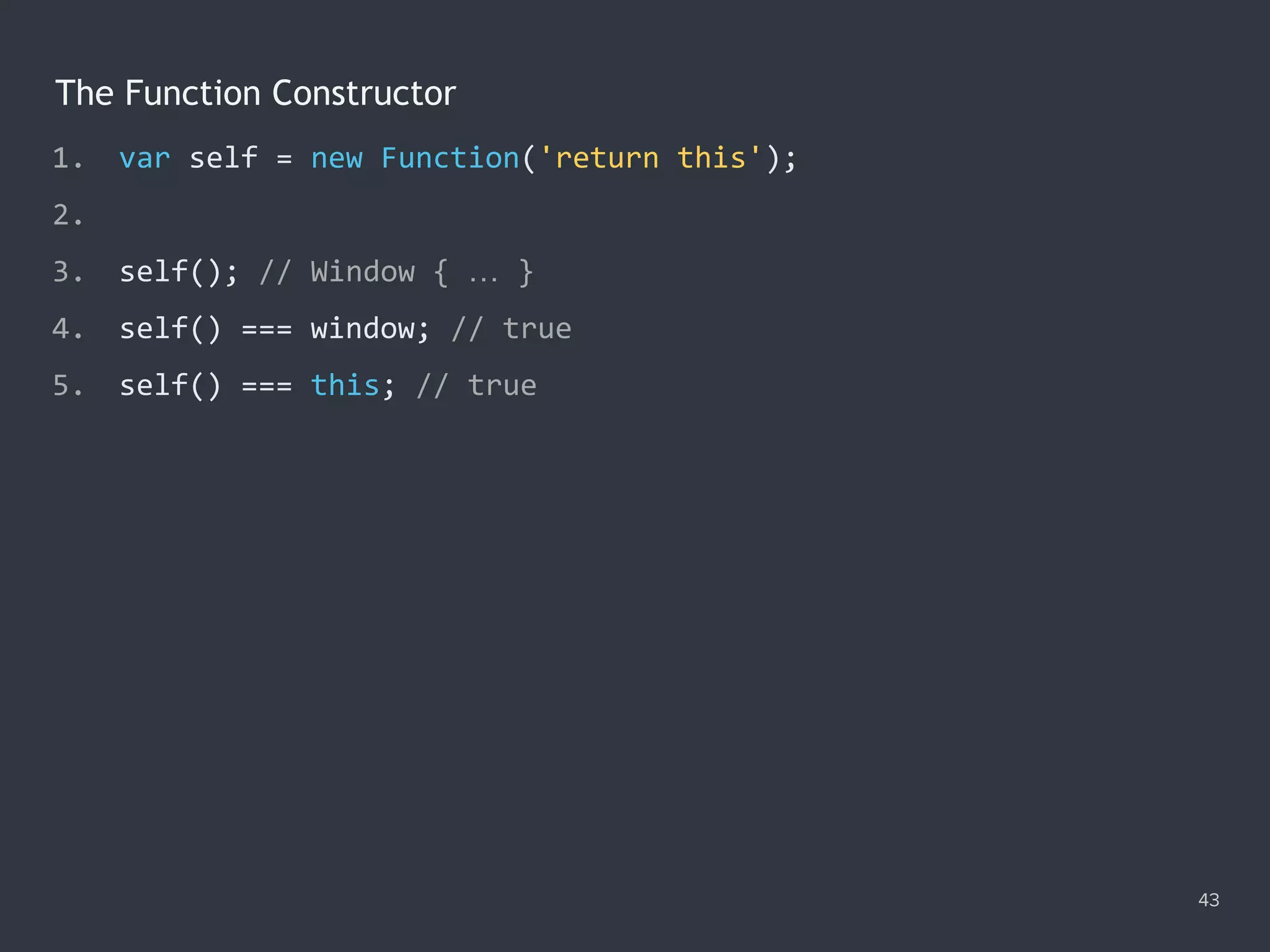
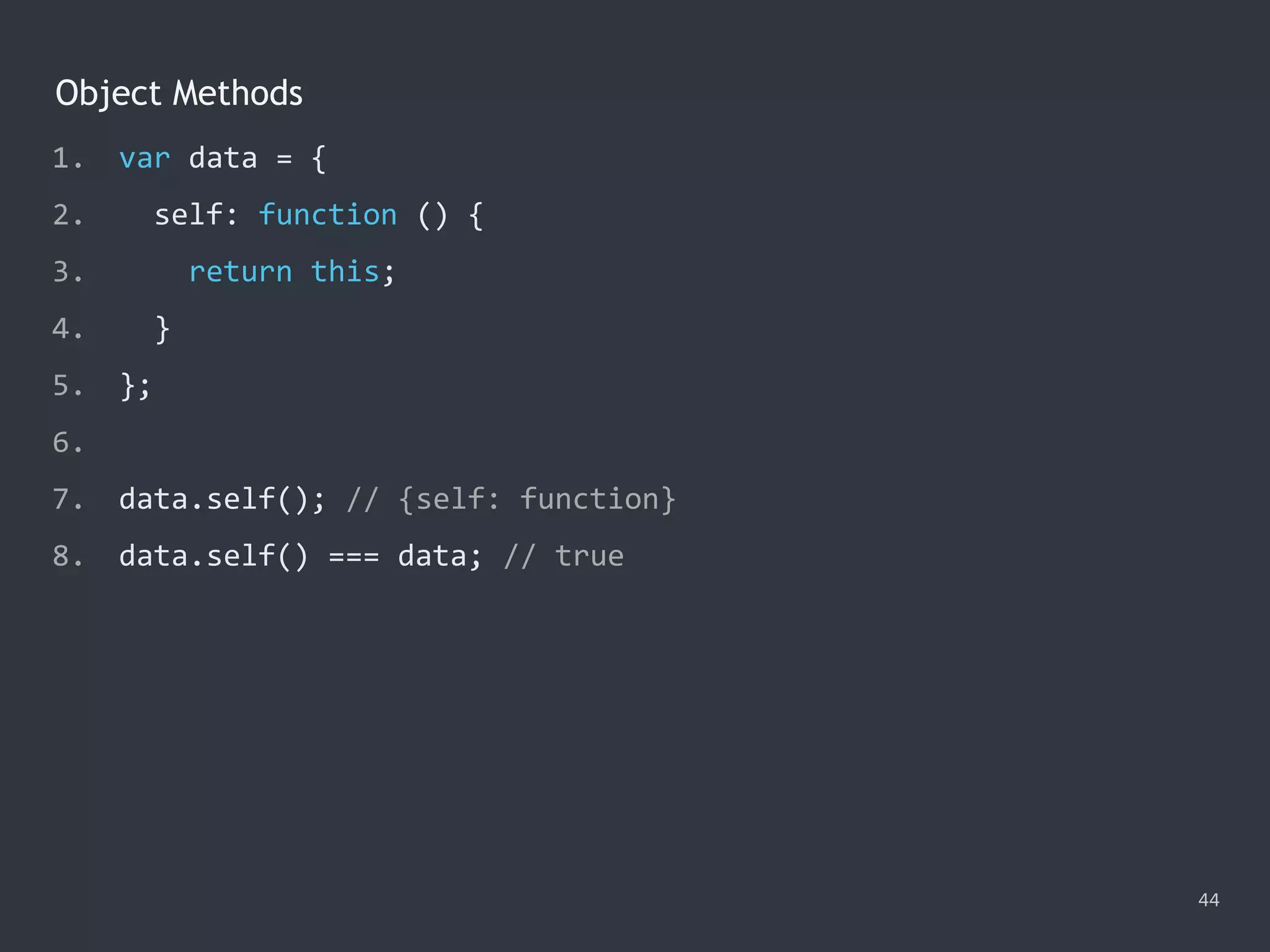
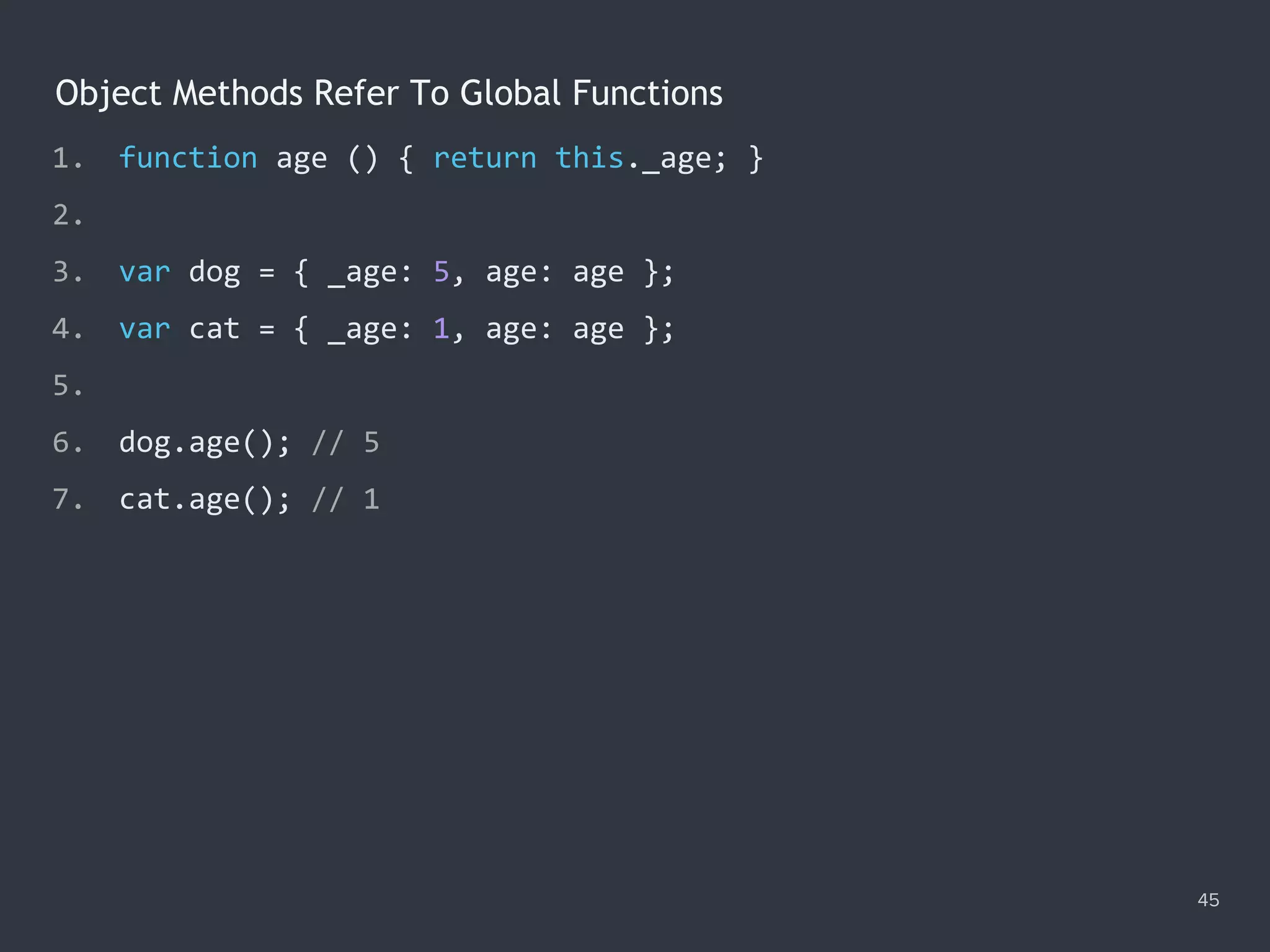
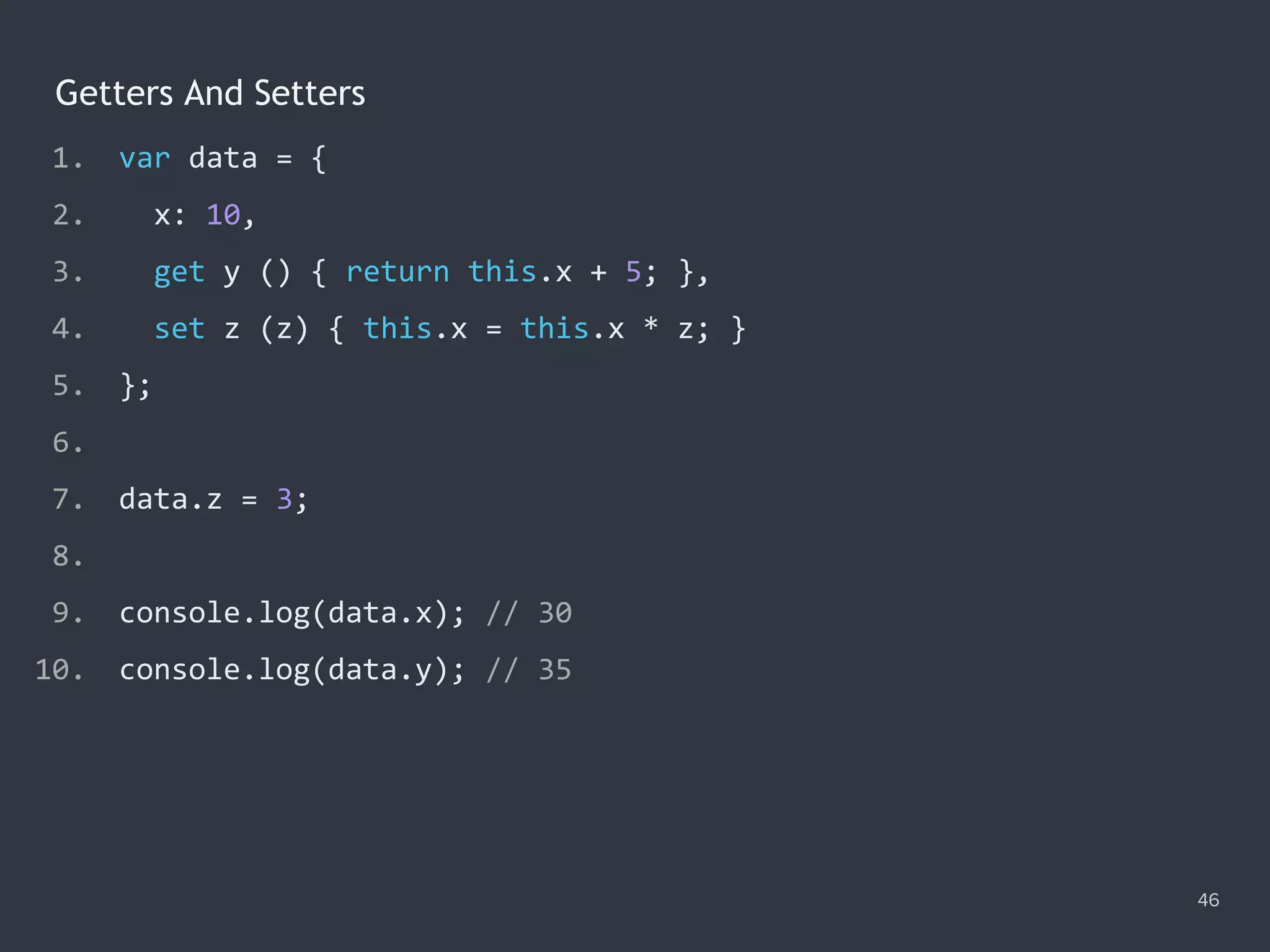
![Method Chaining 47 1. [2, 5, 1, 7, 4] 2. .sort(function (a, b) { return a - b }) 3. .reverse() 4. .map(function (n) { return n * 10; }); 5. 6. // (6) [70, 50, 40, 20, 10]](https://image.slidesharecdn.com/practicaljavascriptprogramming-session3-170705052051/75/Practical-JavaScript-Programming-Session-3-8-47-2048.jpg)
![Chainable Methods 48 1. var list = { 2. items: [3, 8, 5], 3. push: function (value) { 4. this.items.push(value); return this; 5. }, 6. remove: function (value) { 7. var index = this.items.indexOf(value); 8. if (index > -1) { this.items.splice(index, 1); } 9. return this; 10. } 11. }; 12. list.push(7).push(2).remove(8).items; 13. // (4) [3, 5, 7, 2]](https://image.slidesharecdn.com/practicaljavascriptprogramming-session3-170705052051/75/Practical-JavaScript-Programming-Session-3-8-48-2048.jpg)
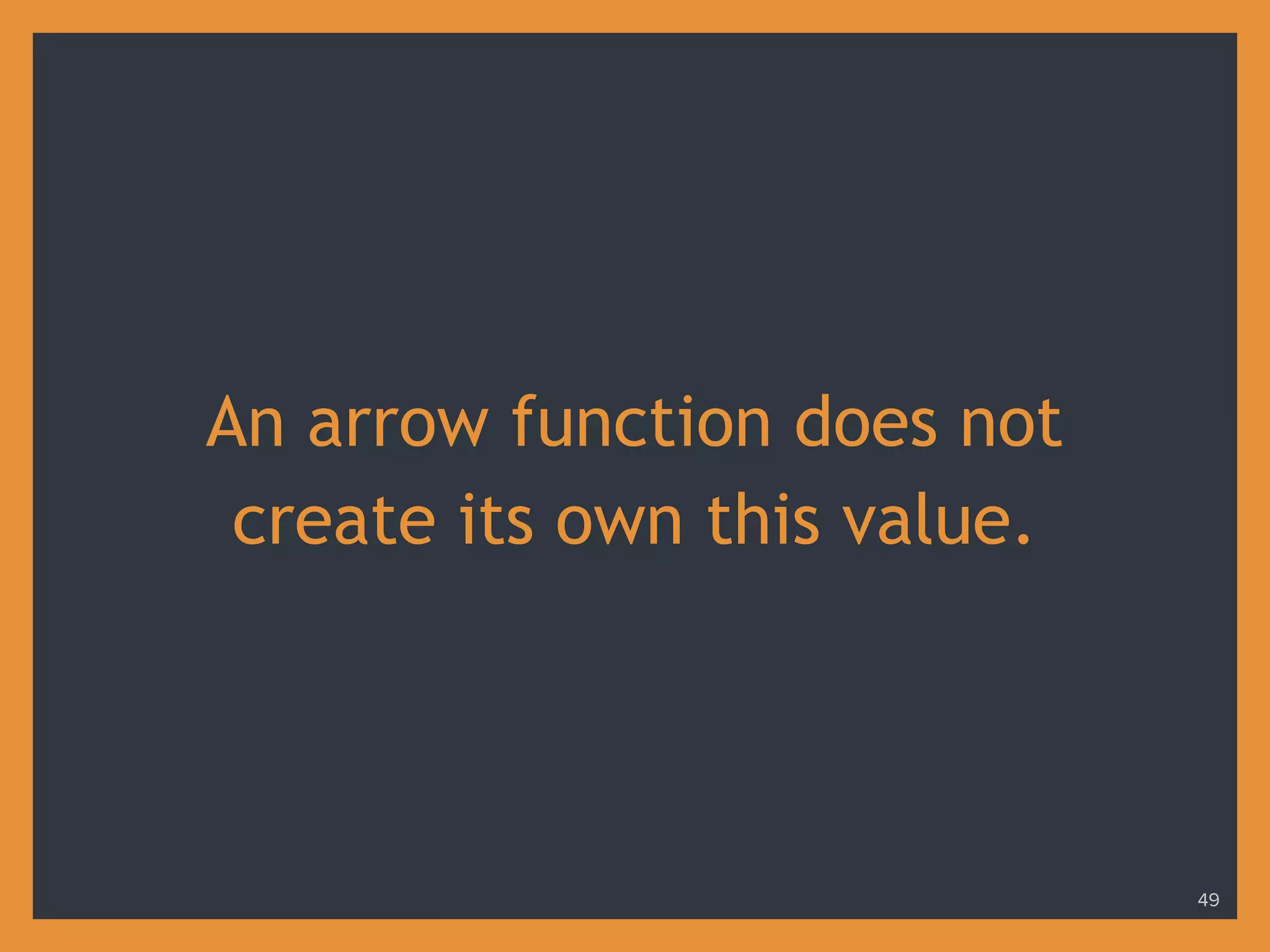
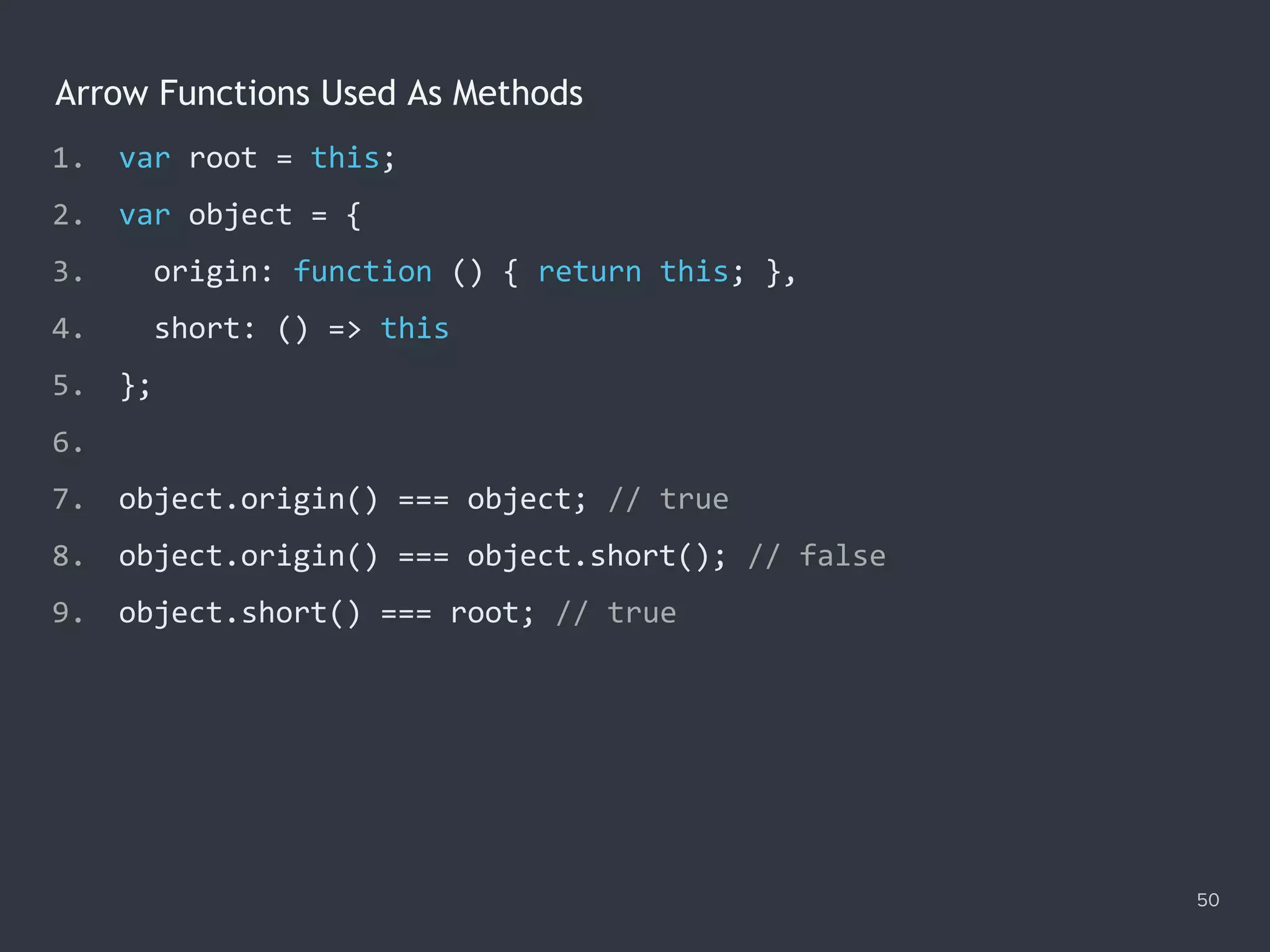
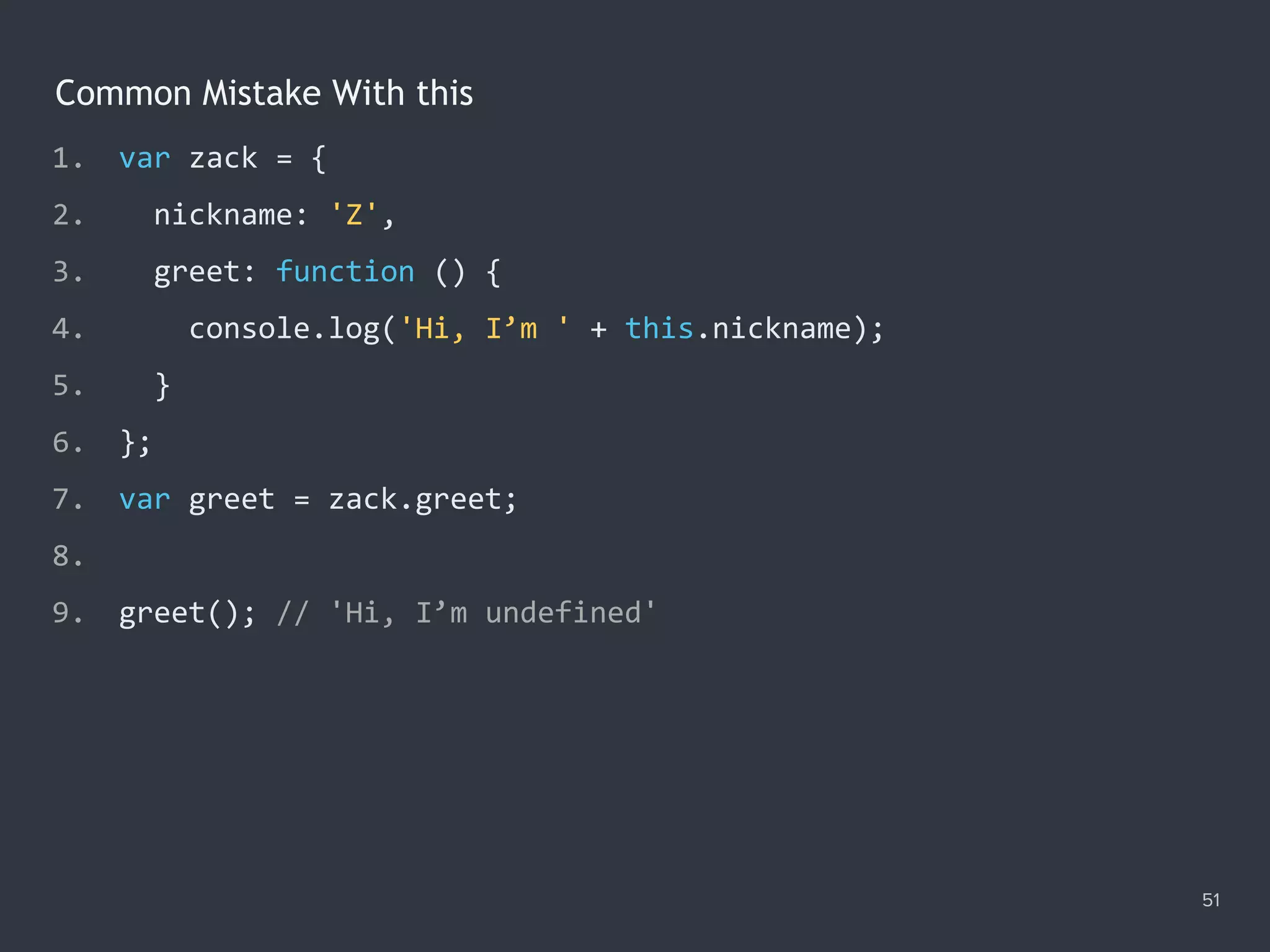

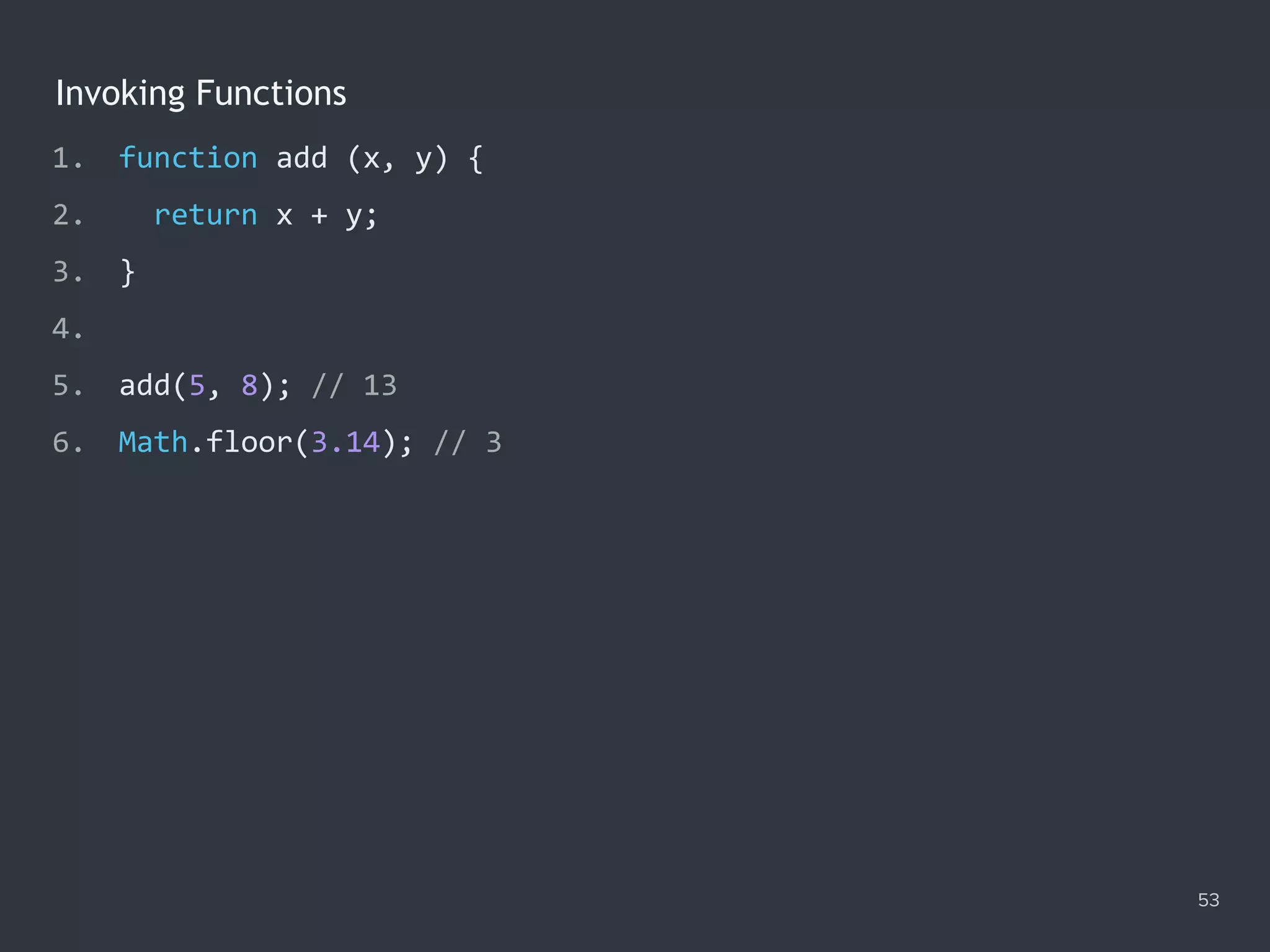
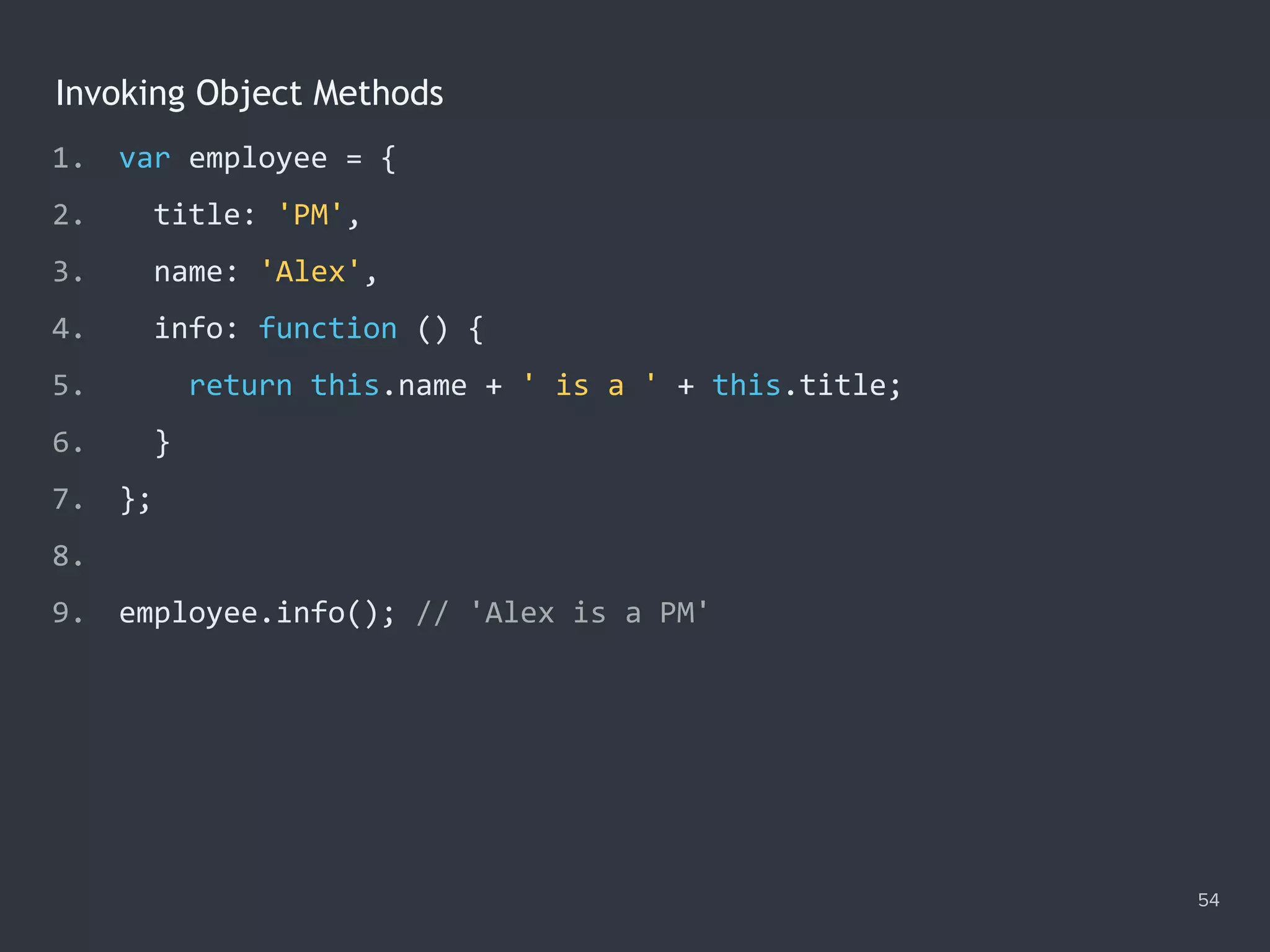
![Function Call 55 1. var name = 'Window'; 2. var jack = { name: 'Jack' }, nick = { name: 'Nick' }; 3. 4. function whoami () { return this.name; } 5. 6. whoami(); // 'Window' 7. whoami.call(this); // 'Window' 8. whoami.call(jack); // 'Jack' 9. whoami.call(nick); // 'Nick' 10. 11. [1, 2].concat.call([3, 4], [5, 6]); // ? 1. var name = 'Window'; 2. var jack = { name: 'Jack' }, nick = { name: 'Nick' }; 3. 4. function whoami () { return this.name; } 5. 6. whoami(); // 'Window' 7. whoami.call(this); // 'Window' 8. whoami.call(jack); // 'Jack' 9. whoami.call(nick); // 'Nick' 10. 11. [1, 2].concat.call([3, 4], [5, 6]); // (4) [3, 4, 5, 6]](https://image.slidesharecdn.com/practicaljavascriptprogramming-session3-170705052051/75/Practical-JavaScript-Programming-Session-3-8-55-2048.jpg)
![Function Apply 56 1. Math.max(5, 2, 7, 4); // 7 2. Math.max.apply(null, [9, 1, 3, 6]); // 9 3. 4. function sum () { 5. return [].slice.call(arguments, 0).reduce((a, b) => a + b); 6. } 7. 8. sum.apply(null, [1, 2, 3, 4, 5]); // 15](https://image.slidesharecdn.com/practicaljavascriptprogramming-session3-170705052051/75/Practical-JavaScript-Programming-Session-3-8-56-2048.jpg)
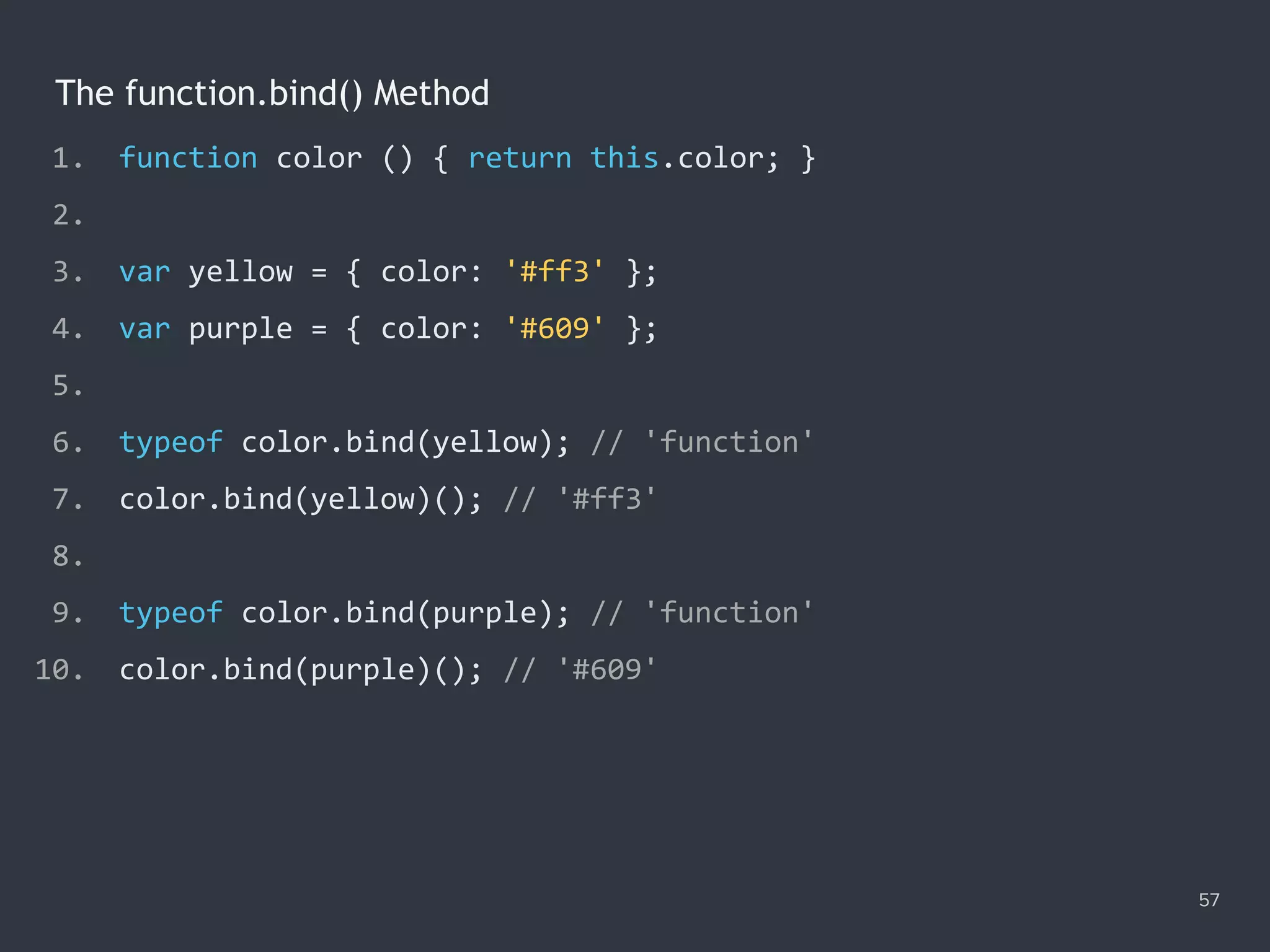
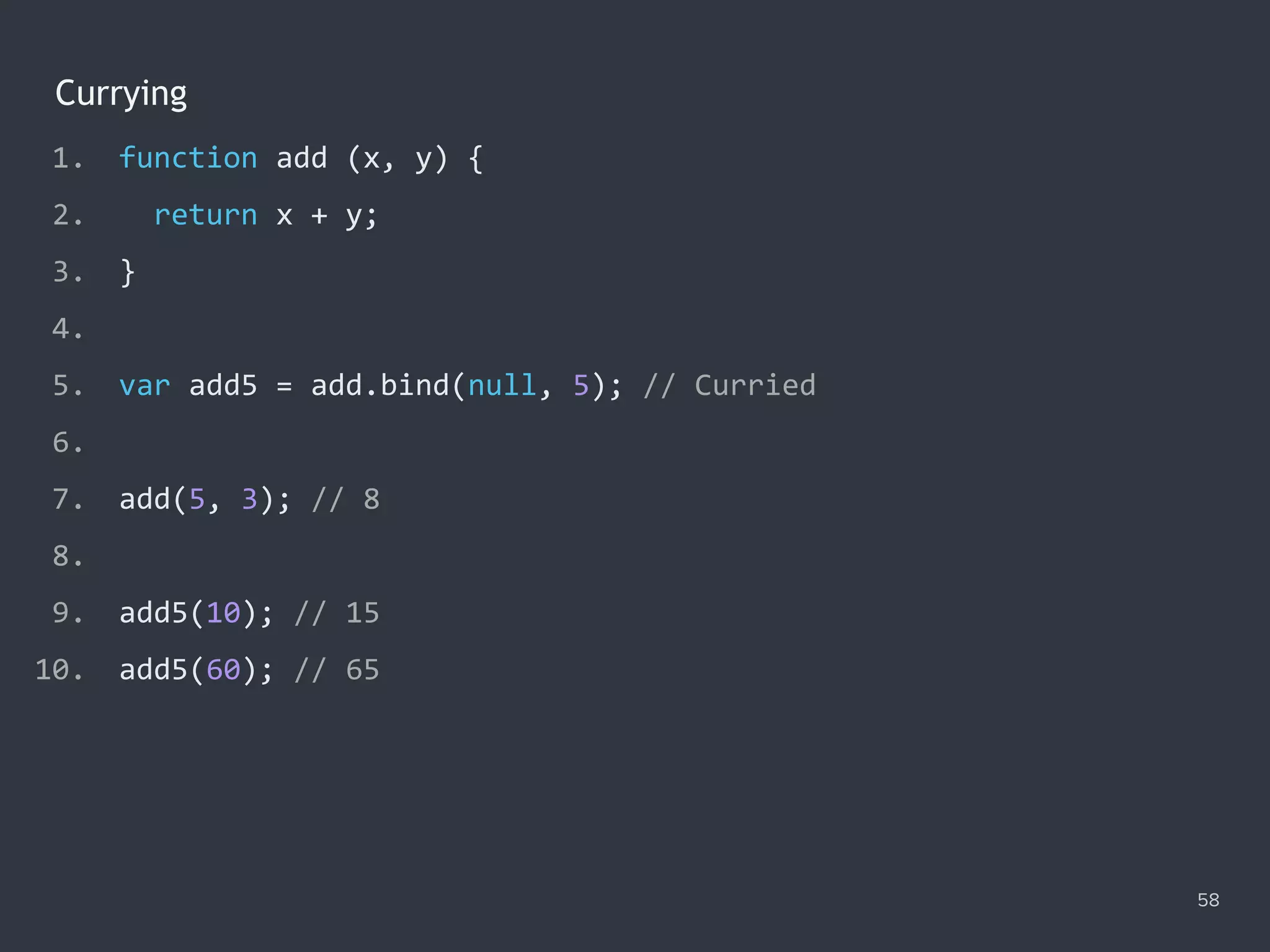
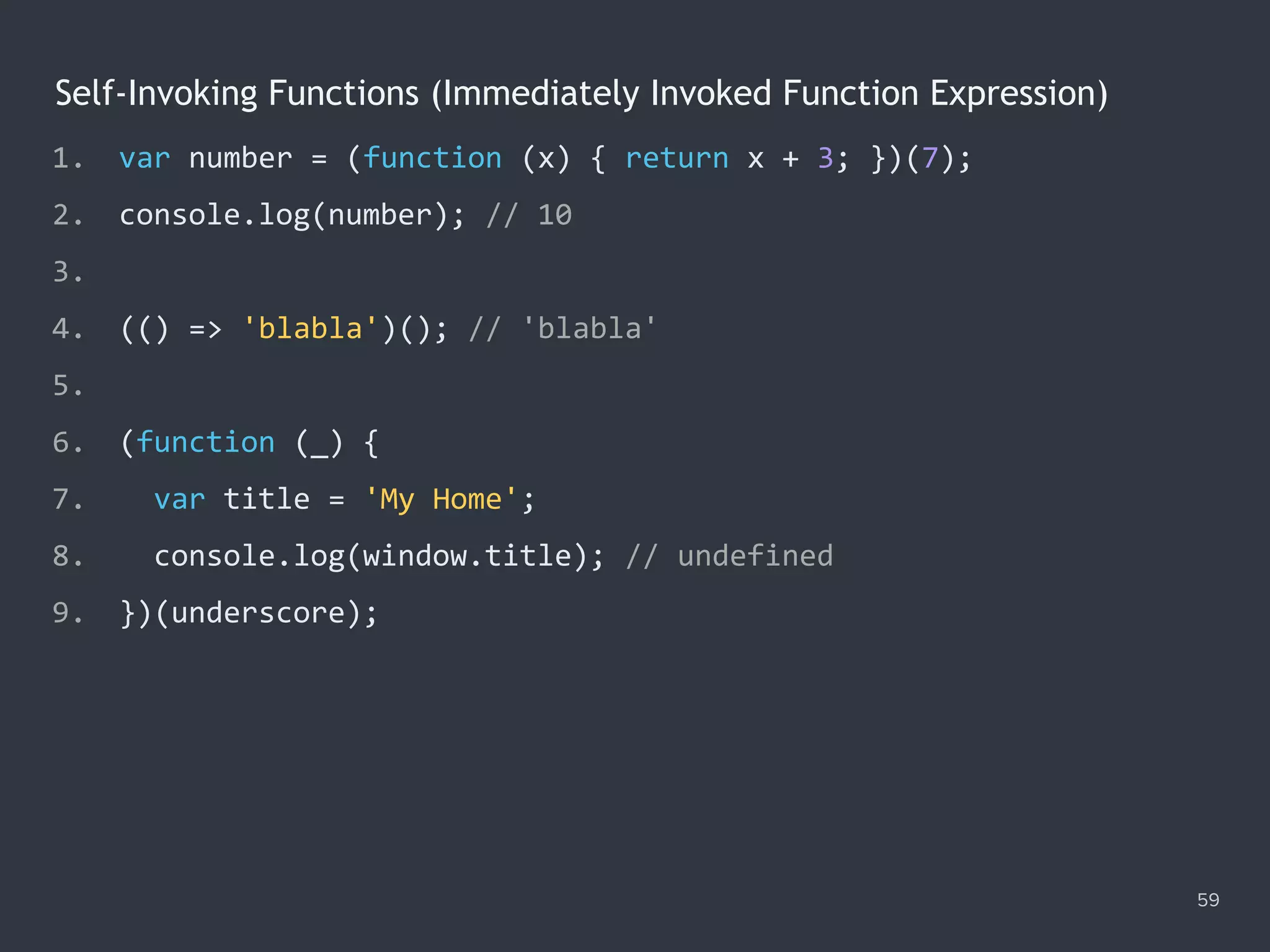

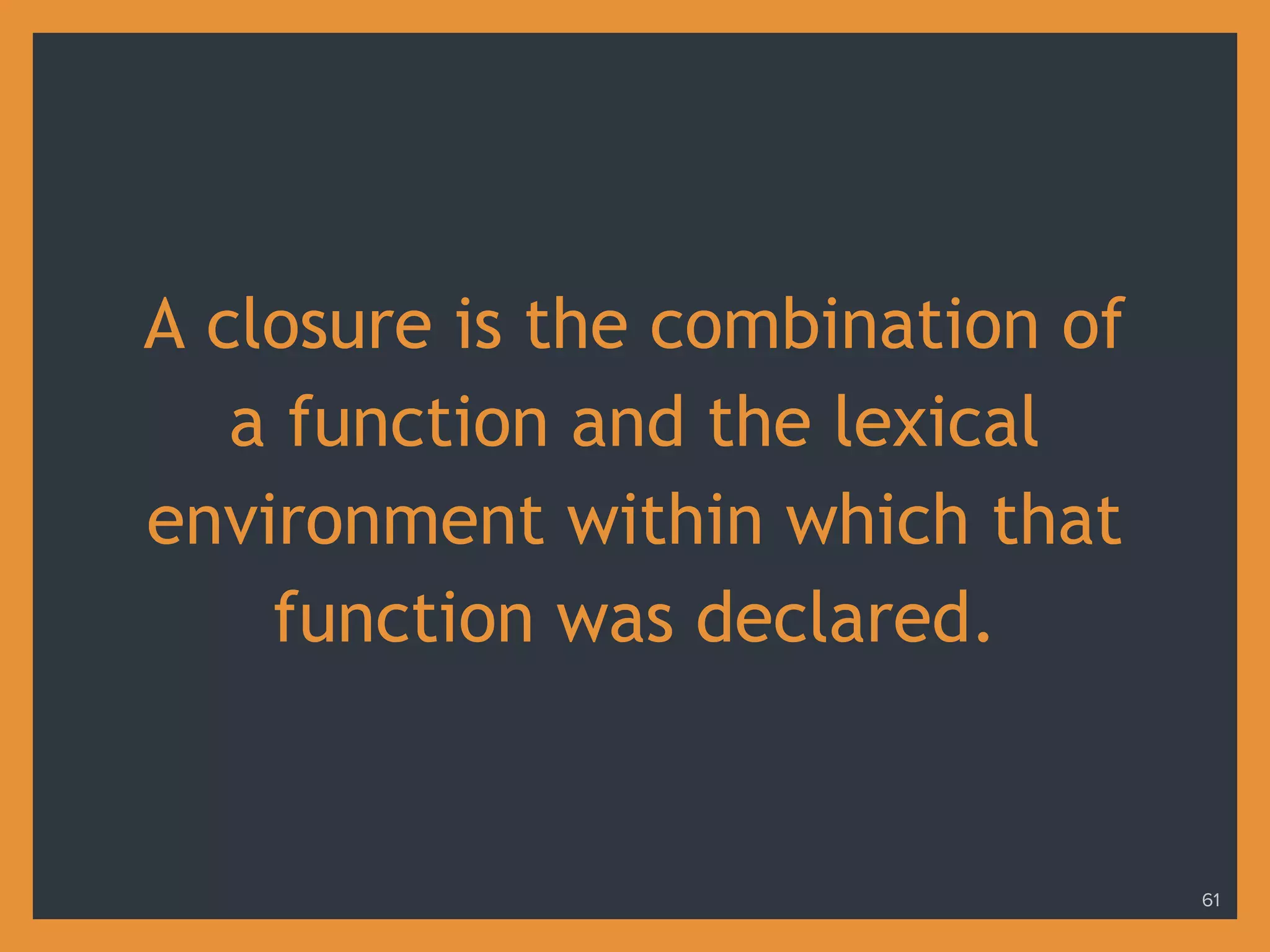
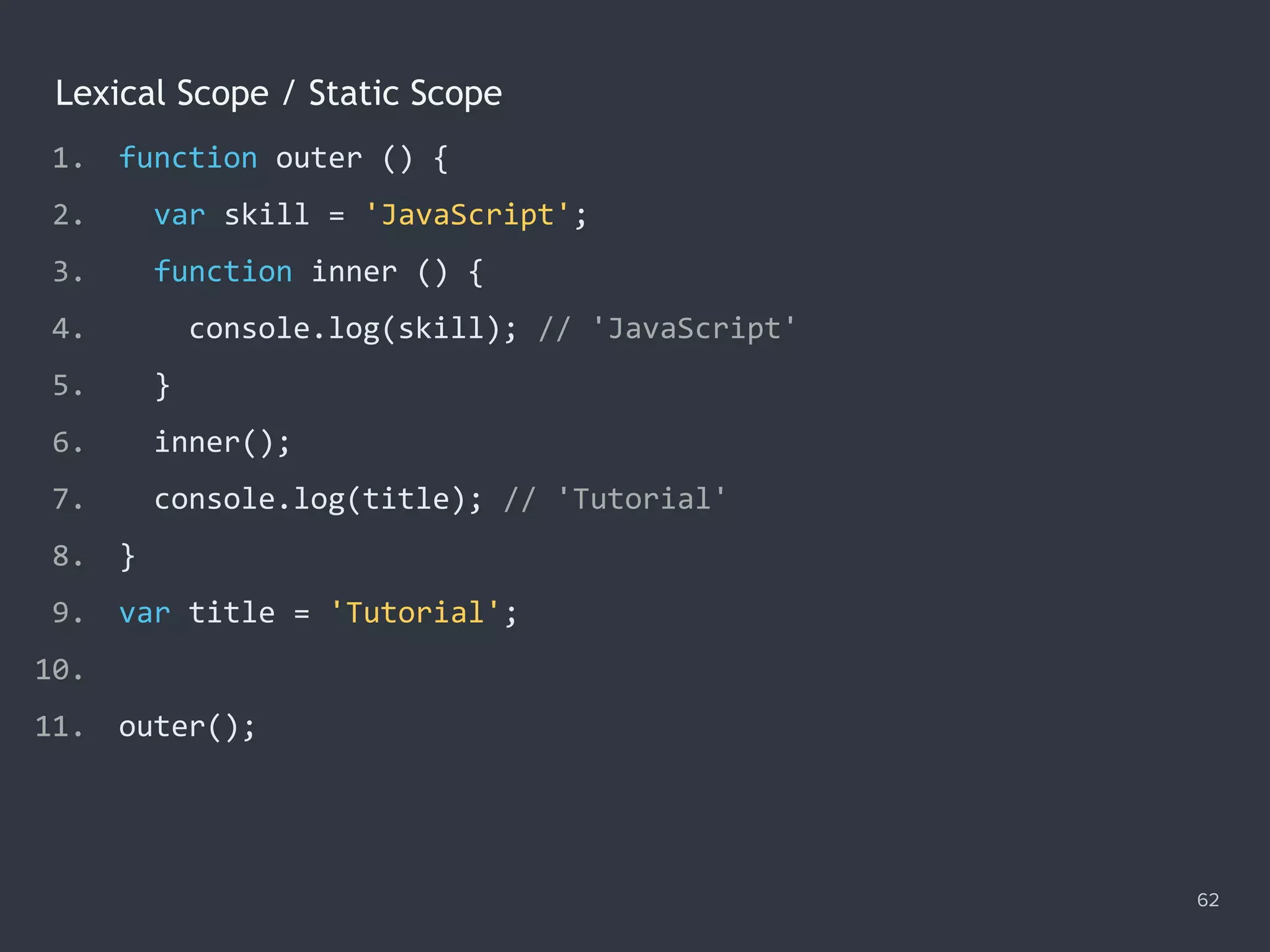
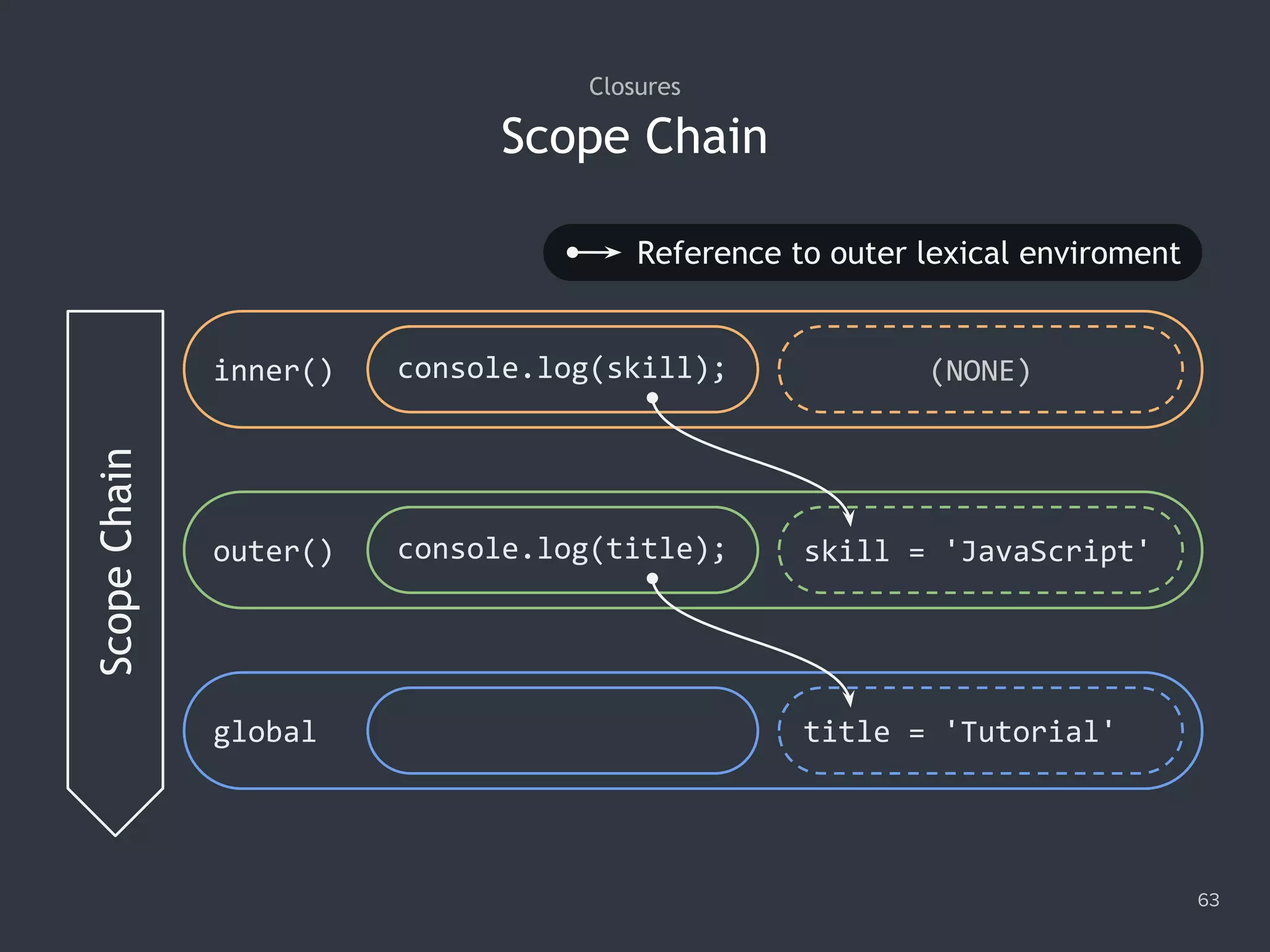
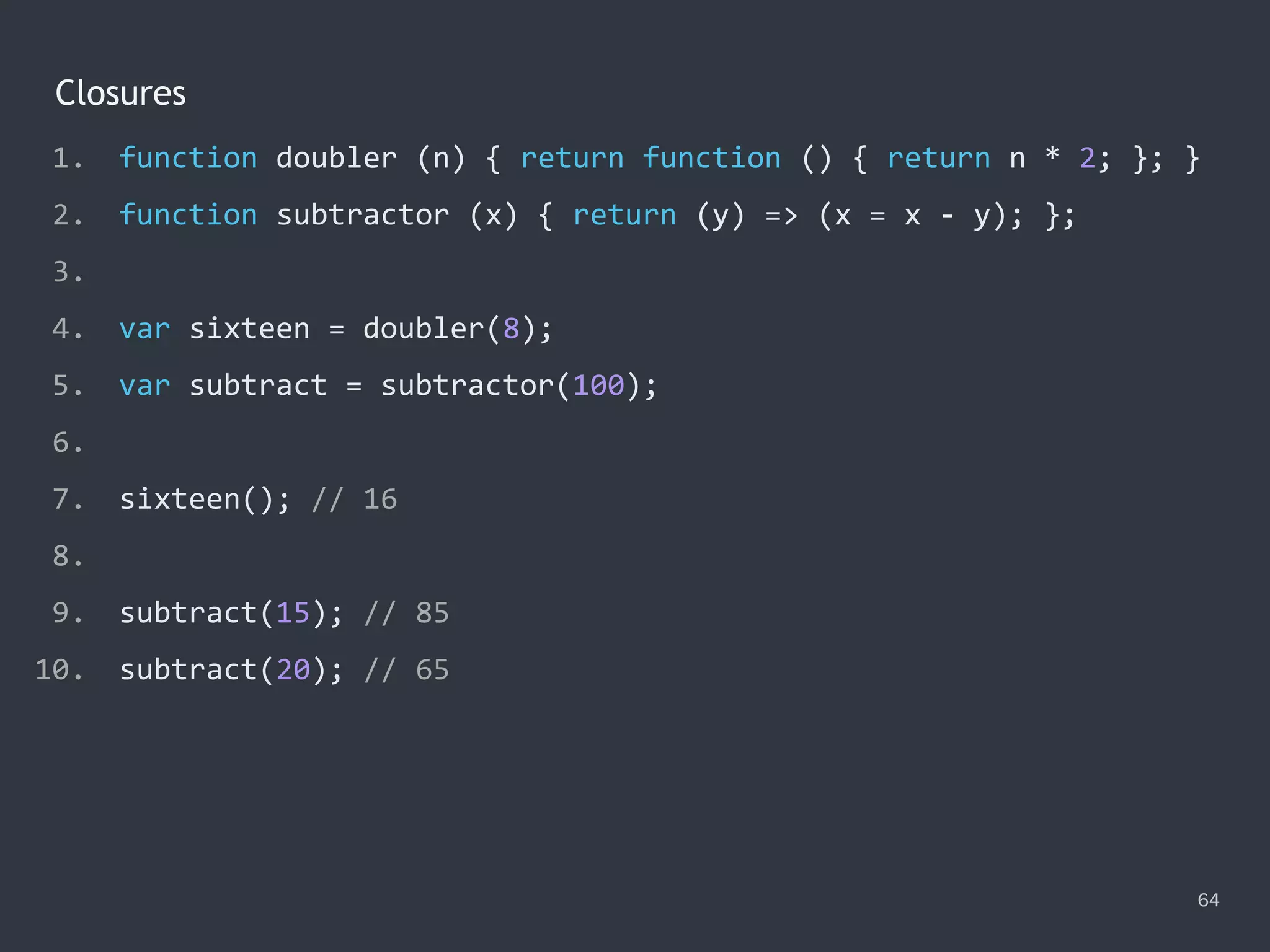
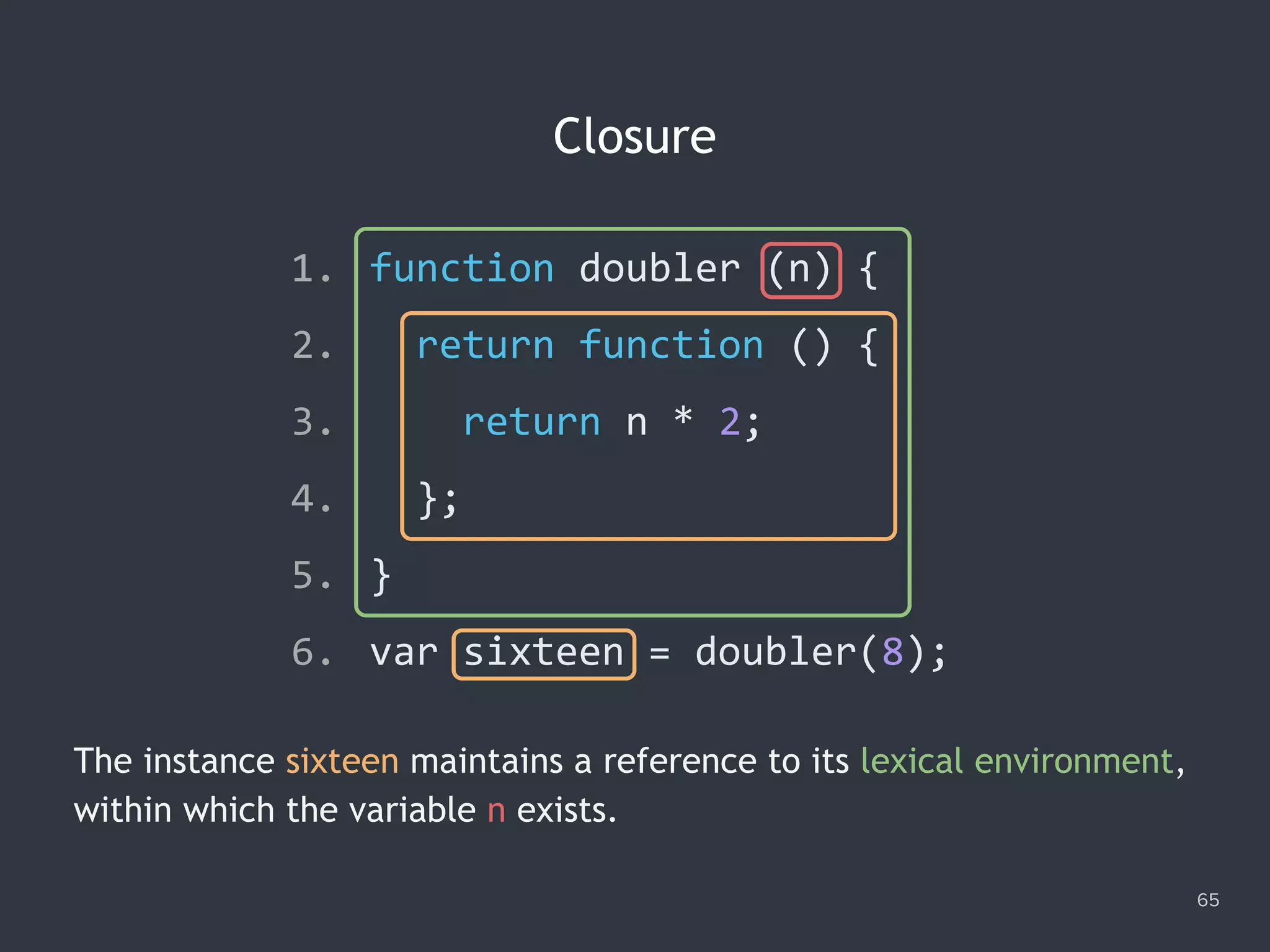
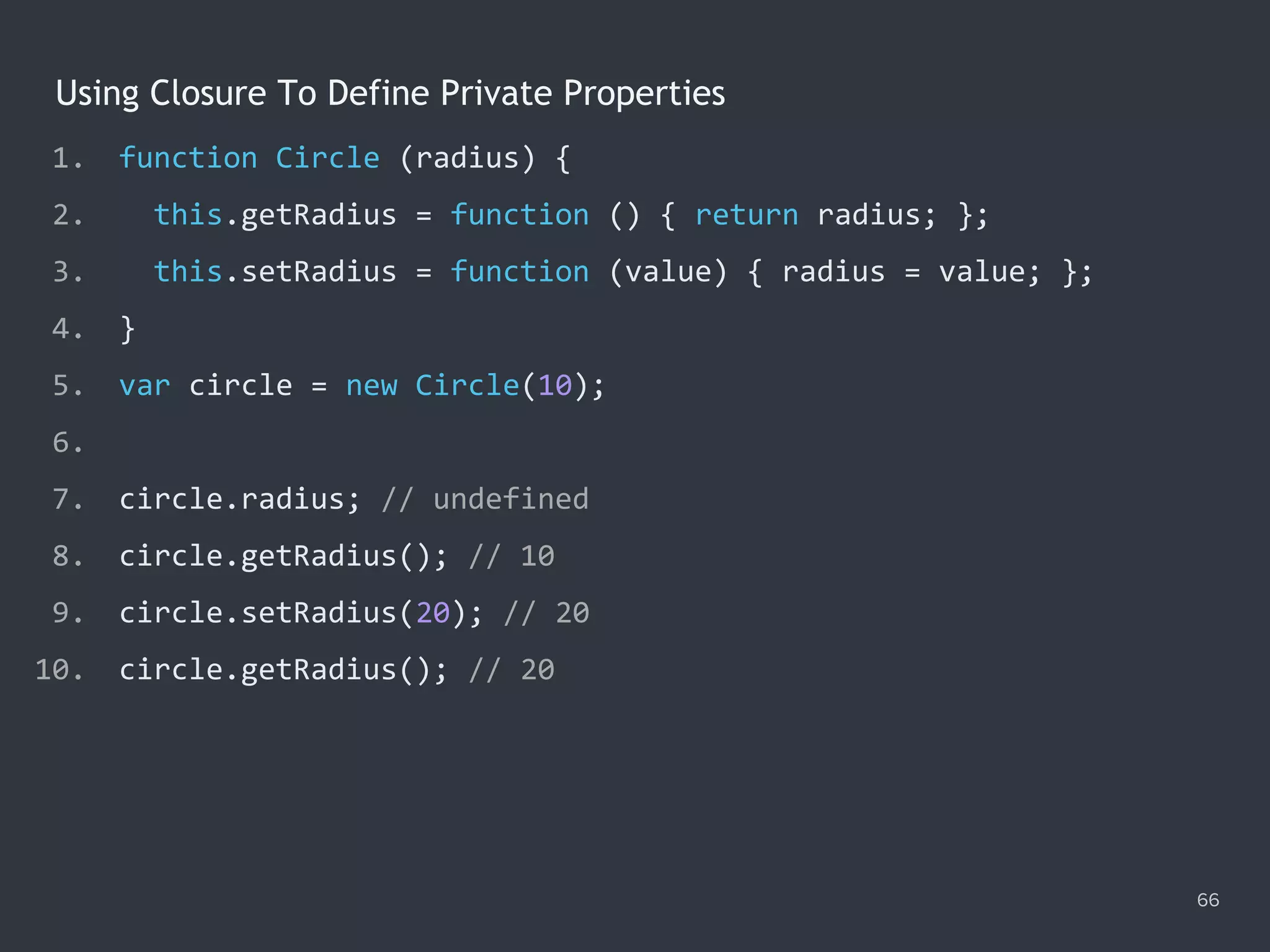
![A Common Mistake With Closure 67 1. var i = 0, fn = {}; 2. 3. for (; i < 5; ++i) { 4. fn['get' + i] = function () { 5. console.log(i); 6. }; 7. } 8. 9. fn.get2(); // ? 1. var i = 0, fn = {}; 2. 3. for (; i < 5; ++i) { 4. fn['get' + i] = function () { 5. console.log(i); 6. }; 7. } 8. 9. fn.get2(); // 5](https://image.slidesharecdn.com/practicaljavascriptprogramming-session3-170705052051/75/Practical-JavaScript-Programming-Session-3-8-67-2048.jpg)


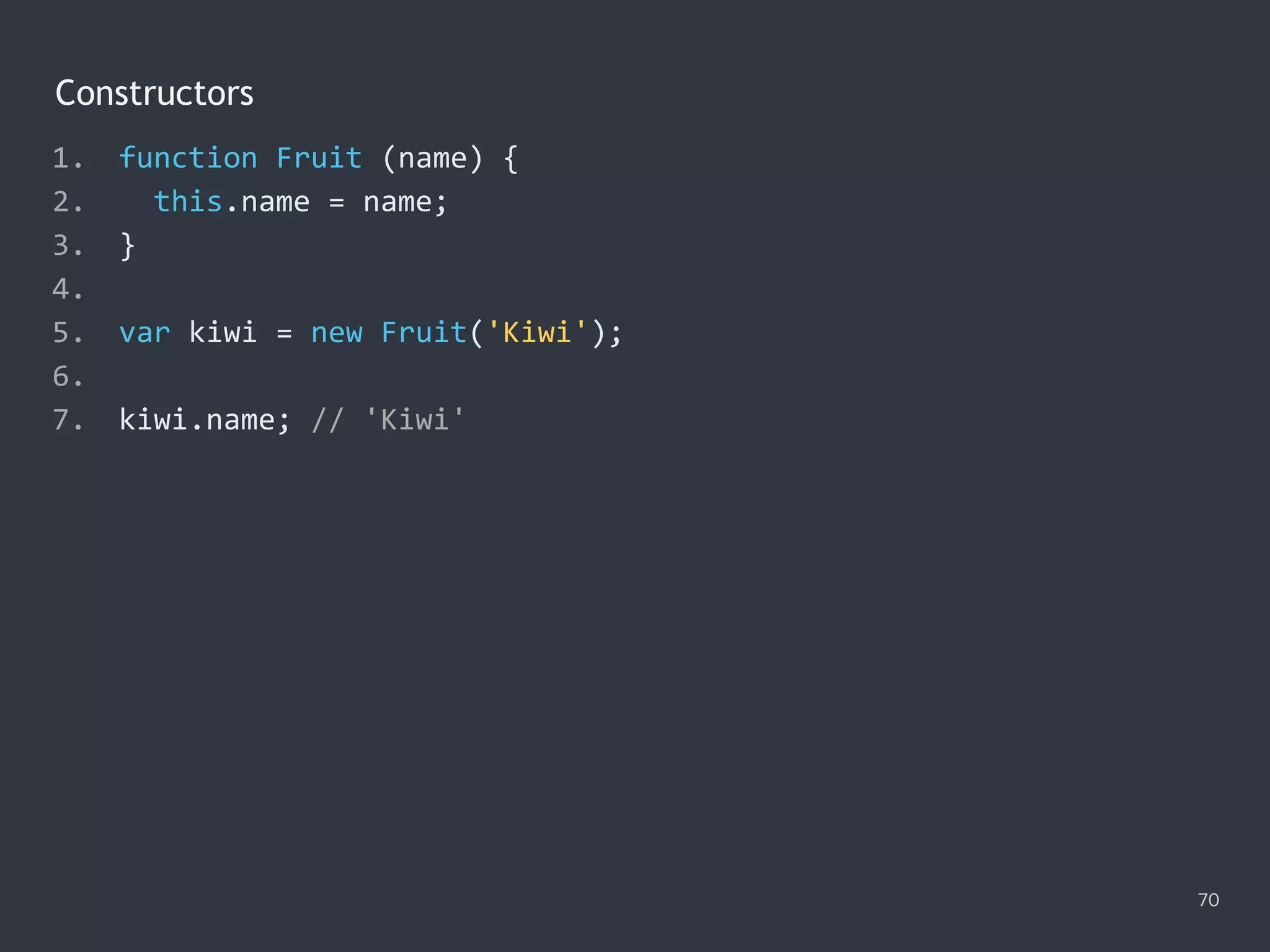
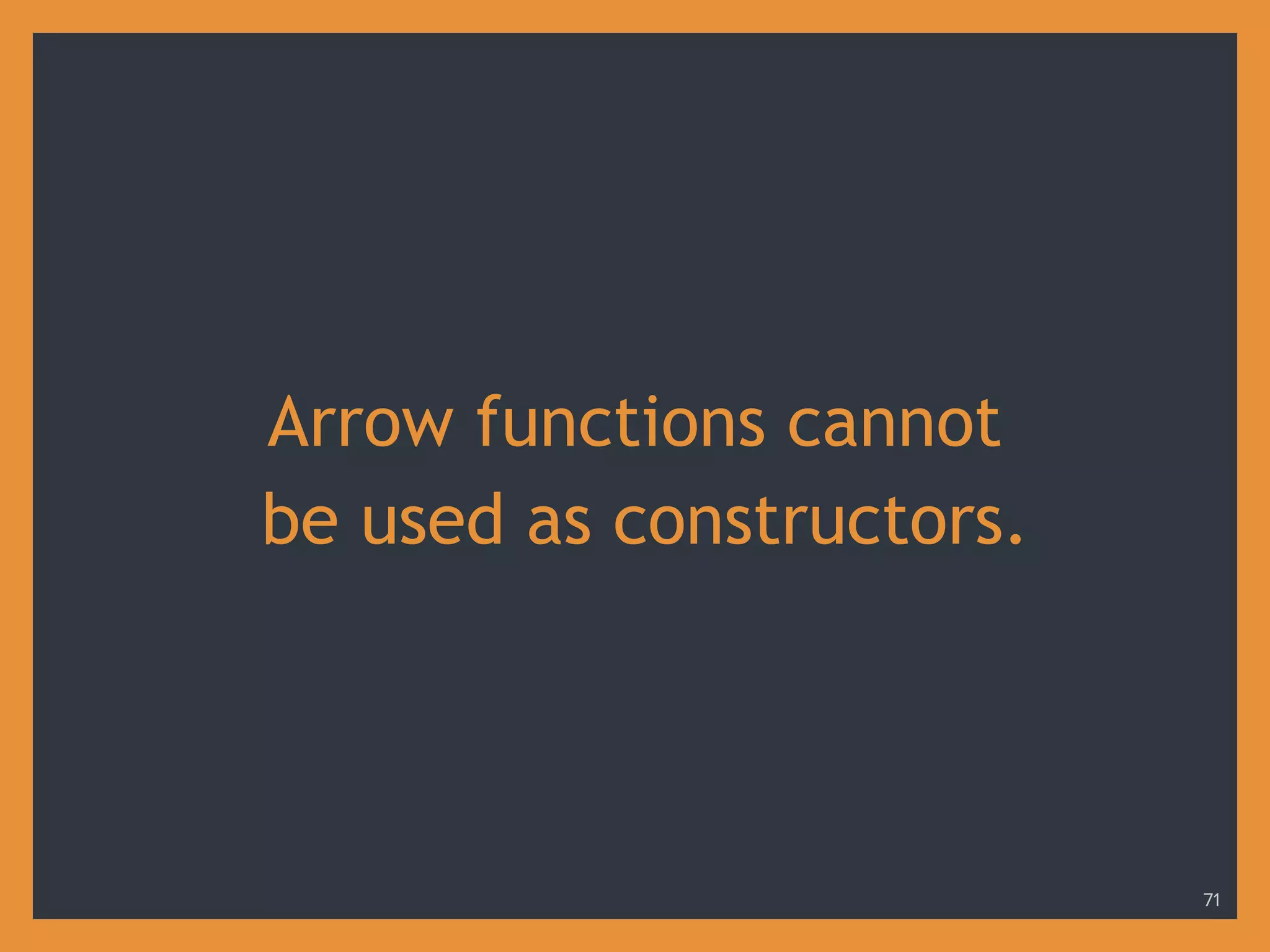
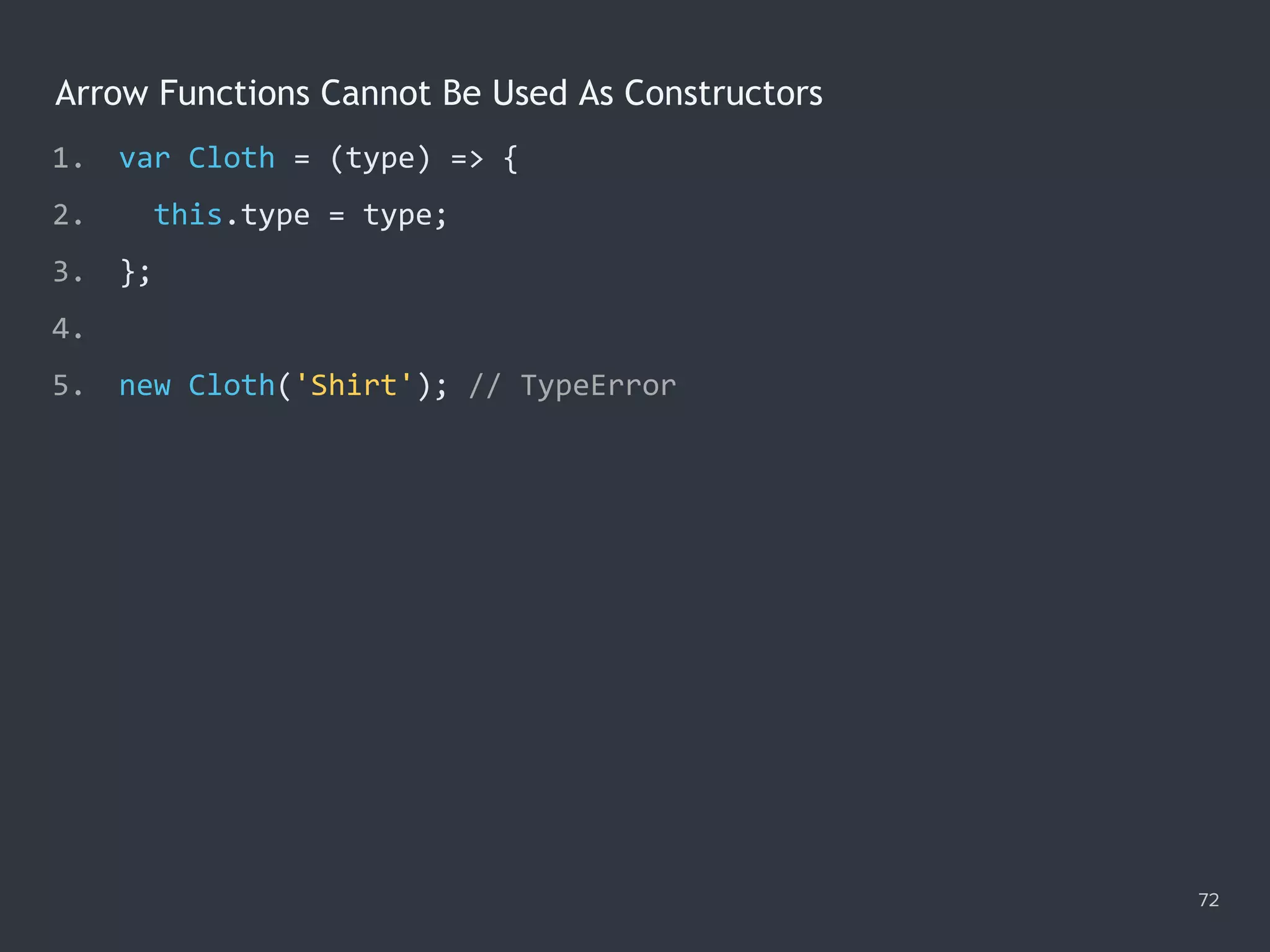

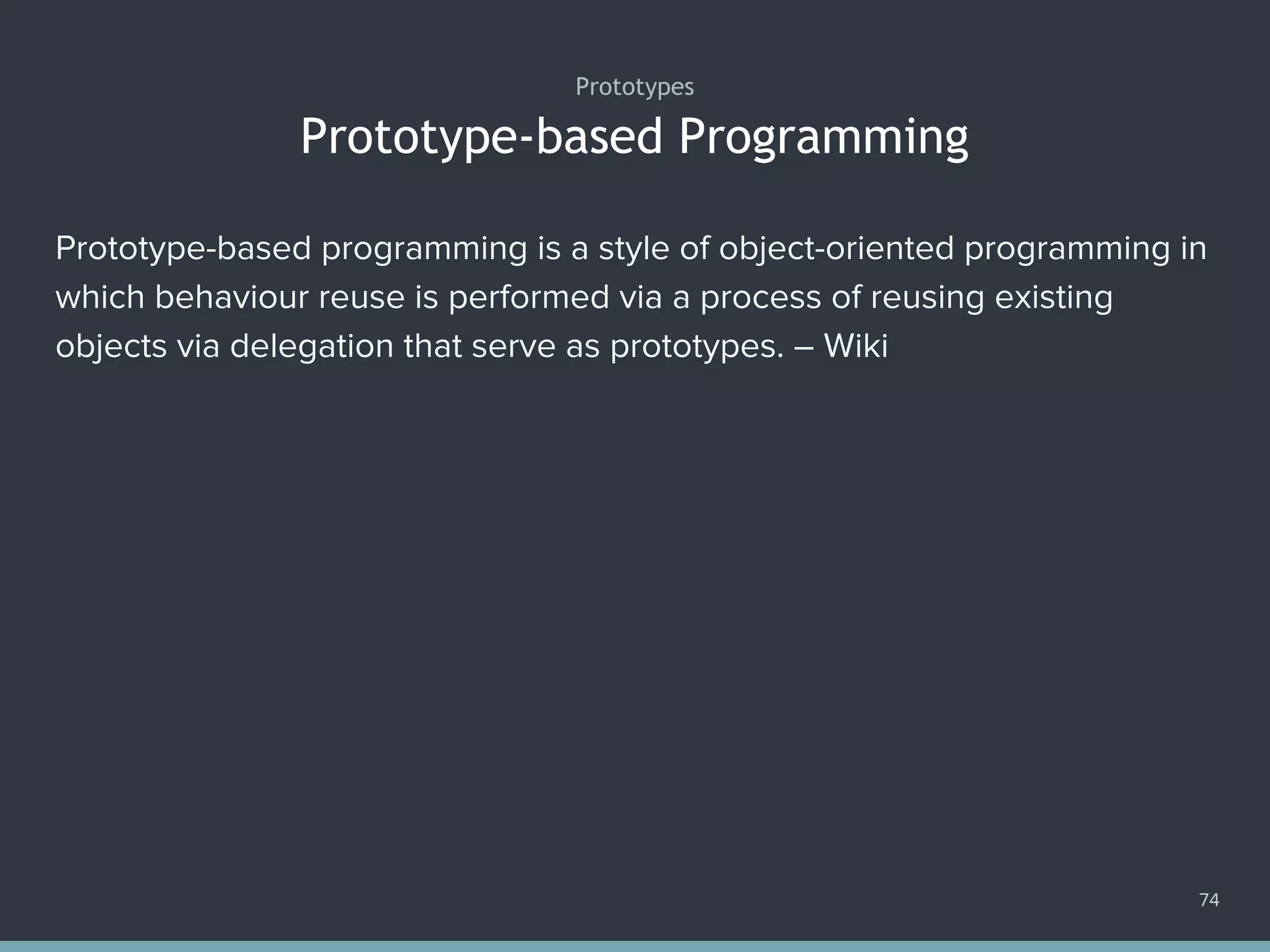
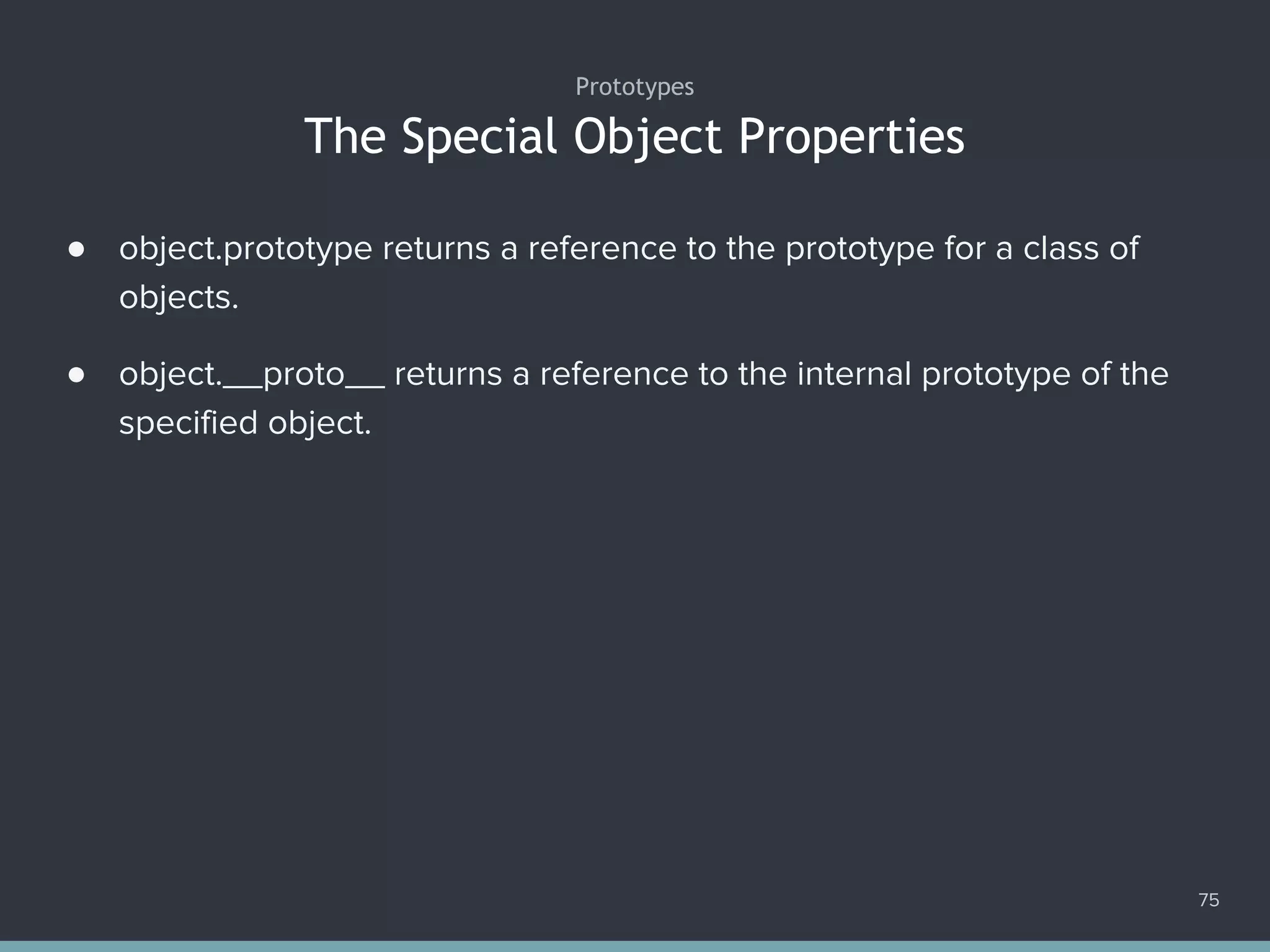
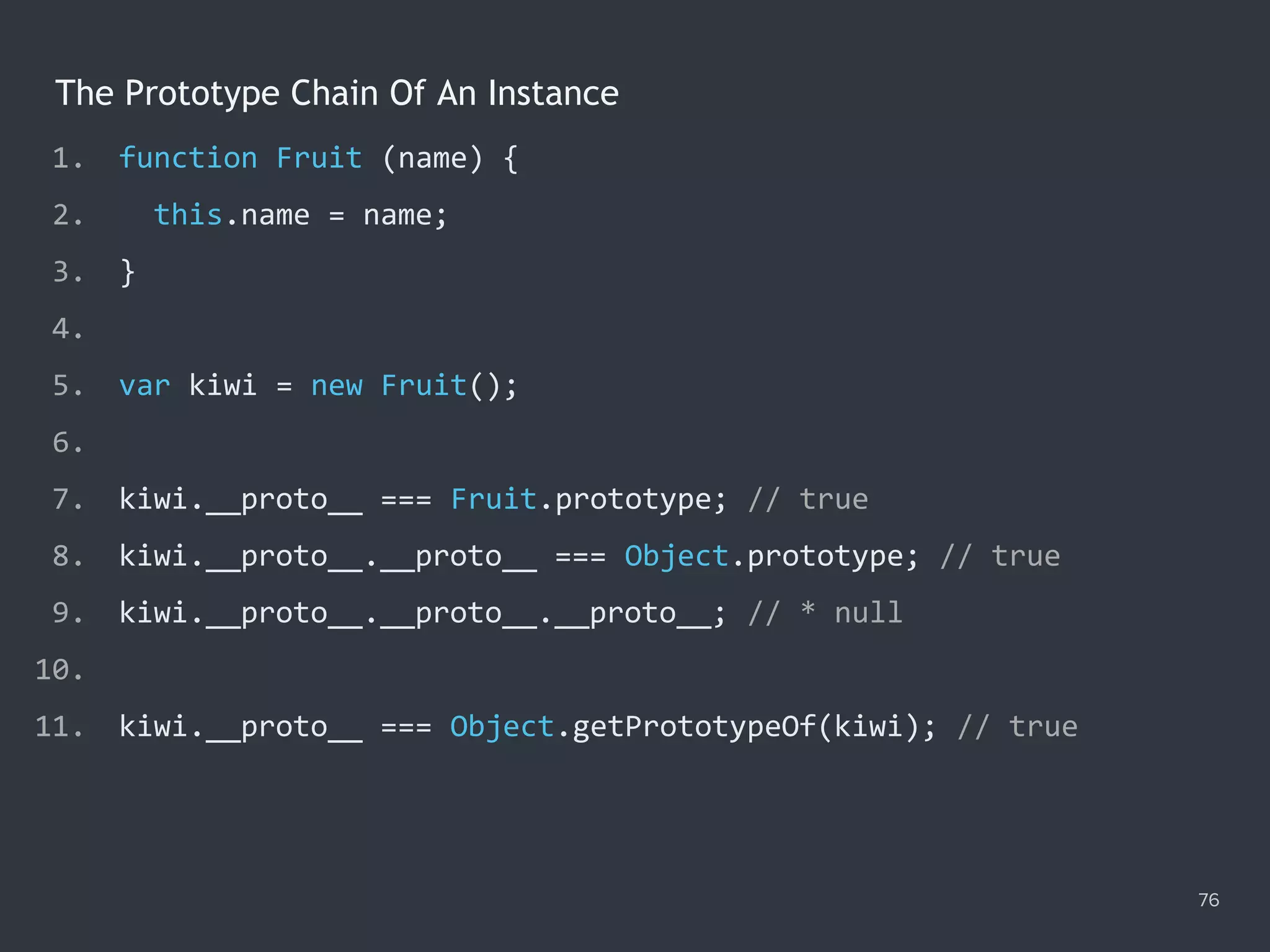
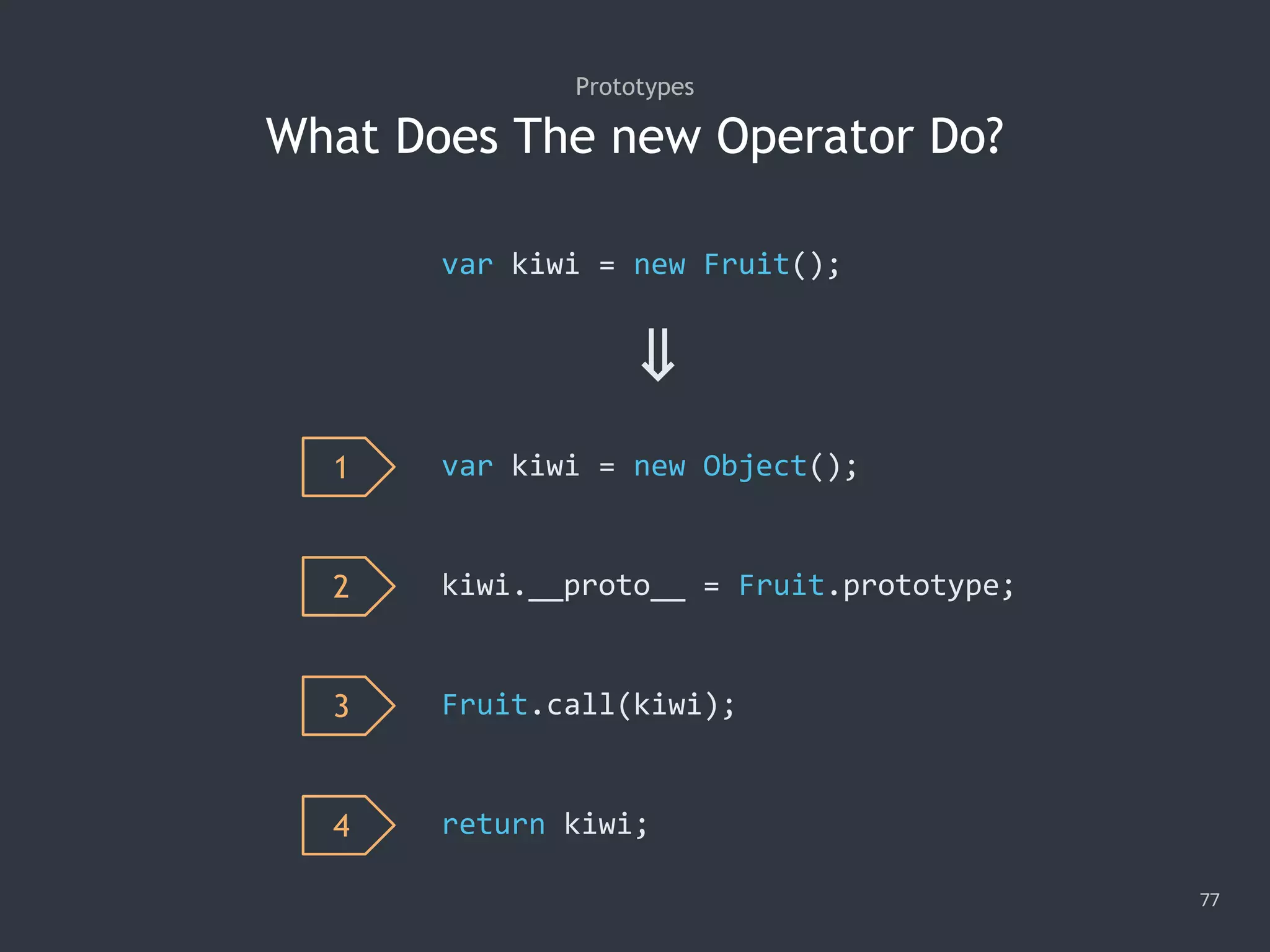
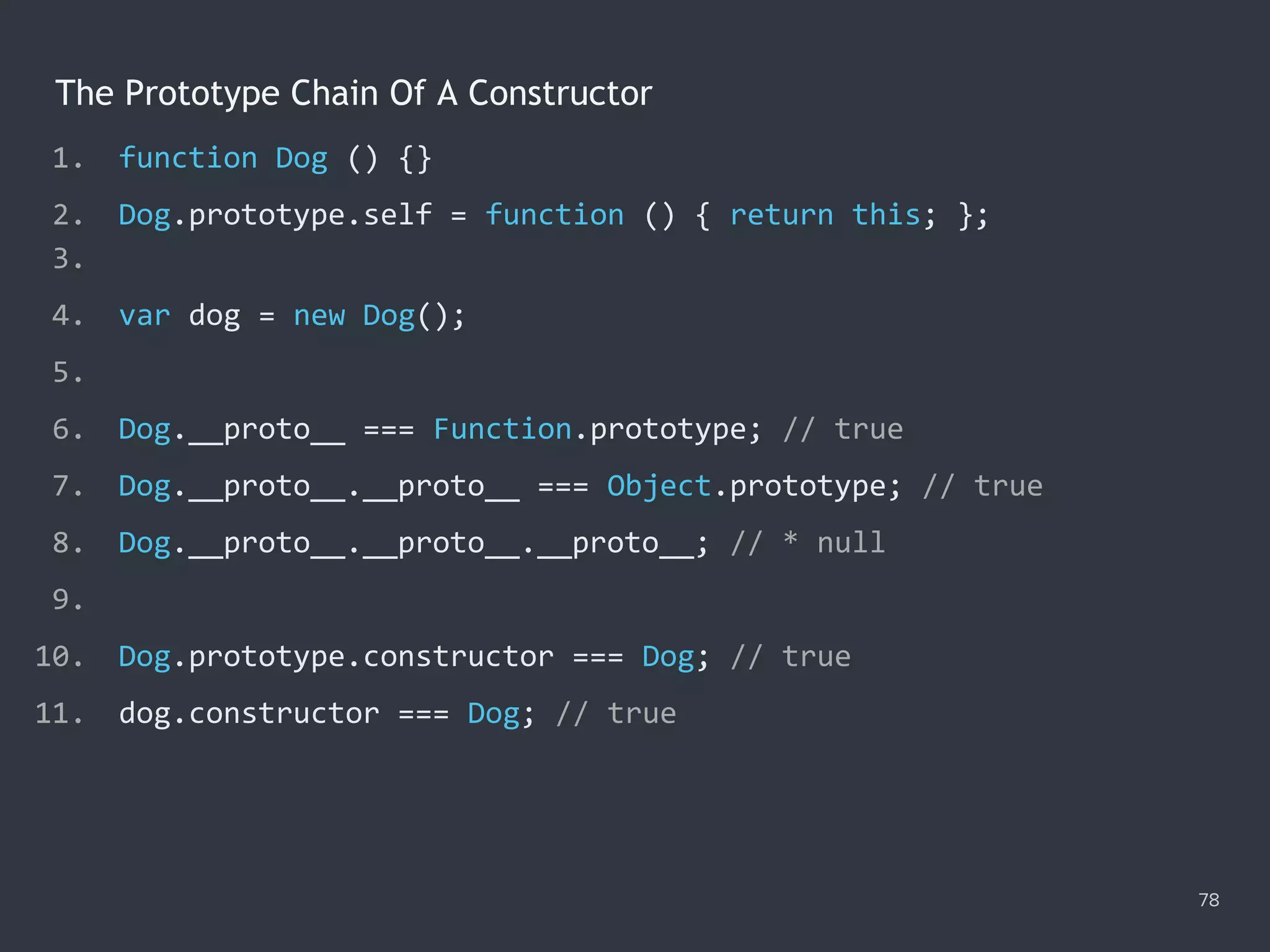
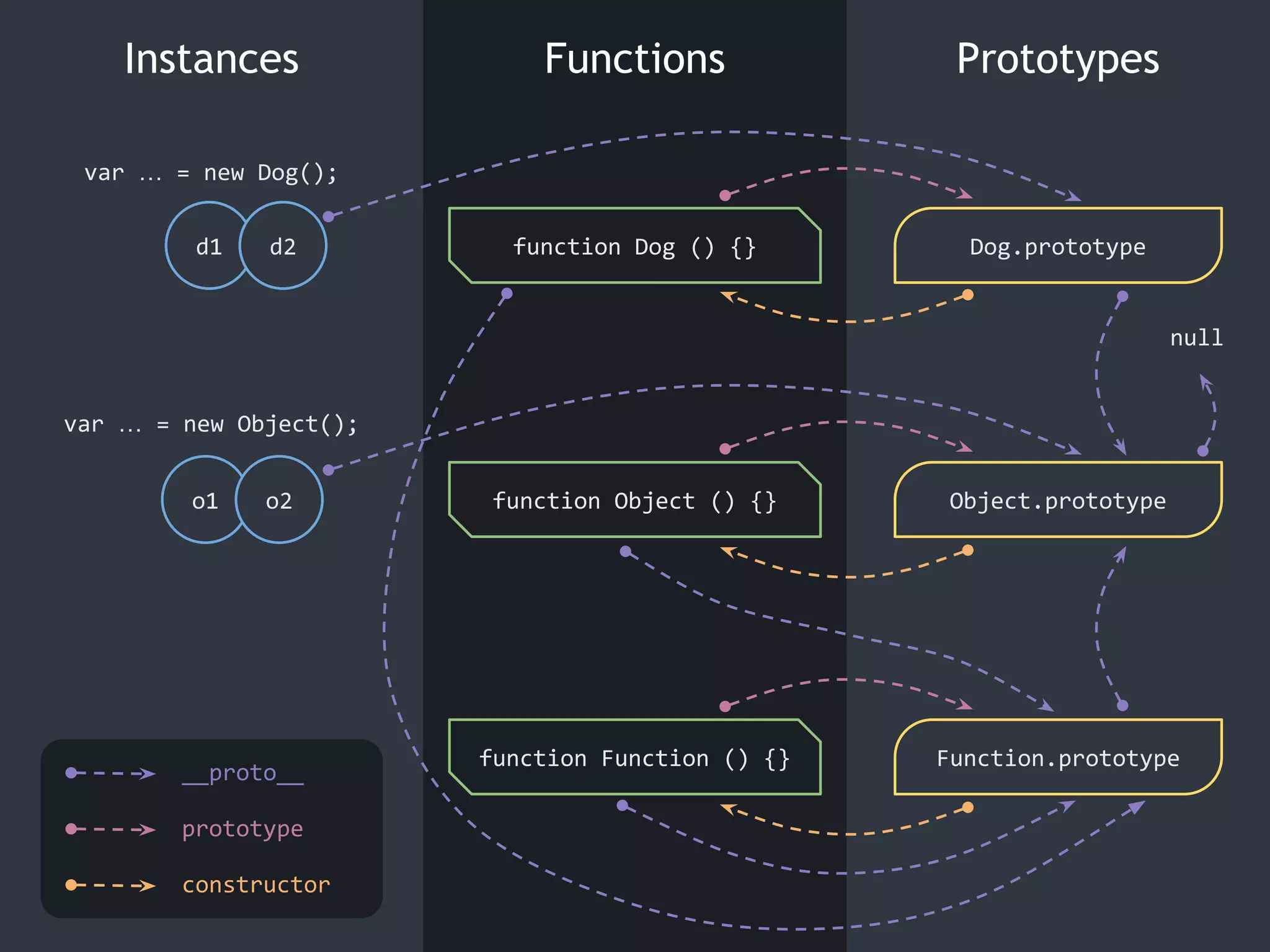
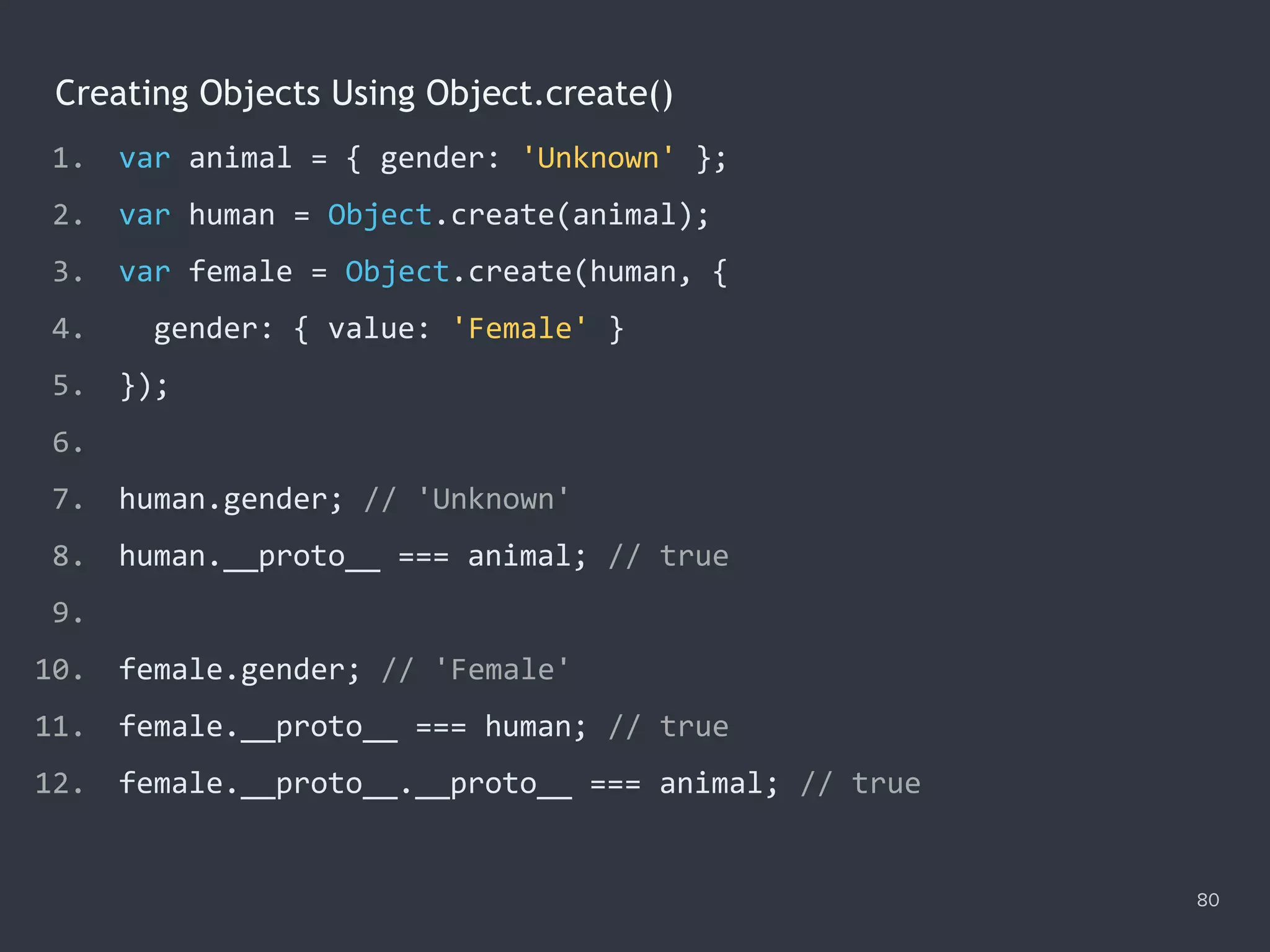
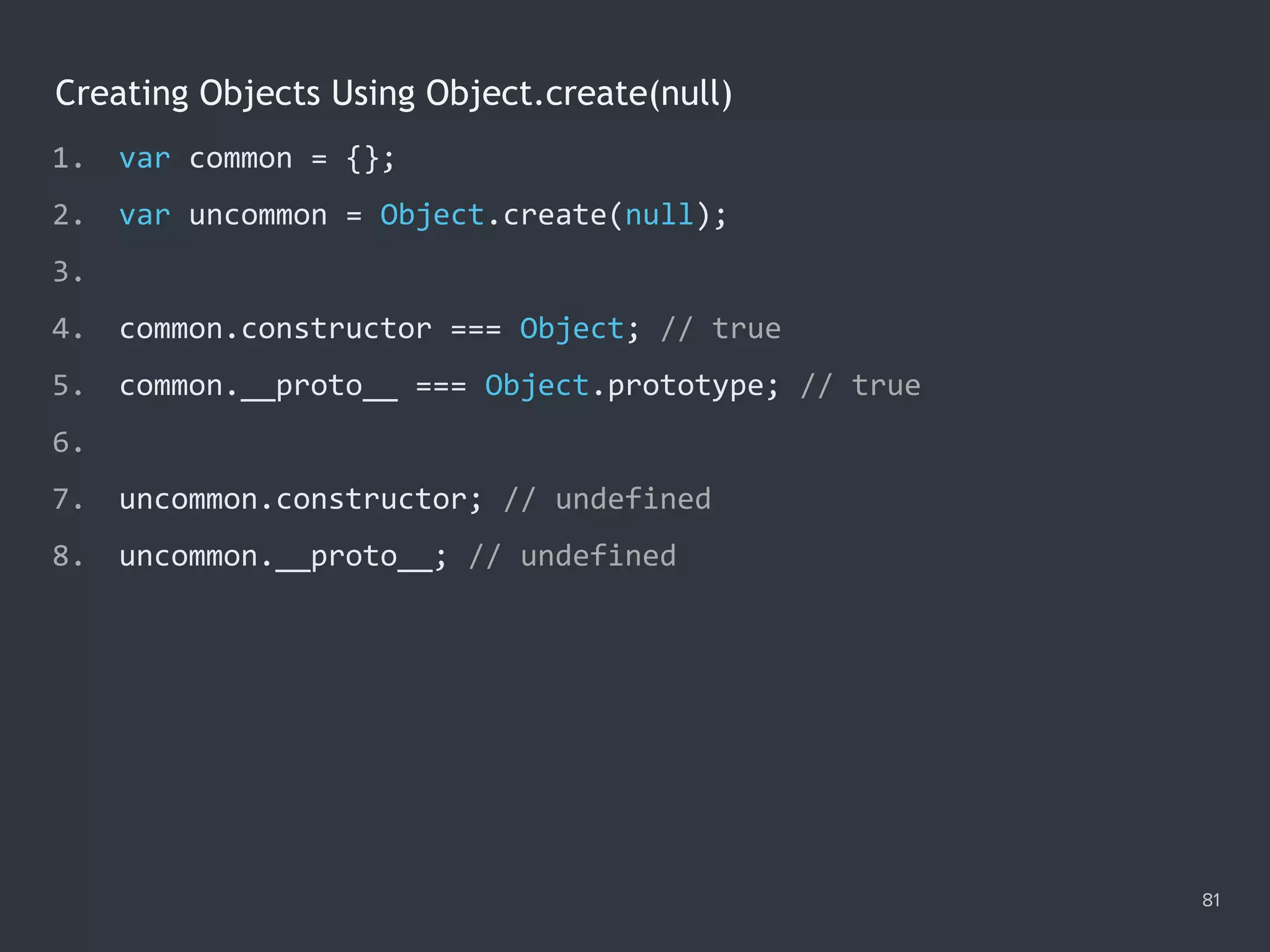
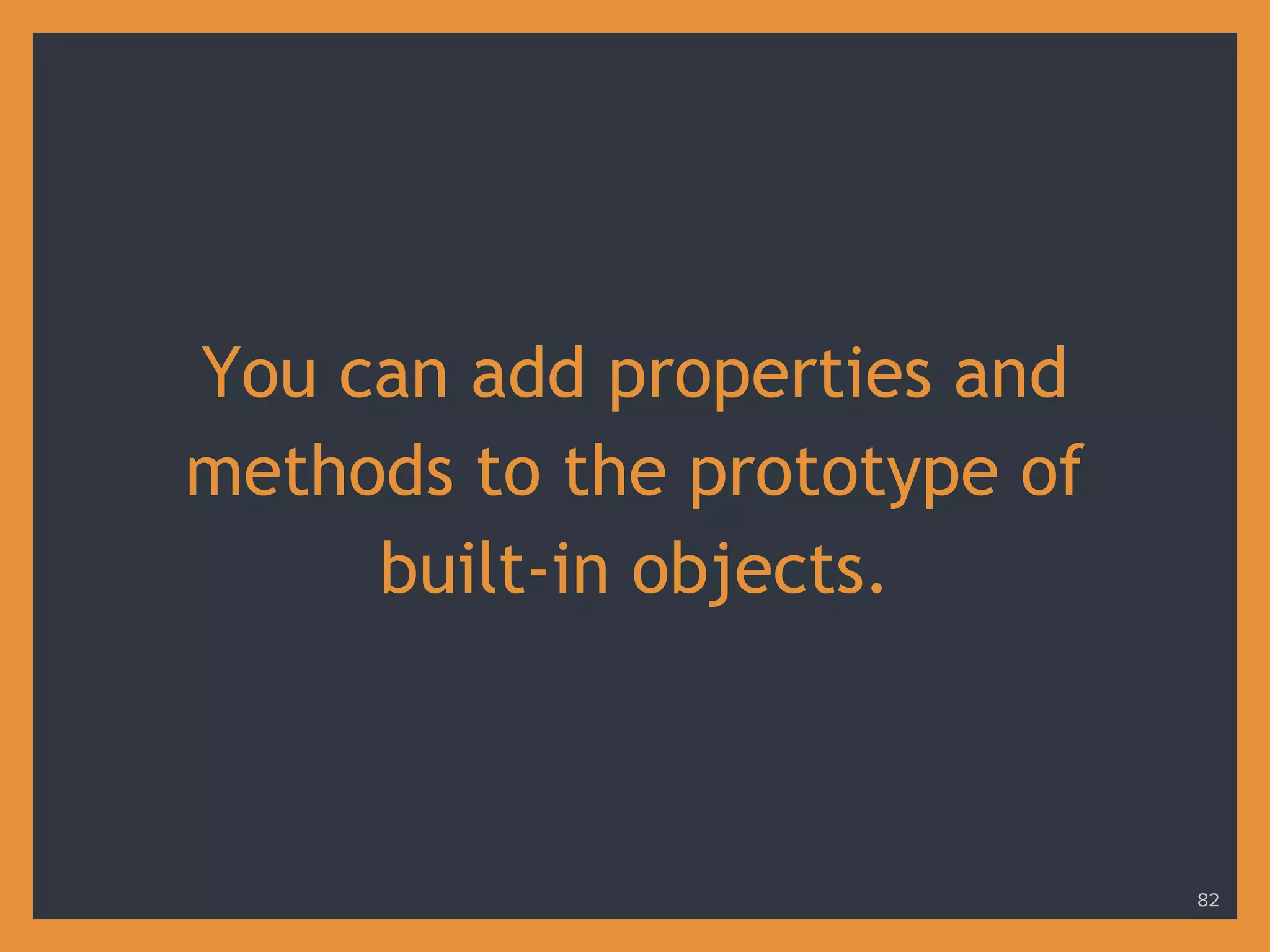
![Adding Methods To Array.prototype 83 1. Array.prototype.first = function () { 2. return this[0]; 3. }; 4. 5. Array.prototype.last = function () { 6. return this[this.length - 1]; 7. }; 8. 9. var numbers = [100, 200, 300]; 10. 11. numbers.first(); // 100 12. numbers.last(); // 300](https://image.slidesharecdn.com/practicaljavascriptprogramming-session3-170705052051/75/Practical-JavaScript-Programming-Session-3-8-83-2048.jpg)
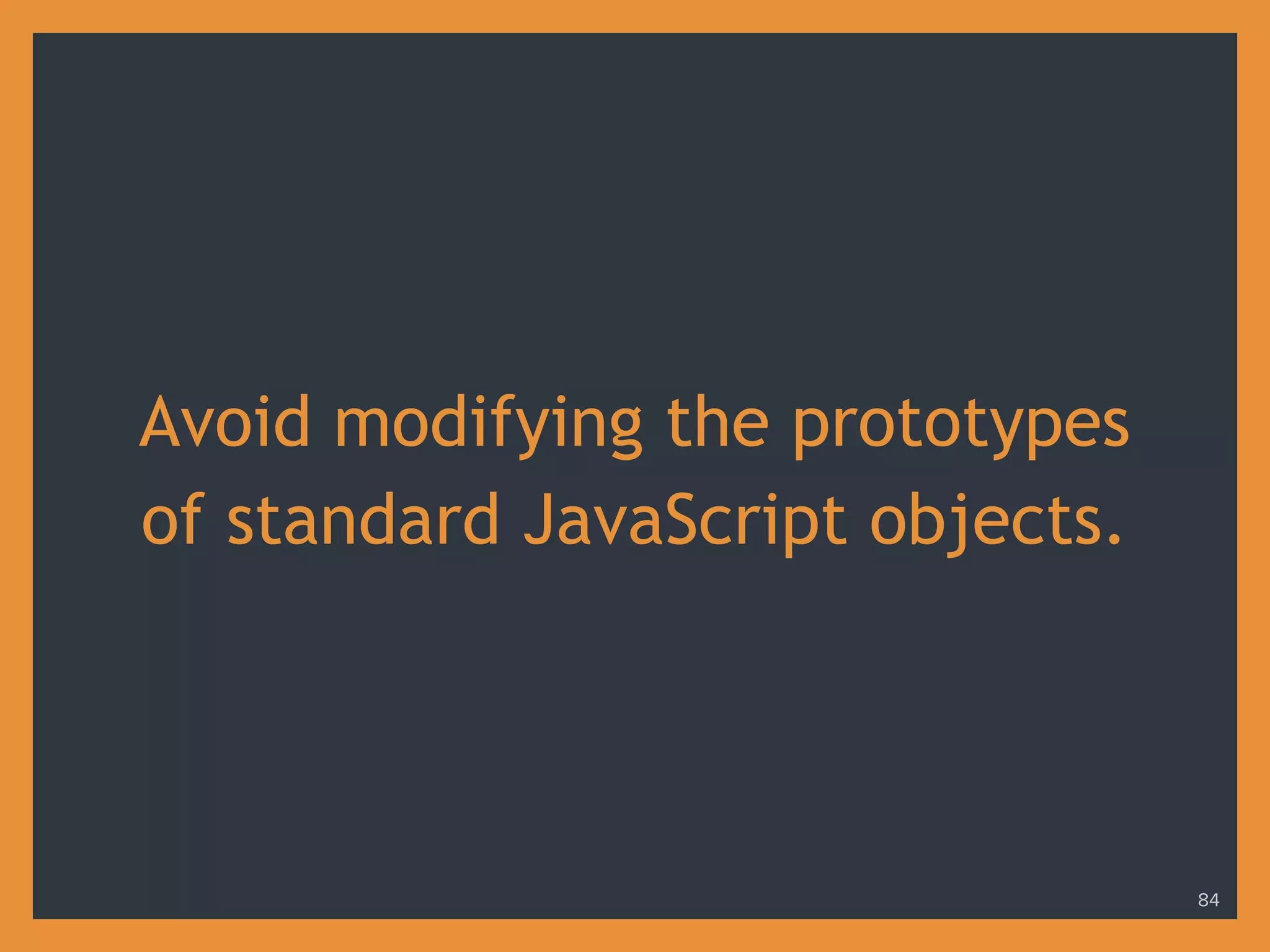
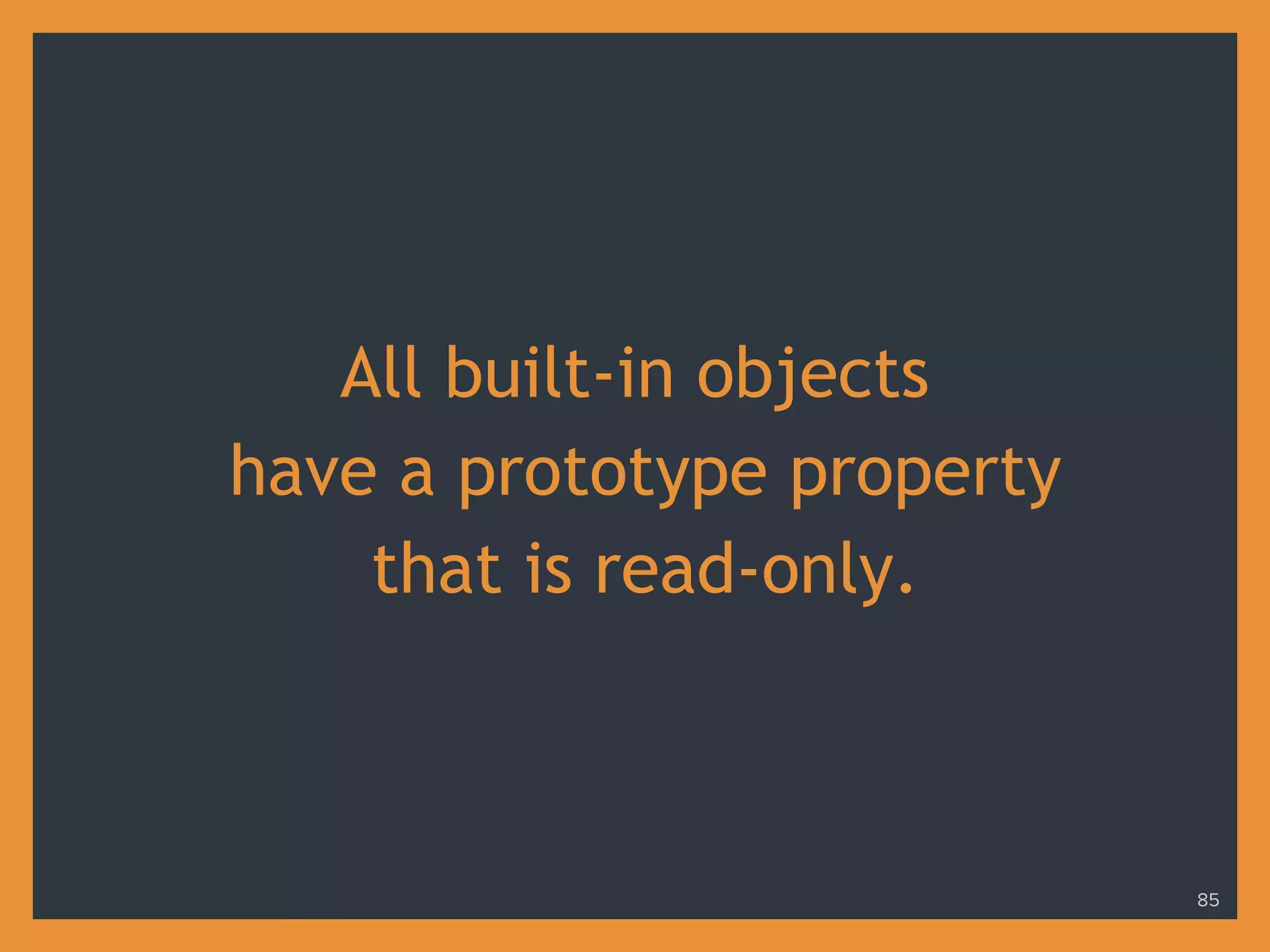
![Unconfigurable Object Prototypes 86 1. Array.prototype = { 2. first: function () { 3. return this[0]; 4. } 5. }; 6. 7. var numbers = [100, 200, 300]; 8. 9. numbers.first; // undefined 10. Object.getOwnPropertyDescriptor(Array, 'prototype'); 11. // {configurable: false, … }](https://image.slidesharecdn.com/practicaljavascriptprogramming-session3-170705052051/75/Practical-JavaScript-Programming-Session-3-8-86-2048.jpg)
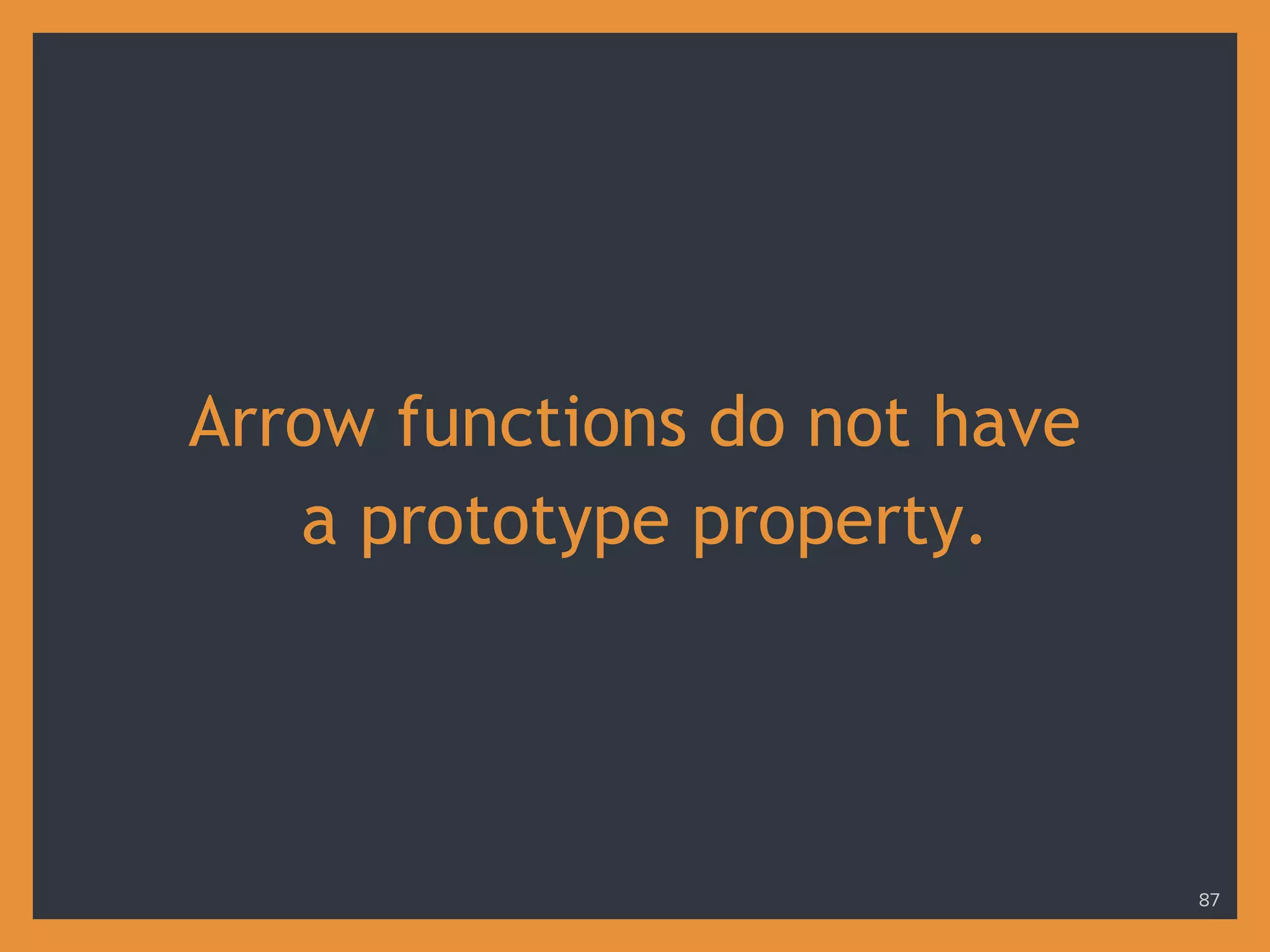
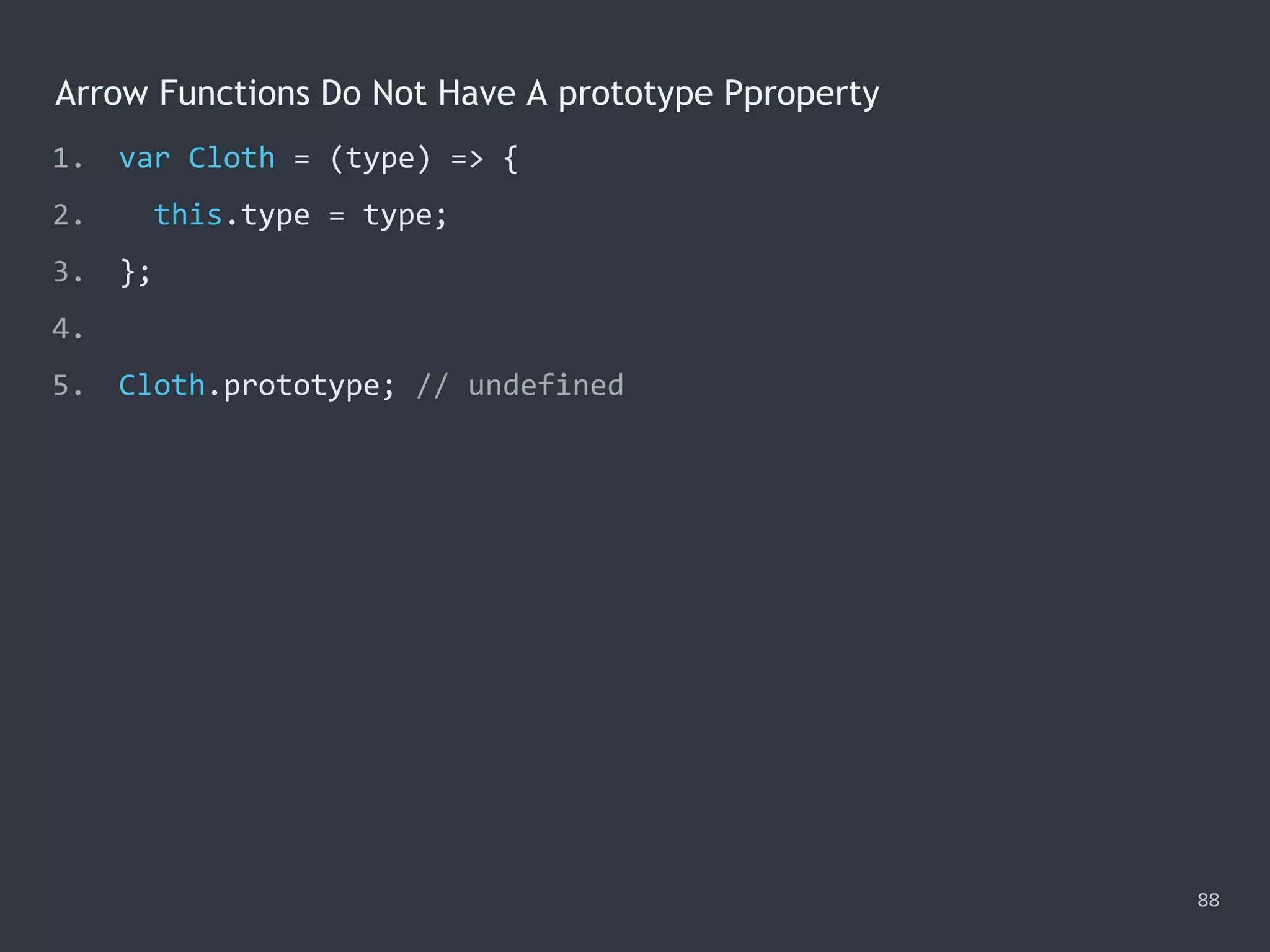

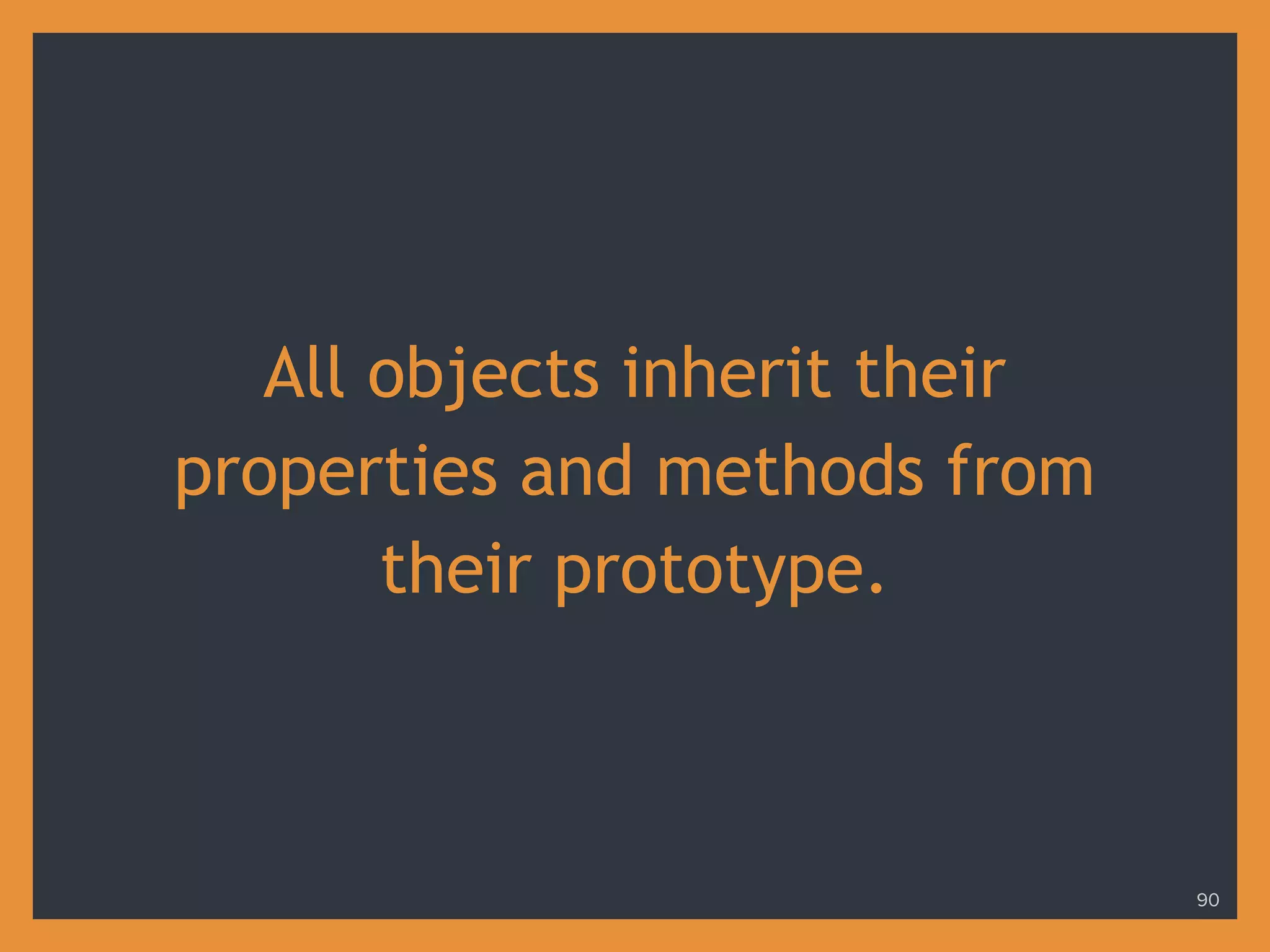
![Native Prototypes 91 1. (10).toFixed === Number.prototype.toFixed; // true 2. (true).valueOf === Boolean.prototype.valueOf; // true 3. ('A').trim === String.prototype.trim; // true 4. ({}).toString === Object.prototype.toString; // true 5. ([]).concat === Array.prototype.concat; // true](https://image.slidesharecdn.com/practicaljavascriptprogramming-session3-170705052051/75/Practical-JavaScript-Programming-Session-3-8-91-2048.jpg)
![Overriding The Native Prototypes 92 1. var empty = {}; 2. var script = { toString: () => 'Script' }; 3. var ten = { valueOf: () => 10 }; 4. 5. String(empty); // '[object Object]' 6. String(script); // ? 7. 'Java' + script; // ? 8. Number(empty); // NaN 9. Number(ten); // ? 10. ten + 20; // ? 1. var empty = {}; 2. var script = { toString: () => 'Script' }; 3. var ten = { valueOf: () => 10 }; 4. 5. String(empty); // '[object Object]' 6. String(script); // 'Script' 7. 'Java' + script; // ? 8. Number(empty); // NaN 9. Number(ten); // ? 10. ten + 20; // ? 1. var empty = {}; 2. var script = { toString: () => 'Script' }; 3. var ten = { valueOf: () => 10 }; 4. 5. String(empty); // '[object Object]' 6. String(script); // 'Script' 7. 'Java' + script; // 'JavaScript' 8. Number(empty); // NaN 9. Number(ten); // ? 10. ten + 20; // ? 1. var empty = {}; 2. var script = { toString: () => 'Script' }; 3. var ten = { valueOf: () => 10 }; 4. 5. String(empty); // '[object Object]' 6. String(script); // 'Script' 7. 'Java' + script; // 'JavaScript' 8. Number(empty); // NaN 9. Number(ten); // 10 10. ten + 20; // ? 1. var empty = {}; 2. var script = { toString: () => 'Script' }; 3. var ten = { valueOf: () => 10 }; 4. 5. String(empty); // '[object Object]' 6. String(script); // 'Script' 7. 'Java' + script; // 'JavaScript' 8. Number(empty); // NaN 9. Number(ten); // 10 10. ten + 20; // 30](https://image.slidesharecdn.com/practicaljavascriptprogramming-session3-170705052051/75/Practical-JavaScript-Programming-Session-3-8-92-2048.jpg)
